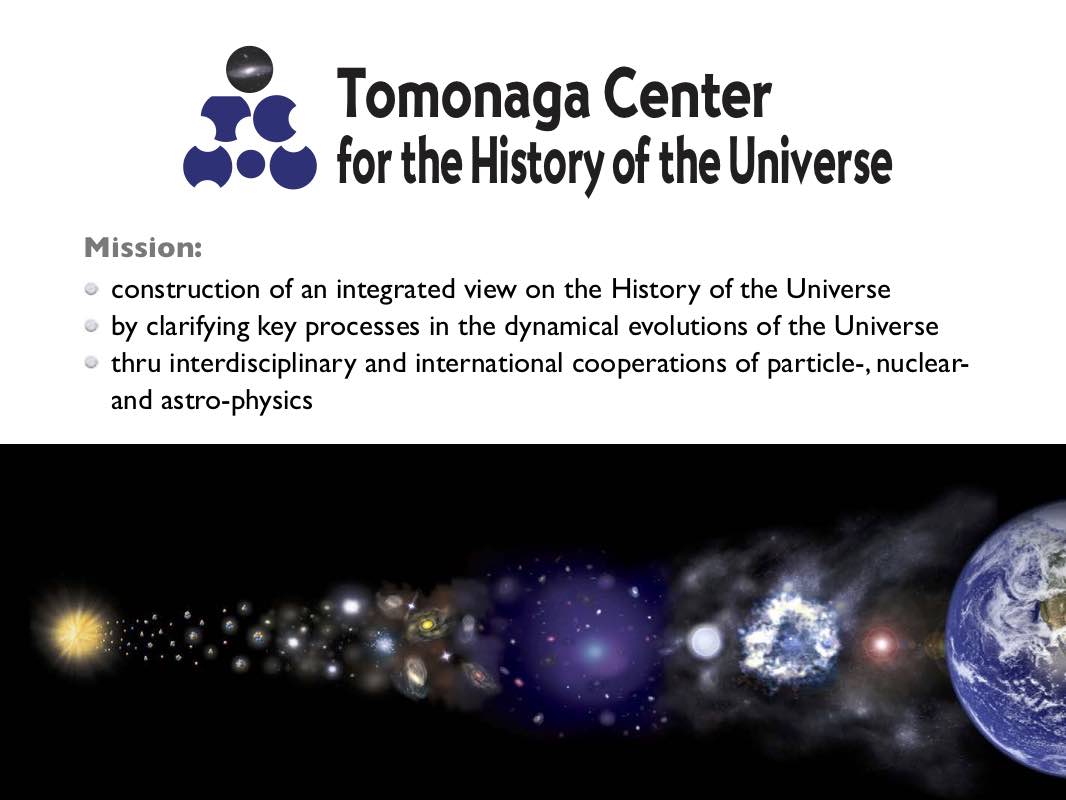Archive of Previous News and Announcements
♣ Visit the top page for the latest news and announcements.
♣ Visit job opportunities for previous public advertisements of posts.
- 2024/12/26 S. Hirose received the AAPPS-JPS Award
Assi.Prof. Shigeki Hirose (Div. of Elementary Particles) received The 3rd (2025) AAPPS-JPS Award for his experimental study of the Higgs sector using the tau lepton as a probe.
In order to promote research on Physics in the Asian region, JPS and AAPPS (Association of Asia Pacific Physical Societies) jointly award AAPPS-JPS Award for young JPS members who achieve outstanding research results in this regard.
- 2024/12/16 2nd TCHoU Research Member Meeting / Activity and Achievement Reports
We have a research workshop to share achievements, exchanging activities and future projects for all members of TCHoU.
- Date: 16 Dec 2024 (Mo)
- 9:30-10:30 Research Member Meeting, 10:30-16:25 Activity and Achievement Reports
- Venue: CRiES Advanced Accelerator Section, 3F Auditorium
- Program:
- Click on the title for the presentation slide.
- Number of participants: about 20



Contact: Prof. N. Kuno
- 2024/11/3-4 Tsukuba University Campus Festival "Sohosai" Exhibition
TCHoU made an exhibit of the Introduction to Researches at Tsukuba for the Tsukuba University Campus Festival "Sohosai", to introduce our researches toward "Unraveling the History of the Universe".
- Date: 3-4 Nov 2024
- Venue: Room 1B401, Advanced Research building-B, Univ. Tsukuba
- Title: "Unraveling the History of the Universe"


- 2024/10/04 HoU seminar
- Date: Oct. 04, 2024 (Fri) 13:45-15:00
- Venue: B118, Natural Sci. Bldg. B, Univ. Tsukuba
- Speaker: Keita Mizukoshi (JAXA/ISAS)
- Title: "Search for dark matter using a long-duration orbiting balloon in Antarctic'"
- Despite the evidence for dark matter as an unknown particle inferred from astronomical observations, its true nature remains elusive. While direct searches using xenon dual-phase detectors have yielded significant results, they are approaching the detection limit due to neutrino background events. On the other hand, indirect detection experiments are crucial as they can directly test the thermal production model of dark matter, making them complementary to other search methods. Additionally, cosmic antiparticles (such as antiprotons) originating from dark matter are expected to allow background-free searches in the low-energy region, meaning that the detection of even a single antiproton could provide critical information about the nature of dark matter.
The GAPS experiment plans to conduct its search in the upper stratosphere over Antarctica using a helium balloon, in order to avoid the effects of the atmosphere and geomagnetism. A flight lasting about one month, carrying a payload of approximately 2 tons equipped with a silicon detector array and TOF scintillators, is scheduled for this December. In this seminar, we will provide a detailed explanation of the indirect detection of dark matter, the GAPS experiment, and the unique aspects of balloon experiments. - Number of participants: 25


Contact: Assi.Prof. T. Iida
- 2024/09/30 Tsukuba Global Science Week (TGSW) 2024 "Universe Evolution and Matter Origin"
As the Session 4-1 of the Tsukuba Global Science Week, TCHoU is organizing the International Workshop on "Universe Evolution and Matter Origin" as an on-line workshop.
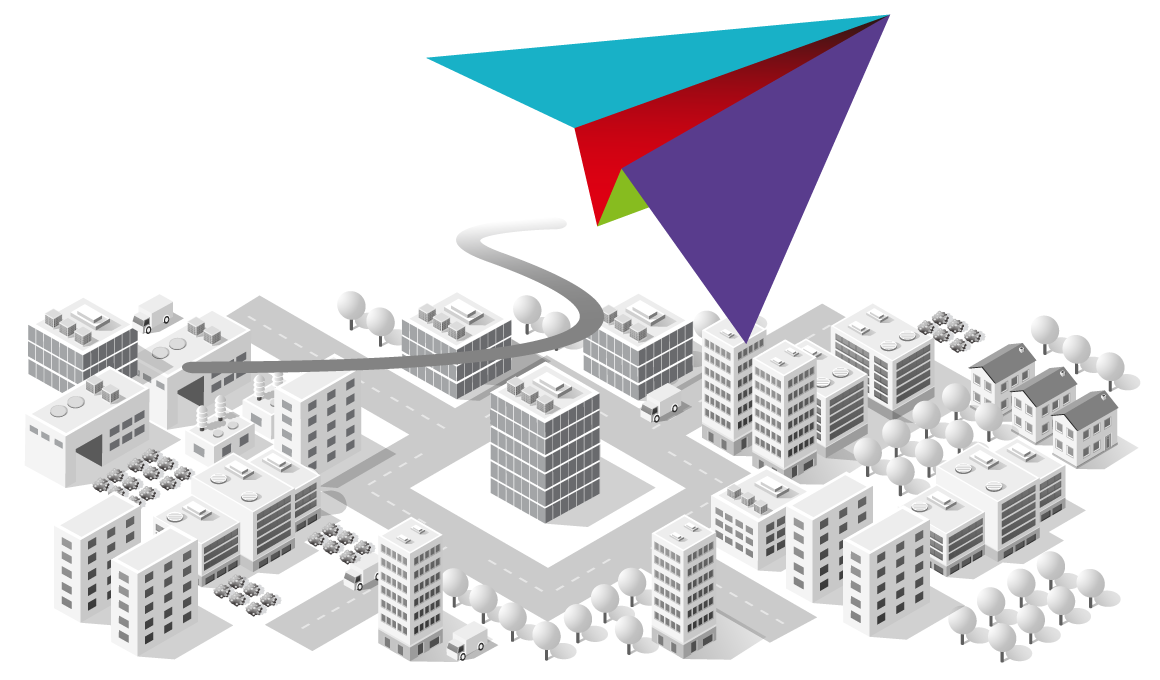
In order to answer various questions in basic natural science especially about the evolution of the universe and the origin of matter, University of Tsukuba has founded the "Tomonaga Center for the History of the Universe" (TCHoU). TCHoU includes the following four divisions; (1)Antarctic Astronomy, (2)Elementary Particles, (3)Quark Nuclear Matters, and (4)Photon and Particle Detectors. These 4 divisions are trying to cooperate together to shed light on the "dark-" matter, energy and galaxies, toward understanding the origin of matter, phase transition and structure formation as well as their fluctuation and evolution in our Universe. This session is to share the understanding of our fields and to discuss about the next step.
- Date: Sept.30, 2024 (Mon) 15:00-21:00
- Venue: Online
- URL: TGSW : Session 4-1 "Universe Evolution and Matter Origin"
- Program:
15:00-15:05 Fumihiko Ukegawa TCHoU, Univ. Tsukuba Opening 15:05-15:50 Lijuan Ruan BNL Recent results from STAR experiment at RHIC-BNL 15:50-16:35 Tetyana Galatyuk TU Darmstadt/GSI Probing cosmic forms of matter in the laboratory 16:35-17:20 Yuhu Zhang IMP Precision mass measurements of short-lived nuclei at heavy ions storage ring in Lanzhou 17:30-18:15 Wen Yin Tokyo Metropolitan Univ. Neutrino, dark matter, and new physics 18:15-19:00 Shigeki Hirose TCHoU, Univ. Tsukuba Unraveling the mysteries of the Universe through Higgs: now and future of the energy frontier 19:10-19:55 Satoki Matsushita Inst. Astronomy and Astrophysics,
Academia SinicaGreenland Telescope (GLT): Imaging the Black Hole Shadow and the Photon Ring 19:55-20:40 His-An Pan Tamkang Univ. Neutrino, dark matter, and new physics 20:40-20:50 Nario Kuno TCHoU, Univ. Tsukuba Closing - Number of participants: about 20

Please click on the title for the presentation slide.
Contact: Prof. Akira Ozawa
- 2024/09/23 HoU seminar
- Date: Sept. 23, 2024 (Fri) 11:00-
- Venue: 1F201, !st Cluster Bldg. 1F, Univ. Tsukuba / Zoom
- Speaker: Nu Xu (LBNL/IMP)
- Title: "Study of the QCD Phase Structure - Recent Results from RHIC Beam Energy Scan Program"
Contact: Prof. S. Esumi
- 2024/08/30 HoU seminar
- Date: Aug. 30, 2024 (Fri) 13:45-15:00
- Venue: B118, Natural Sci. Bldg. B, Univ. Tsukuba
- Speaker: Hiroshi IMAI (Kagoshima University)
- Title: "On the 'Stellar Water Fountains/Geysers'"
- Number of participants: 20
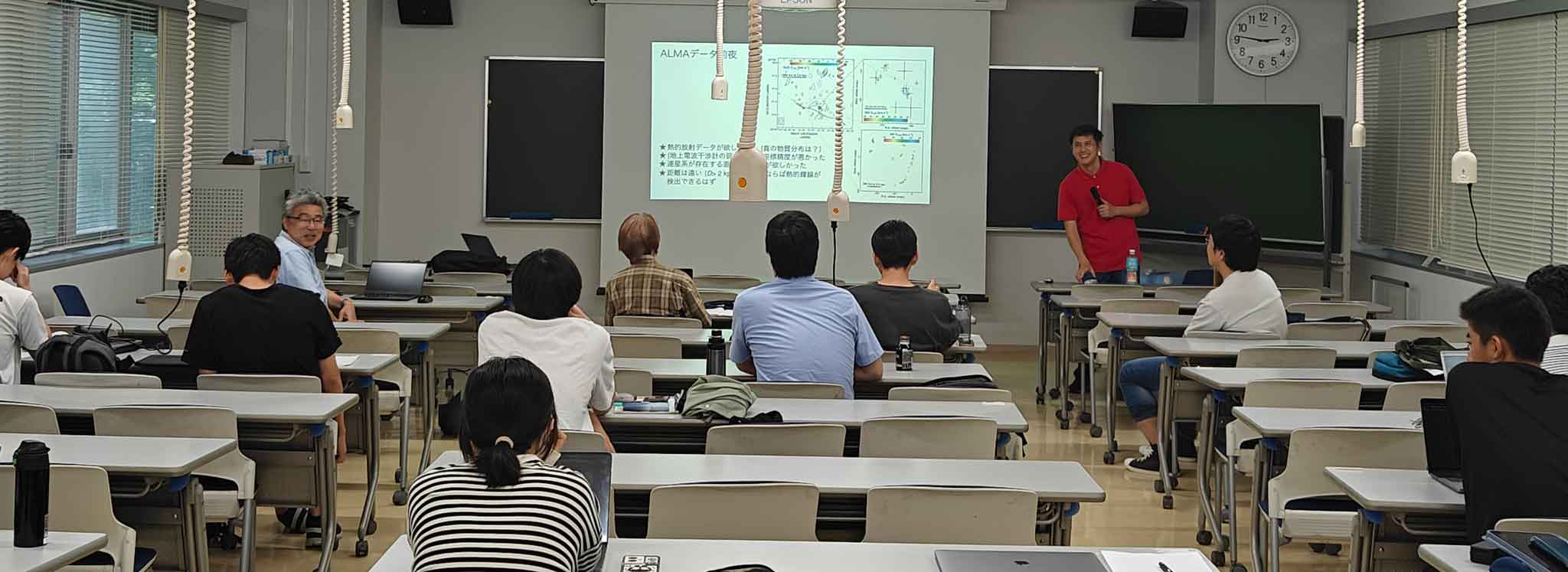
Contact: Prof. N. Kuno
- 2024/07/12 HoU seminar
- Date: Jan. 19, 2024 (fri) 13:45-15:00
- Venue: B118, Natural Sci. Bldg. B, Univ. Tsukuba
- Speaker: Ashutosh KOTWAL (Duke University, USA)
- Title: "High-precision measurement of the W boson mass with the CDF II detecto"
- The mass of the W boson, a mediator of the weak force between elementary particles, is tightly constrained by the symmetries of the standard model of particle physics. The Higgs boson was the last missing component of the model. After observation of the Higgs boson, a measurement of the W boson mass provides a stringent test of the model. We measure the W boson mass, MW, using data corresponding to 8.8 inverse femtobarns of integrated luminosity collected in proton-antiproton collisions at a 1.96 TeV center-of-mass energy with the CDF II detector at the Fermilab Tevatron collider. A sample of approximately 4 million W boson candidates is used to obtain MW=80,433.5 ± 6.4 (stat) ± 6.9 (syst) = 80,433.5 ± 9.4 MeV/c2, the precision of which exceeds that of all previous measurements combined. This measurement is in significant tension with the standard model expectation.
Contact: Prof. F. Ukegawa
- 2024/07/06 Tanabata Lecture of Astronomy
Lectures by astronomers will be held near Tanabata Day. The state-of-the-art research content will be explained in an easy-to-understand manner to the general public. (in Japanese)
Click on the poster for details.
- Date: 6 July (Saturday) 13:30-16:30
- Venue: Tsukuba International Congress Center EPOCHAL, Conference room 101
- Program:
13:30- Koji Yoshikawa (Univ. Tsukuba) Supercomputer "Fugaku" × Large-scale structure of the universe × Neutrinos 15:00- Nario Kuno (Univ. Tsukuba) Let's take a radio telescope to Antarctica! -- In search of the best sky on earth 16:30 End - Target: General public (junior high school students and above)
- Participation fee: Free
Contact: Prof. N. Kuno (TEL: 029-853-5080)
- 2024/07/04 Assi. Prof. Hashimoto made a press release on Bound star clusters 460 Myr after the Big Bang
Assistant Professor Takuya Hashimoto (Division of the Antarctic Astronomy) held a press conference on ”Bound star clusters observed in a lensed galaxy 460 Myr after the Big Bang”, published in Nature, DOI: 10.1038/s41586-024-07703-7.
For more details, see the press release article and the web announcement of the Univ. of Tsukuba.
- 2024/07/02 1st TCHoU Research Member Meeting / Activity and Achievement Reports
We have a research workshop to share achievements, exchanging activities and future projects for all members of TCHoU.
After the workshop, we have a get-together at Yasei-no-Mori. Please contact Assi.Prof. T. Iida for details.
- Date: 2 June 2024 (Tu) 9:30-17:10
- Venue: Natural Science Bldg. B114
- Program: (presentations are given mostly in Japanese)
- Click on the title for presentation slides.


Contact: Prof. F. Ukegawa
- 2024/04/21 Kids' University
At the Kids' University, Science and Technology Week, University of Tsukuba, we presented an exhibition "Pursuit of the History of the Universe" for children.

- Date: April 21 (Sun) 13:00-17:00
- Venue: B118, Bldg. Sogo-B, Univ. Tsukuba
- Admission free
- Number of participants: about 300 (incl. children: about 200)
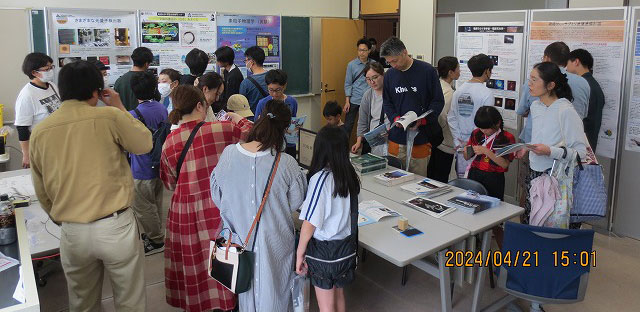
Contact: Prof. F. Ukegawa
- 2024/04/16 Member list and pamphlet of TCHoU have been updated.
- 2024/04/01 Frof. F. Ukegawa took the director of the TCHoU, and Prof. N. Kuno, the former director of TCHoU, assumed the vise dirctor of the TCHoU.
- 2024/03/29 TCHoU Workshop by the Division of Quark Nuclear Matters
We held the Workshop at the Tomonaga Center for the History of the Universe (TCHoU) in our research division for Quark-Nuclear Matters on 29/Mar/2024 (Fri) afternoon by having presentations directly related to our projects according to the following agenda program of this workshop, we would like to invite and encourage all of you to join and have active discussions in the workshop. We will have this workshop with "in-person" participation at Univ. of Tsukuba, but we will have online zoom connection as indicated in the following. So I hope to see you all in Tsukuba, but even if you will not be able to come to Tsukuba, you could still participate in online.
Thank you very much for your active participations in terms of both giving the presentations and participating in the discussions in advance and for our future fruitful cooperation and collaboration.
- Date: March 29 (Fri), 2024 13:00-16:30
- Venue: B118, Natural Sci. Bldg. B, Univ. Tsukuba
- zoom: https://us02web.zoom.us/j/87227754233?pwd=VUFzS2p4d000MjRDWXpqemlaZ2VoZz09
- Program:
-
13:00‐ Fan Si (USTC/U. Tsukuba) Fluctuation analysis in STAR-BES2 13:30- TadaAki Isobe (RIKEN) Experimental study of asymmetric nuclear matter EOS from heavy-ion reactions with RIBF-SPiRIT 14:00- Tetsuaki Moriguchi (U. Tsukuba) Reaction cross sections for proton-drip line nuclei 14:30‐15:00 coffee 15:00- Tatsuya Chujo (U. Tsukuba) ALICE FoCal and eIC 15:30- Daiki Sekihata (U. Tokyo) ALICE Run3 and ALICE3 16:00- Yorito Yamaguchi (Hiroshima U.) RHIC & LHC to FAIR - Number of participants: about 20
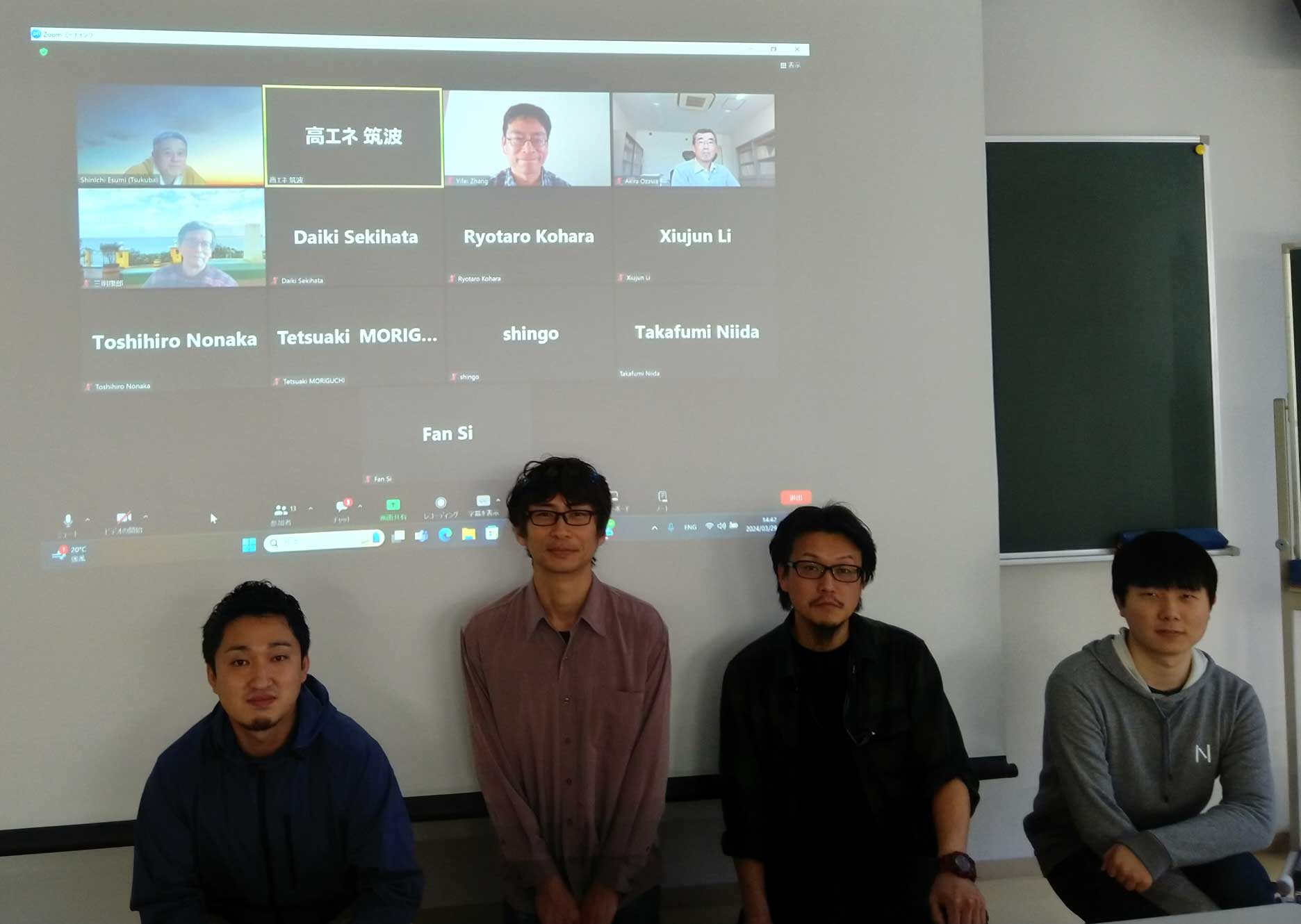
Contact: Asso.Prof. S. Esumi
- 2024/03/15 TCHoU Workshop by the Division of Elementary Particles
TCHoU Workshop of AY 2023 on Particle Physics, organized by the Division of Elementary Particles, is held as follows. This workshop is free to access. Talks are given in Japanese.
- Date: March 15 (Fri), 2024 13:30-18:00
- Venue: B118, Natural Sci. Bldg. B, Univ. Tsukuba
- Program:
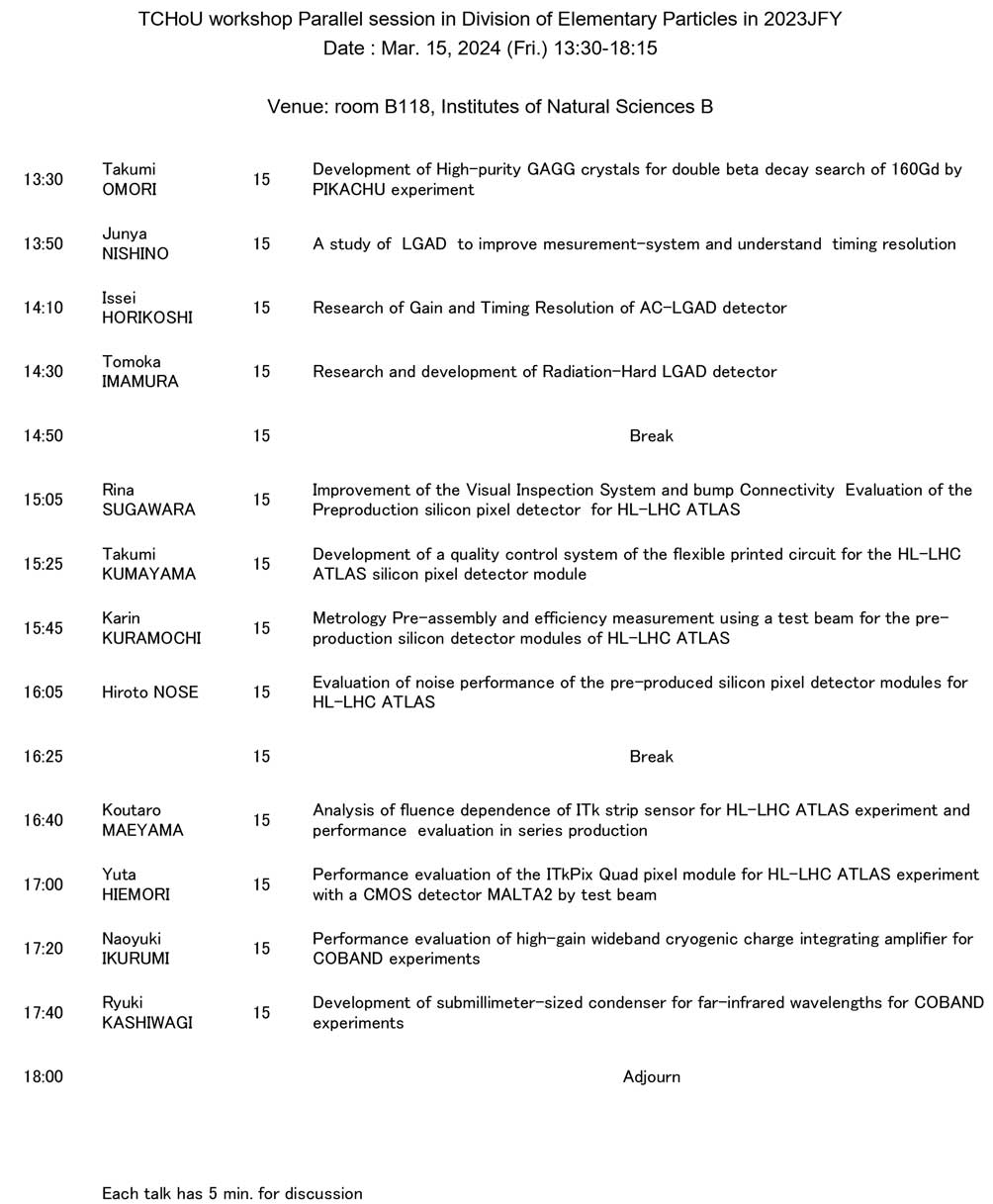
Contact: Asso.Prof. Y. Takeuchi
- 2024/02/01 Assi. Prof. Hashimoto made a press release on Molecular outflow in the reionization-epoch quasar
Assistant Professor Takuya Hashimoto (Division of the Antarctic Astronomy) held a press conference on ”Molecular outflow in the reionization-epoch quasar J2054-0005 revealed by OH 119 μm observations”, published in The Astrophysical Journal, DOI: 10.3847/1538-4357/ad0df5..
For more details, see the press release article and a web announcement of the Univ. of Tsukuba.
- 2024/01/19 HoU seminar
- Date: Jan. 19, 2024 (fri) 13:15-15:30
- Venue: B118, Natural Sci. Bldg. B, Univ. Tsukuba
- Speaker1: Tsutomu Mibe (KEK, Inst. Particle and Nuclear Studies)
- Title1: "Achievement through cooling and acceleration! New Experiment to Accurately Measure Muon g-2 and EDM"
- The anomalous magnetic moment (g-2) and electric dipole moment (EDM) of muons are powerful means of studying unknown particle physics laws, as they can manifest physics phenomena beyond the Standard Model through quantum effects. In conventional measurement methods, the quality of the muon beam constitutes a significant systematic error, and there is a demand to improve this for the next-generation experiments significantly. We have achieved an extremely low emittance "ultracold muon beam" by cooling and accelerating muons, introducing a new experimental approach that eliminates traditional limitations. This allows for the precise measurement of the anomalous magnetic moment (g-2) and electric dipole moment (EDM) of muons. In this seminar, we will provide an overview of the recent developments surrounding g-2 and introduce the preparation status of the experiment.
- Speaker2: Takayuki Yamazaki (KEK, Inst. Particle and Nuclear Studies)
- Title2: "The Past and Future of the J-PARC Muon H-Line"
- At the J-PARC high-intensity proton accelerator facility in Tokai Village, Ibaraki Prefecture, a high-intensity proton beam with an energy of 3 GeV and a beam power of 1 MW is irradiated onto a graphite target. The muons generated by the decay of charged pions produced in nuclear fragmentation reactions are utilized for a wide range of research, spanning from material science to particle physics. The J-PARC Muon Science Experimental Facility, which started operating its first beamline (D-line) in September 2008, expanded with the addition of the U-line in 2012, the S-line in 2017, and the H-line in 2022, each providing distinct muon beams. The H-line introduced in this seminar is a beamline where the world's highest-intensity positive and negative pulse muons are available. In the experimental area at the first branching point (H1 area), fundamental physics experiments requiring high-intensity muon beams, such as precision spectroscopy of muonium (a hydrogen-like atom composed of a positive muon and an electron) and exploration experiments of muon-electron conversion processes, are conducted. Furthermore, the construction of the second branching point in the H-line is underway to generate an "ultracold muon beam" with extremely low emittance through muon cooling and reacceleration. This ultracold muon beam is not only applicable to muon g-2/EDM experiments but is also used in the transmission-type muon microscope (TμM), enabling the observation of thick samples. In this seminar, we will provide an overview of the J-PARC Muon H-line, its construction history, and prospects for the future.
- Number of participants: on-site 17 + online 6


Contact: Assi.Prof. T. Iida
- 2023/12/18 TCHoU Research Member Meeting / Activity and Achievement Reports
We had a research workshop to share achievements, exchanging activities and future projects for all members of TCHoU.
- Date: 27 June 2023 (mon) 9:00-17:00
- Venue: B114, Natural Science Bldg. B, Univ. Tsukuba
- Program:
- Click on the title for presentation slides.
- Number of participants: about 30
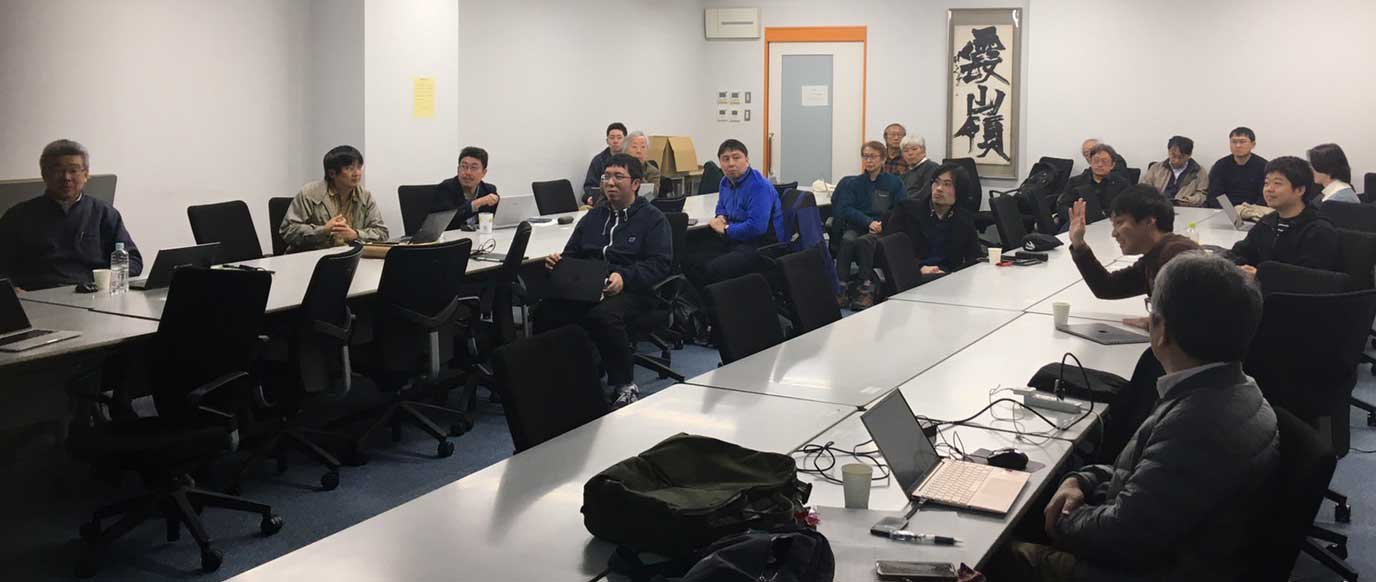



Contact: Prof. S. Esumi
- 2023/11/29 HoU seminar
- Date: Nov. 29, 2023 (wed) 13:30-14:30
- Venue: B118, Natural Sci. Bldg. B, Univ. Tsukuba
- Speaker: Baltasar Vila-Vilaro (ALMA Observatory)
- Title1: "Properties of the ISM of Spiral Galaxies along the Hubble Sequence"
- The properties of the atomic and molecular ISM of normal spiral galaxies along the Hubble sequence will be reviewed. Special emphasis will be placed on trends of some specific tracers of the molecular ISM as a function of Hubble type, and their implications. Results of several recent single-dish surveys of the molecular ISM in nearby spiral galaxies will be presented.
Contact: Assi.Prof. T. Iida
- 2023/11/21 HoU seminar
- Date: Nov. 21, 2023 (tue) 16:00-17:00
- Venue: 1F201, Bldg. 1F of Area 1, Univ. Tsukuba
- Speaker: Prof. Dr. Qiye Shou (Fudan University)
- Title: "Recent activities of the ALICE Shanghai group"
- Joining the LHC-ALICE experiment since 2019, Fudan University (Shanghai group) is one of the four institutes in China. Our current physics interests are primarily on the study of exotic phenomena and matters. In this talk, first I'll generally introduce the group, and then summarize some of the research highlights we have achieved in recent years, including the charge dependent correlations, femtoscopic correlations, and the study of the hypertriton. The future plans to contribute to ALICE and promote collaborations with international colleagues will be discussed as well.
Qiye Shou is a tenured associate professor at Fudan University. He received his Doctor of Science degree in 2015 from the Shanghai Institute of Applied Physics (SINAP). After completing the postdoctoral research at CCNU and serving as an assistant professor at SINAP, he joined Fudan University in 2019. His primary research focuses on heavy-ion collisions, studying the properties of the Quark-Gluon Plasma (QGP), such as anomalous chiral effects, collectivity and exotic particles. He has previously worked on the RHIC-STAR experiment and currently works on the LHC-ALICE, serving as the (deputy) leader of the ALICE Shanghai group, the flow PAG coordinator and the contact person of the China T2 cluster.
Contact: Prof. S. Esumi
- 2023/11/17 HoU seminar
- Date: Nov. 17, 2023 (fri) 13:15-15:00
- Venue: B118, Natural Sci. Bldg. B, Univ. Tsukuba
- Speaker1: Katsuro Nakamura (KEK, Inst. Particle and Nuclear Studies)
- Title1: "Exploring New Physics at the Belle II experiment"
- One of the main goals of the Belle II experiment is to explore new physics beyond the Standard Model of particle physics. The Belle II experiment started full-scale data acquisition 2019 and has already collected 424fb^-1 of data, which have been used for the study of the decays of B mesons, D mesons, tau leptons and the search for the dark sector. This presentation will provide an overview of the Belle II experiment, covering the performance of the detectors and data acquisition, as well as presenting the latest analysis results.
- Speaker2: Takashi Mori (KEK, Accelerator Laboratory)
- Title2: "Challenges of unprecedented beam collision performance with SuperKEKB accelerator"
- SuperKEKB is a collider with a circumference of 3 km, located 11 meters below the ground level. Electrons and positrons are accelerated to the energies of 7 billion and 4 billion electron volts, respectively, in a linear accelerator and they are injected into two circular rings in opposite directions. A figure of merit for accelerator performance is described by “luminosity” (L), the collision frequency of particles. The KEKB accelerator, the accelerator that preceded SuperKEKB, reached the world record of L=2.11×1034cm-2s-1, and the target L of SuperKEKB is 6×1035cm-2s-1. To reach the target value, “nano-beam scheme” was adopted to SuperKEKB for the first time in the world in addition to the beam current increase in design, and extreme fine beam operation has been being performed. In this seminar, we will introduce the general features of SuperKEKB first, and then describe the individual accelerator components and challenges. Furthermore, we will talk about the prospects of the SuperKEKB upgrade.
- Number of participants:about 20


Contact: Assi.Prof. T. Iida
- 2023/11/4-5 Exibition at Campus Festival "Soho-Sai" of Univ. of Tsukuba
An exposition introducing the research activities of the Tomonaga Center was made at the Campus Festival "So-Ho Sai" of the Univ. of Tsukuba.
- Date: 4(Sun)-5(Mon) Nov 2023
- Venue: 3B401, Univ. Tsukuba
- Thema: "Clarification of the History of Universe"



- 2023/10/14 Y. Imamura received Student Presentation Award of the Physical Society of Japan
Master Course student Yuka Imamura, supervised by Asso.Prof. Y. Takeuchi, Dr. K. Hara, and Assi.Prof. K. Nakamura (KEK) (Div. of Elementary Particles), received the Student Presentation Award of the Physical Society of Japan for his presentation at the 78th annual meeting of JPS at Sendai.
- "Research and development of Radiation-Hard LGAD detector"
- 2023/10/14 T. Omori received Student Presentation Award of the Physical Society of Japan
Master Course student Takumi Omori, supervised by Assi.Prof. T. Iida (Div. of Elementary Particles), received the Student Presentation Award of the Physical Society of Japan for his presentation at the 78th annual meeting of JPS at Sendai.
- "Double Beta Decay Search for Gd-160 by PIKACHU Experiment 5 - Development and performance evaluation of the high purity GAGG crystal for PIKACHU experiment -"
See also TSUKUBA JOURNAL of the Univ. Tsukuba.
- 2023/09/29 HoU seminar
- Date: Sept. 29, 2023 (fri) 13:45-15:15
- Venue: B114, Natural Sci. Bldg. B, Univ. Tsukuba
- Speaker: Sotaro Kanda (KEK)
- Title: "Precise measurements using muons: from spectroscopy to interferometry"
- The muon is a subatomic particle classified as a second-generation charged lepton, possessing the same charge, -e, and spin 1/2 as an electron. It is 200 times heavier than an electron and is an unstable particle decaying with an average lifetime of 2.2 microseconds. While it is applied as a local magnetic probe in materials and life science, its intrinsic properties are an intriguing subject of particle physics. In pursuing physics beyond the Standard Model, precise measurements and searches of rare processes involving muons have yielded important results. A significant factor behind this is the improvement in beam intensity due to advancements in accelerator technology. The pulsed muon beam at J-PARC MLF MUSE achieves the world's highest intensity, enabling numerous experiments previously deemed challenging. Precision measurements using a high-intensity pulsed beam require improvement in particle detectors and beam cooling techniques. This talk will discuss muon precision measurements using high-intensity beams, specifically the spectroscopy of atomic systems involving muons, a new measurement of the muon lifetime, and muonium interferometry with beam cooling.
- Number of participants:about 20


Contact: Assi.Prof. T. Iida
- 2023/09/28 Tomonaga Center Intanational Workshop "Origin and Evolution of the Universe, Matter and Life"
The international workshops was held as an event commemorating the 50th anniversary of University of Tsukuba. In addition to introducing the activities of the center, we invited people who are active in related fields in Japan and overseas to give lectures.
- Date: Sept. 28, 2023 (thu) 09:30-17:00
- Venue: International Conference Room, University Hall, University of Tsukuba
- URL: https://hep-www.px.tsukuba.ac.jp/TCHoU/symposium2023/
- Program: (Click on the title for presentation slides.)
10:00-10:05 Yasuteru SHIGETA (Vice President,
Univ. Tsukuba)Opening Address 10:05-10:10 Nario KUNO (Director, TCHoU) Introduction to TCHoU 10:10-10:20 Yuji TAKEUCHI (TCHoU) Division of Elementary Particles 10:20-10:30 ShinIchi ESUMI (TCHoU) Division of Quark Nuclear Matters 10:30-10:40 Nario KUNO (TCHoU) Division of Antarctic Astronomy 10:40-10:50 Akira OZAWA (TCHoU) Division for Development of Photon and Particle Detectors 11:00-11:40 Nami SAKAI (RIKEN, Japan) Quest to understand the chemical origin of the Solar System 11:45-12:30 C. S. LIM (Phys. Soc. Japan) The physics of neutrinos: Dirac vs. Majorana 14:00-14:40 Takashi KOBAYASHI (KEK/JAEA, Japan) Particle and nuclear physics at J-PARC 14:45-15:25 Paul HO (EAO, Taiwan) Imaging of black hole shadow from the Arctic region 15:50-16:30 Paolo GIUBELLINO (GSI, Germany) The Universe in the lab: current and future science at GSI/FAIR 16:35-17:15 Nigel LOCKYER (Cornell Univ., USA) Accelerators: What they are good for 17:20-17:35 Fumihiko UKEGAWA (TCHoU) Closing remarks - Number of participants: 47
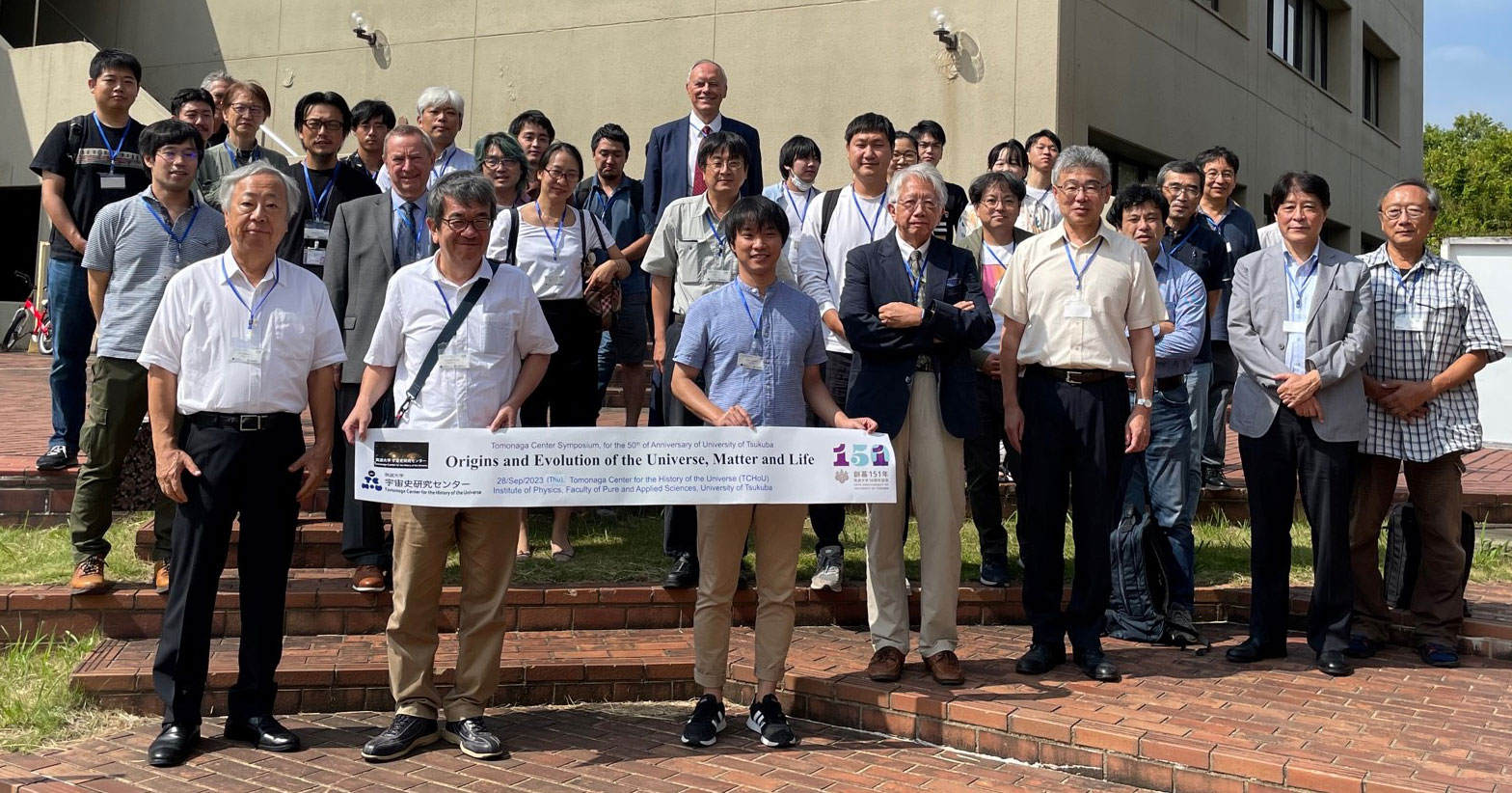


Contact: Prof. N. Kuno
- 2023/09/20 Assi. Prof. Hashimoto made a press release on the most distant cluster of primordial galaxies
Assistant Professor Takuya Hashimoto (Division of the Antarctic Astronomy) held a press conference ”The Strongest Tag Team of the James Webb Space Telescope and ALMA Telescope Succeeded in Capturing the Most Distant Cluster of Primordial Galaxies” at the 2023 Fall Meeting of the Astronomical Society of Japan.
For more details, see the press release article and a web announcement of the Univ. of Tsukuba.
- 2023/08 Assi. Prof. S. Honda received URSI GASS 2023 Young Scientist Award
Assistant Professor Shunsuke Honda (Division of Antarctic Astronomy) received the URSI GASS 2023 Young Scientist Award at the XXXVth URSI General Assembly and Scientific Symposium, Sapporo, Hokkaido, Japan, 19 - 26 August 2023, by the International Union of Radio Science, for his papar "Commissioning Observations in 2022 with 100-GHz MKID Camera at Nobeyama 45-m Telescope"

- 2023/08/08 N. Suzuki received Excellent Poster Award of SMART2023
Doctor Course student Naoki Suzuki, supervised by Assi.Prof. T. Iida (Div. of Elementary Particles), received the Excellent Poster Award at SMART2023, in which developments and applications of radiation detectors are discussed.
See also TSUKUBA JOURNAL of the Univ. Tsukuba.
- 2023/08/03 HoU seminar
- Date: Aug. 3, 2023 (thu) 15:15-16:30
- Venue: B114, Natural Sci. Bldg. B, Univ. Tsukuba
- Speaker: Masao YOSHINO (Tohoku Univ.)
- Title: "Radiation detectors and radiation imaging using single-crystal scintillators"
- Scintillators convert radiation into UV to visible light. They play an essential role as sensor heads in radiation detectors in underground particle experiments and in the field of high-energy physics. This talk focuses in particular on inorganic scintillator single crystals, such as oxides and halides, and describes the scintillation properties imparted by their crystal growth methods and growth processes. Furthermore, the latest trends in scintillation detectors in recent years will be discussed.
- Number of participants: about 20


Contact: Assi.Prof. T. Iida
- 2023/07/08 Tanabata Lecture of Astronomy
Lectures by astronomers will be held near Tanabata Day. The state-of-the-art research content will be explained in an easy-to-understand manner to the general public. (in Japanese)
Click on the poster for details.
- Date: 9 July 13:30-16:30
- Venue: Tsukuba International Congress Center EPOCHAL, Conference room 101
- Program:
13:30- Toshiki Saito (National Astronomical Observatory of Japan) All galaxies are a lion at home and a mouse abroad ~The true appearance of the galaxy revealed by large radio telescope~ 15:00- Hidenobu Yajima (Univ. Tsukuba) Histroy of universe approaching with super computer 16:30 End - Target: General public (junior high school students and above)
- Participation fee: Free (max. 130 people)
Contact: Prof. N. Kuno (TEL: 029-853-5080, e-mail: kuno.nario.gt [at] u.tsukuba.ac.jp)
- 2023/07/04 Assi. Prof. Hashimoto made a press release on turbulent ionized gas and potential stellar feedback 600 million years after the Big Bang
Assistant Professor Takuya Hashimoto (Division of the Antarctic Astronomy) held a press conference on ”The 300 parsec resolution imaging of a z = 8.31 galaxy: Turbulent ionized gas and potential stellar feedback 600 million years after the Big Bang”, published in The Astrophysical Journal, DOI: 10.3847/1538-4357/acd637.
For more details, see the press release article and a web announcement of the Univ. of Tsukuba.
- 2023/07/06 Assi.Prof. Iida received "2023 Japan Isotope Association Incentive Award"
As announced by our news of 2023/03/03, Takashi Iida, Assistant Professor at TCHoU, received the 2023 Japan Isotope Association Incentive Award on 6 July at the 60th meeting of the Japan Isotope Association for his contribution to the advancement of particle science through the development of detection methods for weak radiation.
Title: "Advancement of Detection System for the Study of Extremely Rare Decays of 48Ca"


See also TSUKUBA JOURNAL of the Univ. Tsukuba.
- 2023/06/27 TCHoU Research Member Meeting / Activity and Achievement Reports
We had a research workshop to share achievements, exchanging activities and future projects for all members of TCHoU.
- Date: 27 June 2023 (Tu) 9:30-17:30
- Venue: Natural Science Bldg. B114 (morning) / Sogo-B Bldg. B0110 (afternoon)
- Program: (presentations are given mostly in Japanese)
09:30-10:15 KUNO, Nario Report of activities of TCHoU Hereafter, presentations are open for public. 10:30-11:00 IIDA, Takashi Double beta decay search for 160Gd by the PIKACHU experiment 11:00-11:30 AKIYAMA, Shinichiro Critical endpoint of (3+1)-dimensional finite density Z3 gauge-Higgs model with tensor renormalization group 11:30-12:00 SHIBATA, Kazuki Relationship between gas dynamics and star formation activity in barred spiral galaxies 12:00-13:00 lunch 13:00-13:30 SUZUKI, Hisanori TCAD simulation studies of radiation damage to the ATLAS SCT detector 13:30-14:00 ANDO, Yuji Recent developments of string field theory 14:00-14:30 OKUBO, Kosuke RHIC Beam Energy Scan and Vorticity 14:30-15:00 MAWATARI, Ken Challenge to the Most Distant Evolved Galaxies: Hint on Star- Formation Activity during the First 500 Million Years of the Cosmic History 15:00-15:20 break 15:20-15:50 GUERNANE, Rachid (Grenoble) ALICE upgrades for LHC Run 4 and beyond 15:50-16:20 SATO, Koji Recent Results from the ATLAS Experiment 16:20-16:50 OHNISHI, Tetsuya (RIKEN) Current status of large scale experiments at RIBF towards nuclear synthesis 16:50-17:20 TSUNETOE, Yuh (CCS) Investigating the Accretion Disk-Jet Structure around a Supermassive Black Hole through Polarization Images 17:20-17:35 UKEGAWA,Fumihiko Closing remarks 18:00- Banquet @ 1A cafeteria TSUKUBA TABLE - Click on the title for presentation slides.




- Number of participants: about 30
Contact: Prof. N. Kuno
- 2023/05/27 Open lecture "History of the Universe"
We explained the history of the universe of 13.8 billion years for high school students. We also introduced the research being conducted at the Tomonaga Center, University of Tsukuba.
- Date: 27, 28 May 2023
- Venue: 7A105, Kasuga campus, University of Tsukuba
- Program:
27 May (Sat) 13:30-14:30 Prof. K. Ohsuga Evolution of universe and black hole 14:45-15:45 Prof. F. Ukegawa Elementary particle mass and Higgs boson 16:00-17:00 Asso.Prof. Y. Takeuchi Challenge to cosmic neutrinos 28 May (Sun) 13:30-14:30 Prof. S. Esumi QGP phase transition in the early universe 14:45-15:45 Prof. N. Kuno Birth and evolution of stars and galaxies - Number of participants: 32
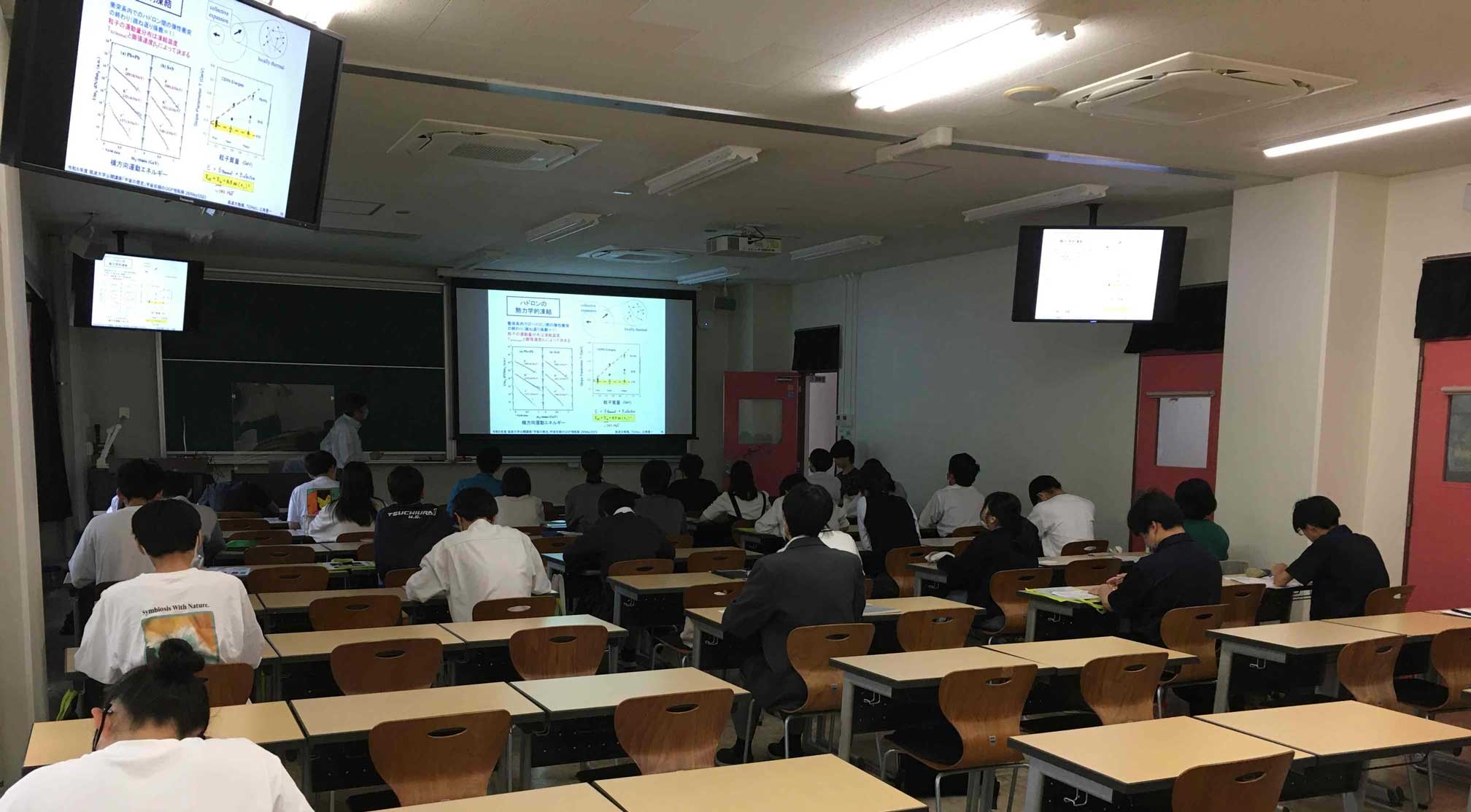
Contact: Prof. N. Kuno
- 2023/05/20 The member list was updated.
- 2023/05/12 HoU seminar
- Date: May 12, 2023 (fri) 13:45-15:00
- Venue: B118, Natural Sci. Bldg. B, Univ. Tsukuba
- Speaker: Takasumi MARUYAMA (KEK)
- Title: "Search for a new neutrino oscillation with a short baseline"
- Since the 1990s, the existence of neutrinos which cannot be explained by the Standard Model (sterile neutrinos) has been indicated. This indication originated from an experiment conducted in the United States called LSND, which claimed to have observed neutrino oscillations at short distances that cannot occur through standard neutrino oscillations. However, for these 20 years, no definitive results have been obtained regarding the existence of these neutrinos.
- Under these circumstances, the JSNS2 experiment being conducted at the J-PARC Materials and Life Science Experimental Facility in Ibaraki Prefecture aims to directly test LSND's observations without any excuses. The experiment has already collected data during the long-term physics runs in 2021 and 2022, and this presentation will report the progress of the data collection, calibration, and analysis. Additionally, the physics of neutrinos other than sterile neutrino searches and their analysis status will also be presented in this talk. Furthermore, as the next upgrade, a new far detector is being built at twice the distance of the current detector in the MLF outdoor area, and its progress will also be introduced.
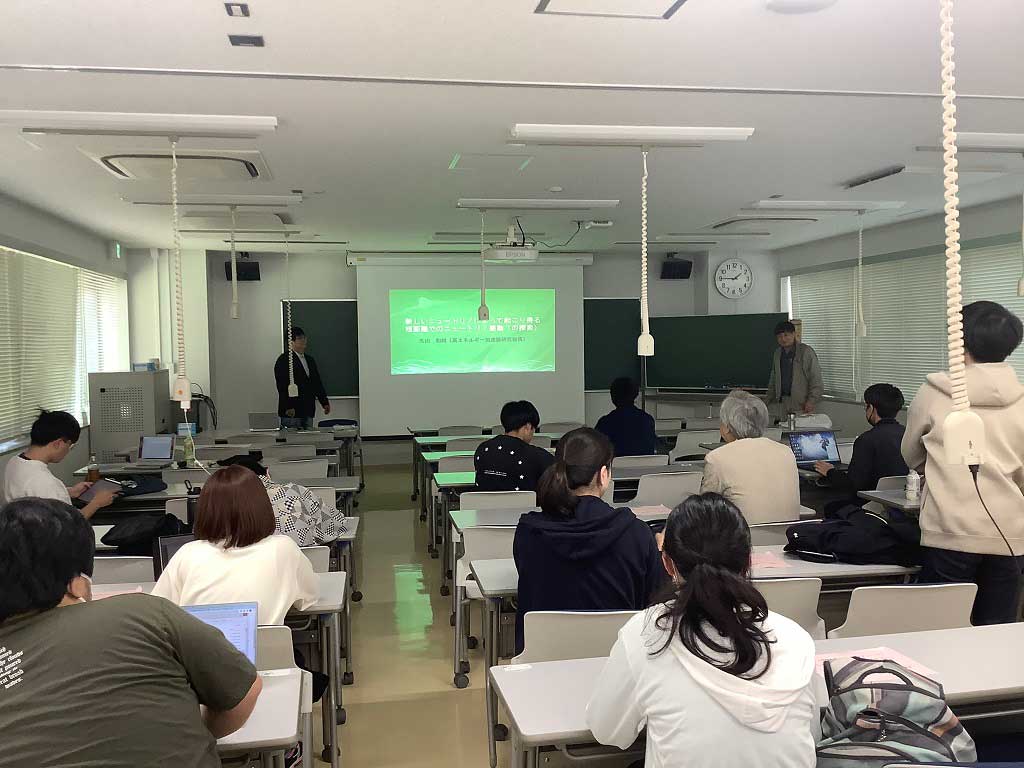
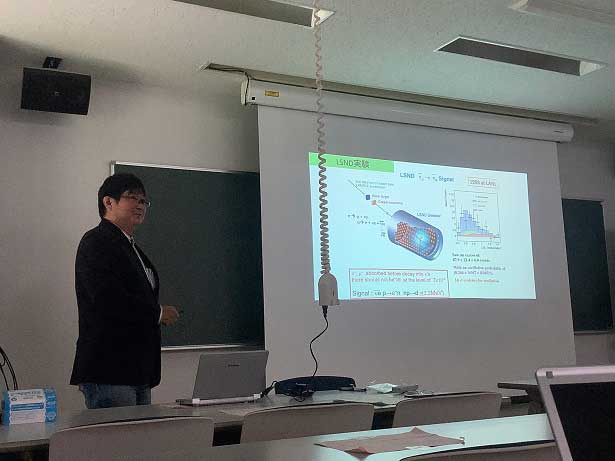
- Number of participants: 24
Contact: Asso.Prof. Y. Takeuchi
- 2023/04/29-30 International Workshop on Highly Baryonic Matter at RHIC-BES and Future Facilities --- beyond the Critical Point towards Neutron Stars --- (WHBM 2023)

- Date: 29-30 Apr 2023
- Venue: Rooms 1D201, 1D204, Building 1D, Univ.Tsukuba
- URL: https://conference-indico.kek.jp/event/205/
- Contact: whbm2023-loc _AT_ ml.cc.tsukuba.ac.jp
- Workshop on Highly Baryonic Matter at RHIC-BES and Future Facilities --- beyond the Critical Point towards Neutron Stars --- (WHBM 2023) will take place in Univ. of Tsukuba at Tsukuba, Ibaraki as a satellite conference of ATHIC2023, focused specially on High Density Physics topics covering Critical Point, QCD Phase Diagram, Flow, Correlations, Fluctuations, Chirality, Vorticity, Hadron interactions, Hypernuclei, Equation of State and Neutron Stars.
Contact: Prof. S. Esumi
- 2023/04/24-27 The 9th Asian Triangle Heavy-Ion Conference (ATHIC 2023)
- Date: 24-27 Apr 2023
- Venue: JMS Aster Plaza, 4-17 Kakomachi, Naka-ku, Hiroshima, Japan
- URL: https://indico.cern.ch/event/1176274/
- Contact: athic23-loc _AT_ ml.hiroshima-u.ac.jp
- The 9th Asian Triangle Heavy-Ion Conference (ATHIC 2023) will be held in Hiroshima for high energy heavy-ion physics to investigate and discuss Quark Gluon Plasma, especially on Initial state and thermal equilibrium, Jets and medium response, Heavy quarks and quarkonia, Electromagnetic probes, Collective dynamics, Correlations and fluctuations, QCD phase diagram and extreme states, QGP in small systems, Intense field and vorticity, Hadron interactions and exotics.
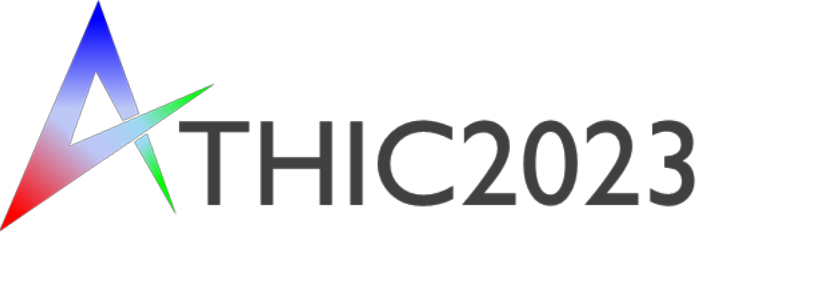
- 2023/03/24 Ryota Ura received the Dean's Award of the Graduate School of Pure and Applied Sciences, Univ. of Tsukuba
A master student, Ryota Ura, supervised by Assistant Professor Takuya Hashimoto (Division of the Antarctic Astronomy), received the Dean's Award of the Graduate School of Pure and Applied Sciences at the degree conferment ceremony in 2022. His research results were published by Astrophysical Journal.
- 2023/03/17 Workshop on Photon and Particle Detectors
Workshop on Photon and Particle Detectors of AY2022, organized by the Photon and Particle Detectors Division of TCHoU, will be held. The workshop will be on-site (recommended) with a zoom connection available.
- Date: March 17 (Fri), 2023 13:00-16:00
- Venue: Room B118, Natural Sci. Bldg. B, Univ. Tsukuba
- Program:

- Number of participants: 32 (including 10 remote participants)
The symposium counted in total 32 participants (including 10 remote participants) and nine talks were presented from the nuclear experiment, astronomy and particle experiment groups. The discussions were active prolonging the scheduled symposium time by nearly one hour. For the participant from abroad, the presentations were conducted in English. Although the students had sometime difficulties in explanation, the symposium should have been a good experience for them, and the symposium itself was very fruitful.
Contact: Asso.Prof. K. Hara
- 2023/03/16 Workshop by the Division of Elementary Particles
TCHoU Workshop of AY 2022 on Particle Physics, organized by the Division of Elementary Particles, is held as follows. This workshop is free to access.
- Date: March 16 (Fri), 2023 13:30-16:00
- Venue: zoom online
- Program:
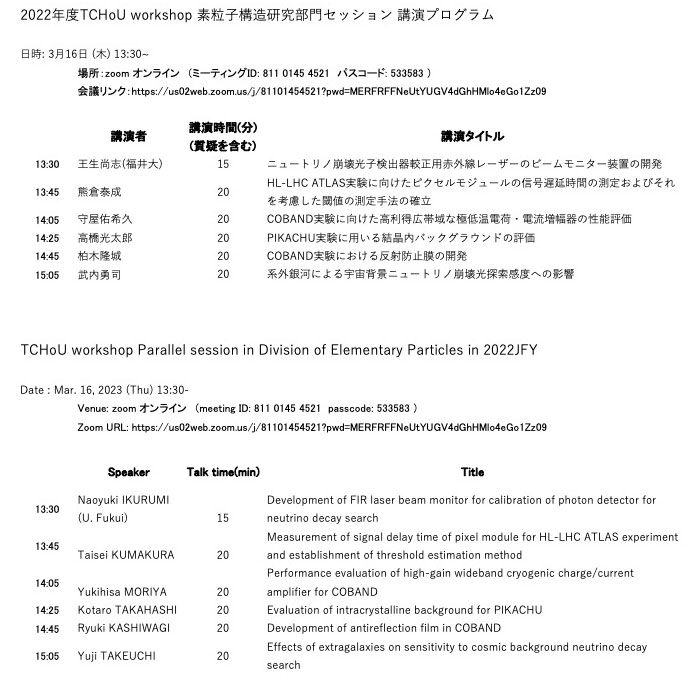
Contact: Asso.Prof. Y. Takeuchi
- 2023/03/13-15 2nd International Workshop on Forward Physics and Forward Calorimeter Upgrade in ALICE
Following topics will be discussed at the workshop:
- Forward physics at high energy in pp, p-A, AA, e-p, e-A collisions/li>
- Initial condition of high energy heavy ion collisions at LHC and RHIC
- Thermalization mechanism, strong fields
- Small-x physics, gluon PDF, saturation and Color Glass Condensate (CGC)
- Forward detector upgrade using Si-W calorimeter and hadron calorimeter at LHC
- related detector technologies and upgrade projects in other fields
- Date: March 13-15, 2023
- Venue: Univ. Tsukuba
- URL: https://indico.cern.ch/event/1235107/
- Program: https://indico.cern.ch/event/1235107/timetable/#all.detailed
- Invited speakers (in alphabetical order):
-
Ian Gardner Bearden (University of Copenhagen)
Christophe De La Taille (OMEGA)
Hirotsugu Fujii (University of Tokyo)
Takahiro Fusayasu (Saga University)
Yuji Goto (RIKEN)
Tetsufumi Hirano (Sophia University)
Kensuke Homma (Hiroshima University)
Motoi Inaba (Tsukuba University of Technology)
Tommaso Isidori (University of Kansas)
Peter Martin Jacobs (Lawrence Berkeley National Lab.)
Minho Kim (RIKEN)
Youngil Kwon (Yonsei University)
Artur Lobanov (Hamburg University)
Hiroaki Menjo (Nagoya University)
Sanjib Muhuri (Department of Atomic Energy)
Takafumi Niida (University of Tsukuba)
Yasunori Osana (University of the Ryukyus)
Hidetoshi Otono (Kyushu University)
Ken Oyama (Nagasaki Inst. of Applied Science)
Thomas Peitzmann (Utrecht University, University of Tsukuba)
Dieter Roehrich (University of Bergen)
Taikan Suehara (Kyushu University)
Daniel Tapia Takaki (University of Kansas)
Ton Van Den Brink (Nikhef)
Marco Van Leeuwen (Nikhef, CERN, University of Tsukuba)
Kazuhiro Watanabe (Seikei University)
Contact: Asso.Prof. T. Chujo (LOC)
- 2023/03/24 HoU seminar
- Date: Mar. 8, 2023 (wed) 13:30-15:00
- Venue: B118, Natural Sci. Bldg. B, Univ. Tsukuba
- Speaker: Osamu TAJIMA (Kyoto University)
- Title: "CMB++"
- Observing “decoupled” objects is an experimental approach for understanding the begin of the universe as well as the origin of the matters. Cosmic microwave background (CMB) is the oldest light which we can detect, and its precise observations have given us knowledge about origin of the universe and matters. Improved measurements of the CMB polarization are currently hot research topic. In particular, it is expected that spatial patterns of the CMB polarization provides us a smoking-gun evidence for the cosmic inflation as well as new knowledge about the neutrino mass. In this seminar, I present status and prospects of ground-based CMB experiments: Simons Observatory and GroundBIRD.
- Dark matter is another decoupling object while we have not established its detection method yet. We recently started a unique project to explore light, i.e., low mass (0.05-0.1 meV/c^2), dark matter by using the technologies established in the CMB experiments. I will also present its recent results and ambitious ideas in future.
- Number of participants: about 20
Contact: Prof. F. Ukegawa
- 2023/03/03 Assi.Prof. Iida received "2023 Japan Isotope Association Incentive Award"
Takashi Iida, Assistant Professor at TCHoU, has received the 2023 Japan Isotope Association Incentive Award for his contribution to the advancement of particle science through the development of detection methods for weak radiation.
Title of the research achievement: "Advancement of Detection System for the Study of Extremely Rare Decays of 48Ca"
The award will be given during the 60th meeting of the Japan Isotope Association in July 2023.
- 2023/03/01 Assi.Prof. Iida received "2022 Konica Minolta Imaging Science Encouragement Award"
Takashi Iida in TCHoU received the 2022 Konica Minolta Imaging Science Encouragement Award in recognition of his research on a new scintillation detector for particle identification using wavelength information.


- 2023/02/24 HoU seminar
- Date: Feb. 24, 2023 (fri) 13:45-15:00
- Venue: B118, Natural Sci. Bldg. B, Univ. Tsukuba
- Speaker: Yoshikazu NAGAI (ELTE Univ., Hungary)
- Title: "Hadron Production Measurements for Neutrino Experiments at NA61/SHINE"
- In current measurements of accelerator-based neutrino experiments, neutrino flux uncertainties represent a leading systematic uncertainty. Neutrino beams are created from the decays of secondary hadrons produced in hadron-nucleus interactions. The leading source of flux uncertainty is the primary and secondary hadron production processes for neutrino beams. Therefore, precise hadron production measurements are essential.The neutrino program of the NA61/SPS Heavy Ion and Neutrino Experiment (NA61/SHINE) at CERN’s Super Proton Synchrotron makes measurements of hadron production.
- This talk will first present recent hadron production measurements for precise neutrino flux predictions needed by T2K and Fermilab long-baseline neutrino experiments. The talk will then review the performance of the latest collected data with the upgraded NA61/SHINE facility. Lastly, the talk will discuss the prospects for near future hadron production measurements in NA61/SHINE, including the possibility to extend the physics program to lower beamline energies.
Contact: Assi.Prof. T. Iida
- 2023/02/08 Press Release "Identification of Radiation Particles Using Information on the Wavelength of Scintillation Light"
A press release was issued on the results of "Research on a new particle identification method using the information on the wavelength of scintillation light emitted by scintillators", in which Assistant Professor Takashi Iida of TCHoU serves as a representative.
See press release document (in Japanese) for details.
- 2022/11/28 TCHoU Research Member Meeting / Activity and Achievement Reports
We have a research workshop to share achievements, exchanging activities and future projects for all members of TCHoU.
- Date: 28 Nov 2022 (Mo)
- Venue: Natural Science Bldg. B114 at Univ. Tsukuba (+ zoom online meeting)
- Program: (presentations are given mostly in Japanese)
- Number of participants: 43 (incl. remote 24)
- Click on the title for the presentation slide.

Contact: Asso.Prof. K. Hara
- 2022/10/31 HoU seminar
- Date: Oct. 31, 2022 (mon) 17:00-18:00
- Venue: B118, Natural Sci. Bldg. B, Univ. Tsukuba
- Speaker: Assi.Prof. Hidetoshi Otono (Kyushu Univ.)
- Title: "Status of the FASER experiment"
- The FASER experiment is a new experiment that is being placed 480 meters downstream of the ATLAS experiment at the CERN LHC. FASER is designed to discover dark photons and other light and very weakly-interacting particles that are produced in the far-forward region, outside of the ATLAS detector acceptance. FASER would also directly detect collider neutrinos for the first time and study their cross sections at TeV energies, where no such measurements currently exist. The experiment has been successfully constructed and installed, already starting data acquisition since the beginning of LHC Run 3 in 2022. This talk will present the physics prospects, detector design, and early data analysis of FASER.
Contact: Prof. F. Ukegawa
- 2022/10/24-28 31st International Workshop Vertex2022
The International Workshop on Vertex Detectors (VERTEX) is a major annual series of international workshops for physicists and engineers from the high energy and nuclear physics community. VERTEX provides an international forum to exchange the experiences and needs of the community, and to review recent, ongoing, and future activities on silicon based vertex detectors. The workshop covers a wide range of topics: existing and future detectors, new developments, radiation hardness, simulation, tracking and vertexing, electronics and triggering, applications to medical and other fields
Vertex2022 is cohosted by TCHoU. Asso.Prof. K. Hara, Div. Photon and Particle Detectors, TCHoU, is a member of the IAC and is chairing the LOC of this Workshop.
- Date: Oct. 24-28, 2022
- Venue: on-site at Tateyama Resort Hotel, Tateyama, Japan
- URL: https://indico.cern.ch/event/vertex2022
Visit the workshop web site for details.
A report on the wworkshop is available here, and a report for HEPNews (in Japanese) is here.
Contact: Asso.Prof. K. Hara
- 2022/10/14 Sayuka Kita received the Student Presentation Award of the Physical Society of Japan
Sayuka Kita, master course student of the particle experiment group in TCHoU, received the Student Presentation Award of the Physical Society of Japa for "A study of the new LGAD detector (AC-LGAD) for the finer pitch electrode," presented in the autumn meeting of JPS 2022(award recipient list for 2022/autumn). This was her second award since 2021/autumn.
In accelerator experiments, precision measurements of the reaction point and emerging particle tracks are a key to determine what kind of interaction is involved. For precision measurement of the particle properties or discovery of new particles, more reactions are required and hence the particle density increases substantially. Development of the precision particle detector operational in such environments is a of prime issue for future high precision experiments. Conventionally this has been achieved by minimizing the detector electrode size. A group of experimental particle physics group in which Ms Kita is involved, led by Division leader K. Hara and collaborative member K. Nakamura (KEK) of the Photon and Particle Division, adopts LGAD - semiconductor diode with internal gain - which is superior in timing determination, to realise a 4D detector capable of precision determination of both position and time. For minimizing the electrode size of the LGAD, the group is investigating AC-coupled electrodes, and her presentation is on the development research of such device, AC-LGAD.
- 2022/09/27 Tsukuba Global Science Week (TGSW) 2022 "Universe Evolution and Matter Origin"
As the Session 5-9 of the Tsukuba Global Science Week, TCHoU is organizing the International Workshop on "Universe Evolution and Matter Origin" as an on-line workshop.
- Date: Sept.28, 2022 (Sat) 12:15-21:10
- Venue: Online Zoom meeting (will be accounced to the registered participants)
- URL: TGSW / Session 5-9
- Program: program
Early Afternoon Session (Chair: Fumihiko Ukegawa) 12:50-13:00 Nario Kuno TCHoU, Univ. Tsukuba Opening 13:00-13:30 Tai Oshima NAOJ Probing the distant universe with the wide field of view sub-millimeter camera 13:30-14:10 Yuji Takeuchi TCHoU, Univ. Tsukuba R&D of Hf-STJ as FIR single-photon spectrometer for COBAND 14:10-14:40 Kazuyuki Kanaya TCHoU, Univ. Tsukuba Critical point in heavy-quark QCD at finite temperature Late Afternoon Session (Chair: ShinIchi Esumi) 15:20-15:50 Yuma Sugahara Waseda Univ. / NAOJ Emission line modeling of galaxies at Cosmic Dawn 15:50-16:30 Yong-Hamb Kim Center for Underground Phys., Inst. Basic Sci. 0νββ Searches with Low-Temperature Thermal Calorimeters 16:30-17:00 Sheng-Cai Shi Purple Mountain Observatory, Chinese Academy of Sci. Development of THz Astronomy in China 17:00-17:40 Joachim Stroth Frankfurt Univ. / GSI Exploring the phase structure of QCD matter at high baryo-chemical potential with HADES and CBM Evening Session (Chair: Kazuhiko Hara) 18:10-18:50 Tatsuya Masubuchi Univ. Tokyo 10th Anniversary of the Higgs Boson Discovery ―What we learned in a decade― 18:50-19:20 Kate Pattle University College London The Cold Universe: Science Highlights from the SCUBA-2 Camera 19:20-20:00 Giuseppe Iacobucci Univ. Geneve Next generation silicon pixel detectors: towards picosecond timing 20:00-20:40 Jiangyong Jia Stony Brook Univ. / BNL Imaging the nuclear structure and the initial condition of heavy ion collisions across nuclear chart 20:40-20:50 Fumihiko Ukegawa TCHoU, Univ. Tsukuba Closing - Number of participants: 68 (registered: 192名)
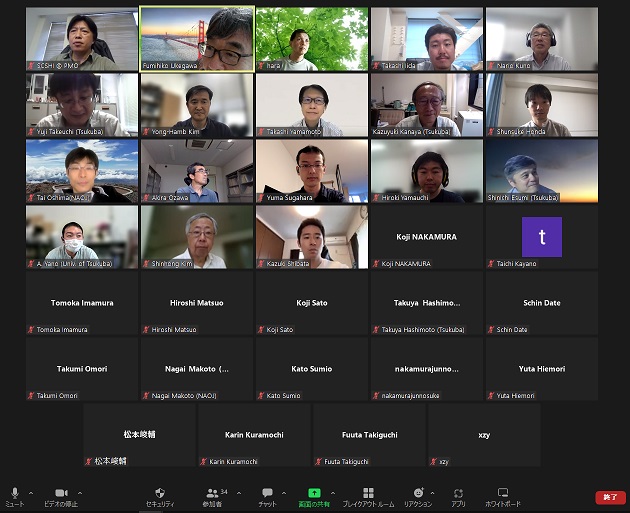
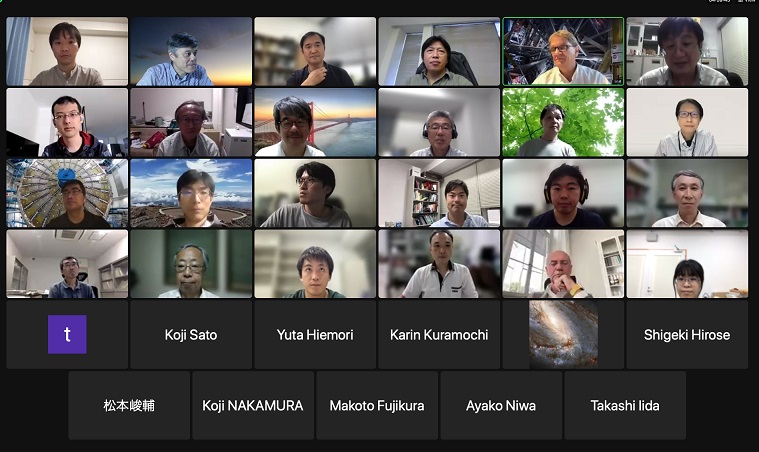
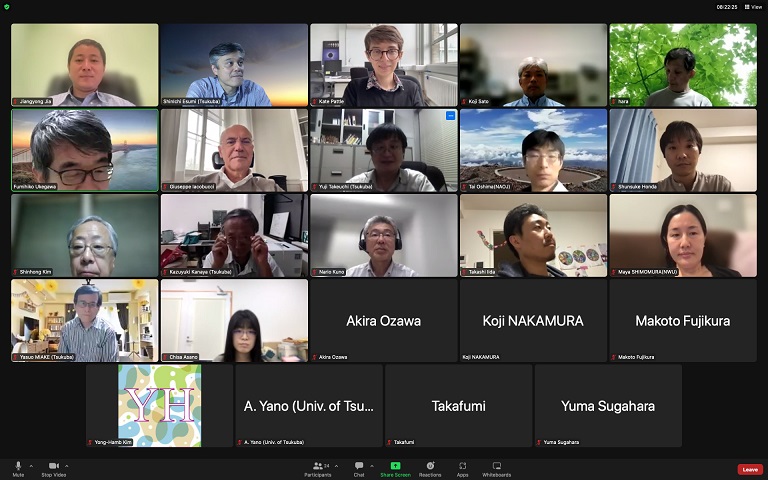
Please click on the title for the presentation slides (in Japanese).
Contact: Prof. Yuji Takeuchi
- 2022/08/01 HoU seminar
- Date: Aug. 1, 2022 (mon) 14:00- (about one hour)
- Venue: 1F201, 1st cluster, Univ. of Tsukuba + zoom online meeting
- Speaker: Prof. Nu Xu (LBNL)
- Title: "Recent Results from RHIC Beam Energy Scan and Future Perspectives of Physics at High Baryon Density"
- In this talk, I will present recent results from the successful beam energy scan program carried out at the RHIC. The focus will be given on the latest new data from 3 GeV Au+Au collisions. The implications on collectivity, the search for QCD critical point and hyper-nuclei production will be discussed. Finally I will address the opportunities for studying nuclear matter EOS at high baryon density with the CBM experiment at FAIR.
The on-sie lecture room may be changed depending on the number of on-site participants. In case you want to participate on site, please inform the convener no later than about one week before the seminar.
Contact: Prof. S. Esumi (esumi.shinichi.gn [at] u.tsukuba.ac.jp)
- 2022/7/9 Tanabata Lecture of Astronomy
Lectures by astronomers will be held near Tanabata Day. The state-of-the-art research content will be explained in an easy-to-understand manner to the general public. (in Japanese)
Click on the poster for details.
- Date: 9 July 13:30-16:30
- Venue: zoom online meeting
- Program:
13:30- Mariko Nomura (National Institute of Technology (KOSEN), Kure College) The mystery of a supermassive black hole approaching with numerical simulation 15:00- Shuro Takano (Nihon University) See the matter in space with a radio telescope! -Across astronomy, physics, and chemistry- 16:30 End - Target: General public (junior high school students and above)
- Participation fee: Free (Internet communication fee is your own expense)
- Participation application: Please apply from the following URL by the day before.
- https://forms.office.com/r/vp3AERnPb4
Please click on the title for the presentation slides (in Japanese).
Contact: Prof. N. Kuno (TEL: 029-853-5080, e-mail: kuno.nario.gt [at] u.tsukuba.ac.jp)
- 2022/06/24 TCHoU Research Member Meeting / Activity and Achievement Reports
We have a research workshop to share achievements, exchanging activities and future projects for all members of TCHoU. Reports on main achievements in each field in FY 2021 are presented.
- Date: 24 Jun 2022 (Fr)
- Venue: Natural Science Bldg. B114 at Univ. Tsukuba + zoom online meeting
- Program: (presentations are given mostly in Japanese)
- Number of participants: 38
- Click on the title for the presentation slide.
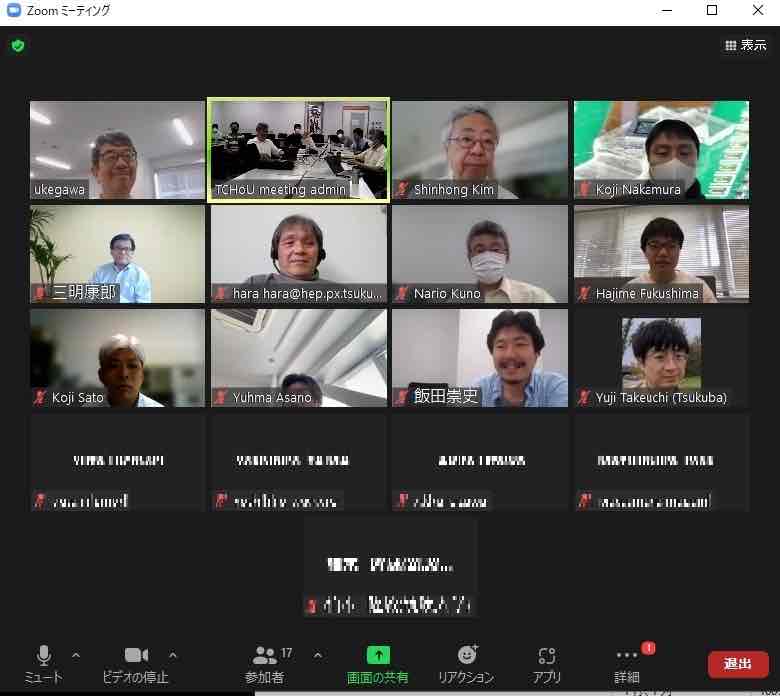


Contact: Asso.Prof. Y. Takeuchi
- 2022/5/28 Open lecture "History of the Universe"
We explained the history of the universe of 13.8 billion years for high school students. We also introduced the research being conducted at the Tomonaga Center, University of Tsukuba.
- Date: 28, 29 May 2022
- Venue: 7A105, Kasuga campus, University of Tsukuba
- Program:
28 May (Sat) 13:30-14:30 Prof. M. Umemura Big bang cosmology 14:45-15:45 Asso.Prof. K. Hara Elementary particle mass and Higgs boson 16:00-17:00 Asso.Prof. Y. Takeuchi Challenge to cosmic neutrinos 29 May (Sun) 13:30-14:30 Prof. S. Esumi QGP phase transition in the early universe 14:45-15:45 Prof. N. Kuno Birth and evolution of stars and galaxies - Number of participants: 26
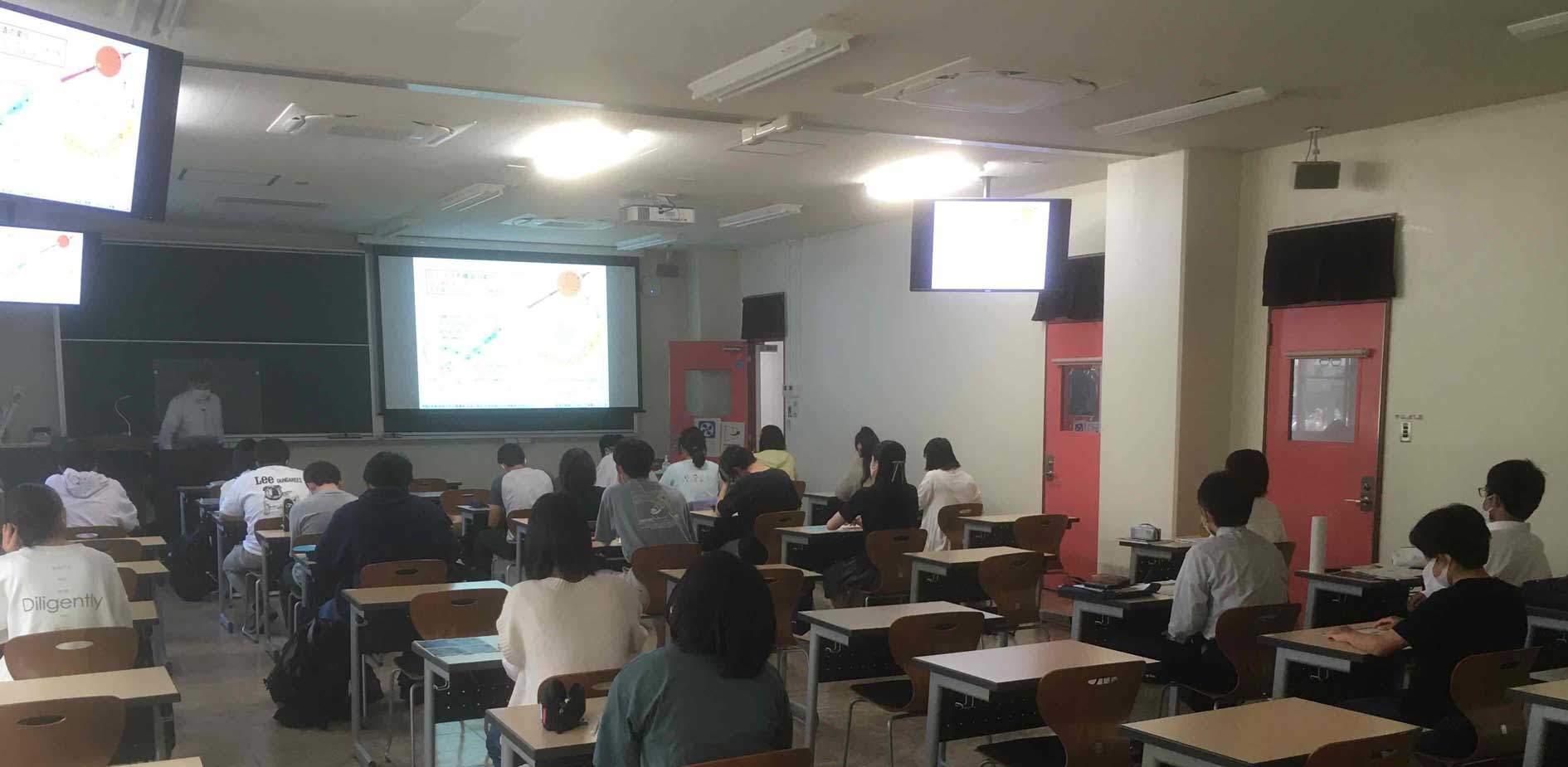
Contact: Asso.Prof. Y. Takeychi
- 2022/5/27 HoU Seminar
We have an TCHoU-HET-HEP Joint seminar on the CDF experiment about the W boson mass, introduced in our News on 8 Apr 2022.
- Date: 27 May 2022 (Fri) 13:45-15:00
- Venue: zoom online meeting
- Talk 1:
- Fumihiko Ukegawa (Univ. of Tsukuba)
- "The history of the CDF experiment and its early physics results, and how we detect the W boson"
- The CDF experiment at the Fermilab proton-antiproton collider started under the US-Japan Accord, which was initiated by the Fukuda-Carter dialog in 1978. After its construction in early 1980s, CDF recorded the first collisions in 1985, experienced a pilot run in 87, a first physics run in 88-89, and a substantial physics run (Run-I) in 92-96. Through the period, CDF, as an energy-frontier particle physics experiment, produced many important physics results such as the discovery of the top quark. In this talk we review the history of the experiment and explain the method to detect and measure the production and decays of the W boson.
- Talk 2:
- Koji Sato (Univ. of Tsukuba)
- "High Precision W Boson Mass Measurement with the CDF Detector"
- Tevatron is a proton-antiproton collider located at Fermi National Accelerator Laboratory in the United States of America. The CDF Experiment collected 8.8 /fb of proton-antiproton collision data during the Run II of the Tevatron operation from 2002 through 2011. The CDF Collaboration analyzed the full Run II data and obtained the measured W boson mass of 80.433.5 +/- 9.4 MeV/c^2. In this talk, we review this new W mass measurement released on April, 2022, whose precision surpasses that of the previous world average. This measurement is in tension with the Standard Model expectation.
- Number of participants: 50
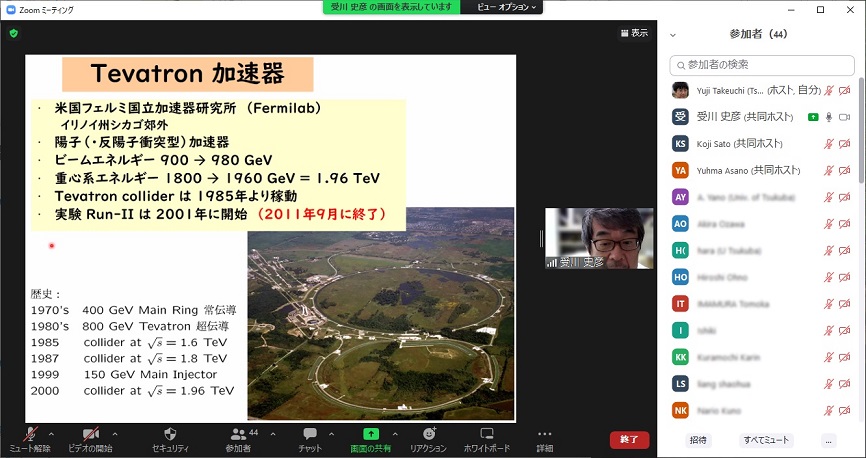
Please click on the title for the presentation slides (in Japanese).
Contact: Asso.Prof. Y. Takeuchi (takeuchi [at] hep.px.tsukuba.ac.jp), Assi.Prof. Y. Asano (asano [at] het.ph.tsukuba.ac.jp)
- 2022/04/08 CDF experiment made the most precise measurement of the mass of the W boson, a carrier of the weak force
The CDF Collaboration, in which many members of the Div. of Elementary Particles, TCHoU, are taking an important part, has now measured the mass of the W boson with the best precision ever by an experiment at the Fermi National laboratory (Fermilab) in the United States. The W boson, along with the Z boson, acts as the carrier of the weak force between elementary particles. By determining its mass very precisely, coupled with information on the masses of other particles such as the top quark and the Higgs boson, one can test the standard theory of elementary particles. The new measurement shows a significant difference from the prediction of the Standard Theory of particles, at a level of seven standard deviations [Science vol.376, issue 6589, pp.125, 2022/4/7]
Visit https://hep-www.px.tsukuba.ac.jp/news/W-mass-2022/ for details (in Japanese).

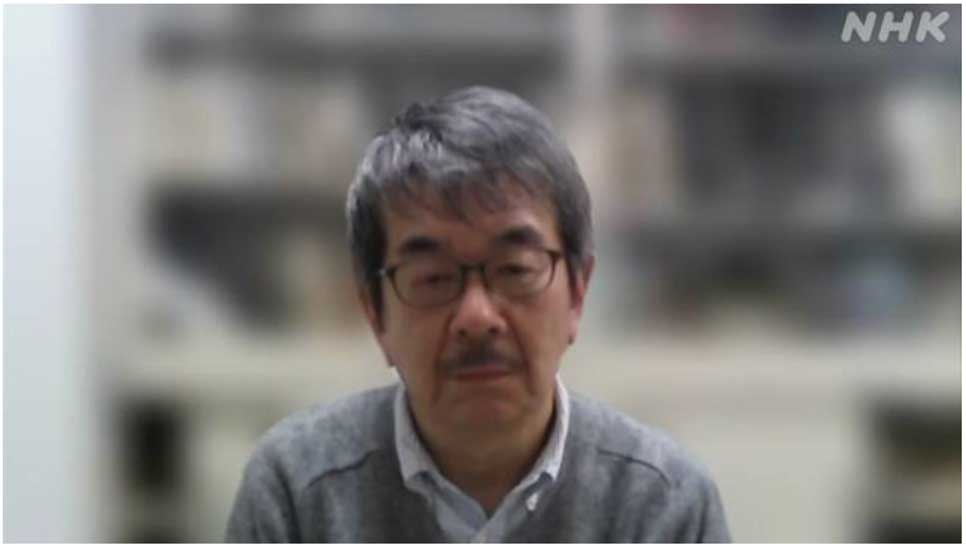
The finding of CDF, suggesting existence of fundamental lows beyond the Standard Theory, has been introduced by NHK News on 25th April and news papers such as Yomiuri News Paper on 8th April.
- 2022/04 Assi.Prof. Nonaka received “Yagi award 2022”
Assi.Prof. Toshihiro Nonaka, Div. of Quark Nuclear Matters, has received “Yagi award 2022”. Dr. Nonaka has been working on RHIC-STAR experiment to search for the QCD critical point through the measurements of fluctuations of conserved charges. He established procedures to correct the observables for various experimental artifacts, which has been widely used in this field and led to the observation of the hint on the critical point at the STAR experiment. Based on these contributions, he gave a plenary talk “Experimental Summary on Fluctuations of Conserved Charges” at the Quark Matter 2022 conference held in Krakow, Poland on April 4-10, 2022.
Yagi award is based on the donation to iTHEMS, Riken, Japan from bereaved family of late Professor Kohsuke Yagi of the Univ. of Tsukuba, who was a renowned Japanese nuclear physicist. Visit https://ithems.riken.jp/ja/about/yagi-award for details of the Yagi award.
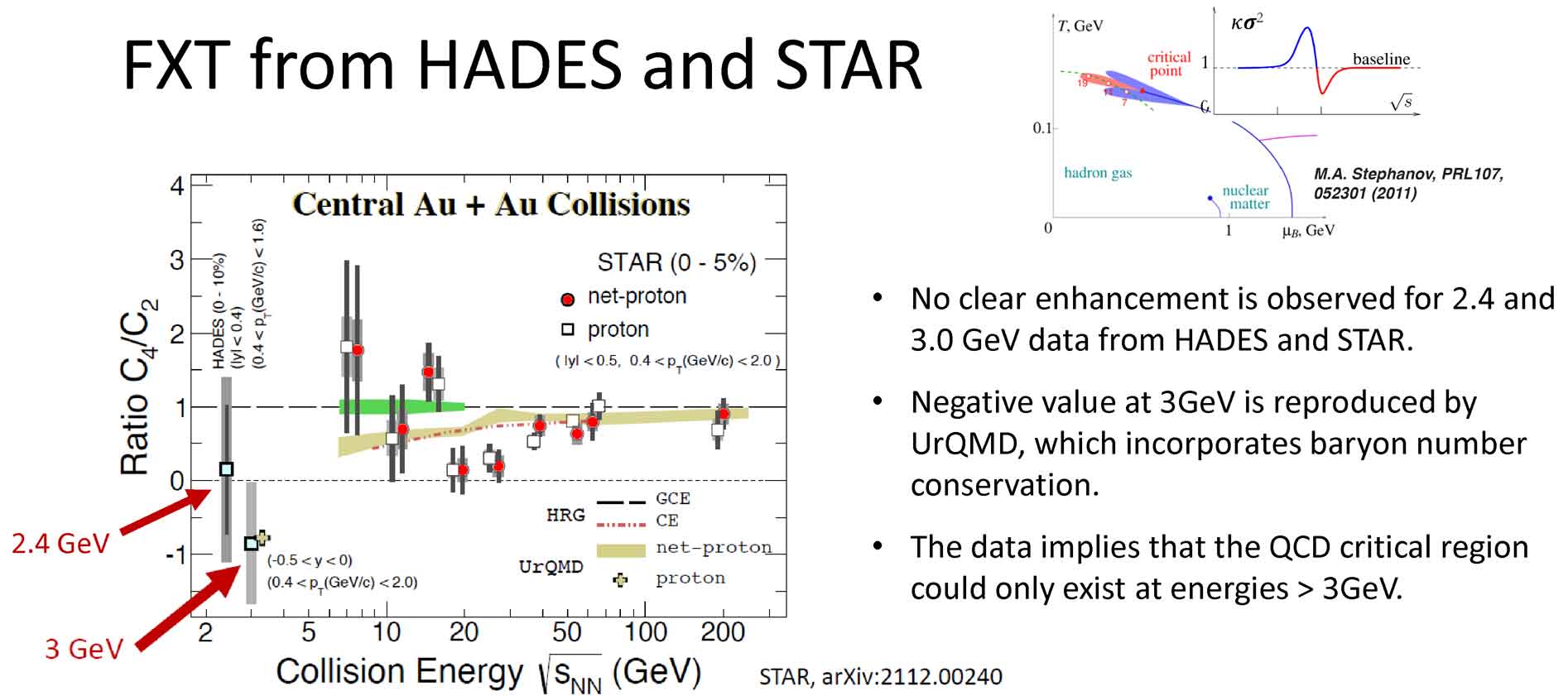
- 2022/4/1 Member list and pamphlet of TCHoU were updated.
- 2022/3/24 TCHoU Workshoo for the Division of Quark Nuclear Matters
- Date: March 24 (Thu) 2022, 10:30-18:00
- Venue: zoom online meeting
- Program:
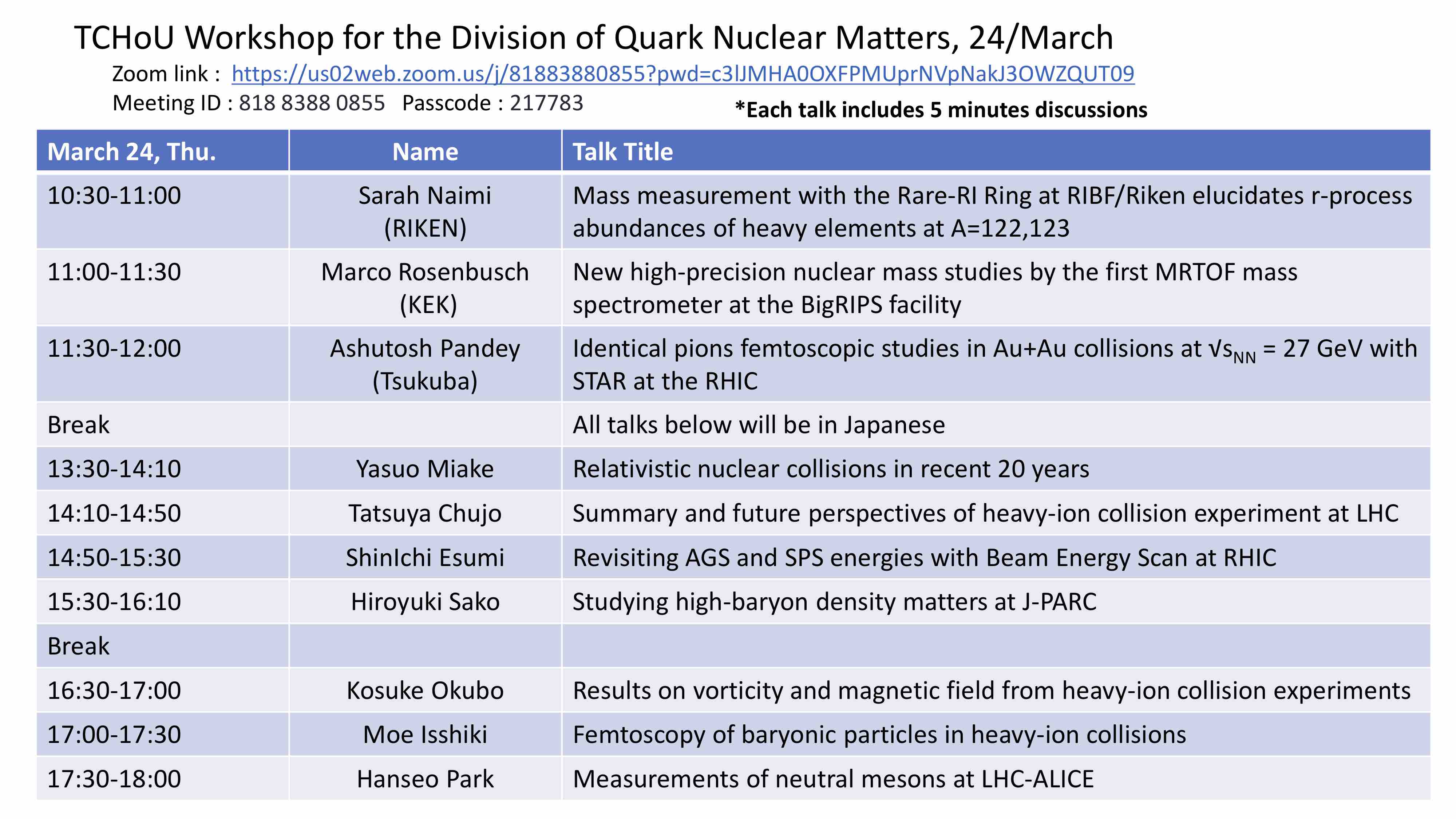
- Presentation Slides:
- S. Naimi
- M. Rosenbusch
- A. Pandey
- Y. Miake
- T. Chujo
- S. Esumi
- H. Sako
- K. Okubo
- M. Isshiki
- H. Park
- Number of participants: about 30
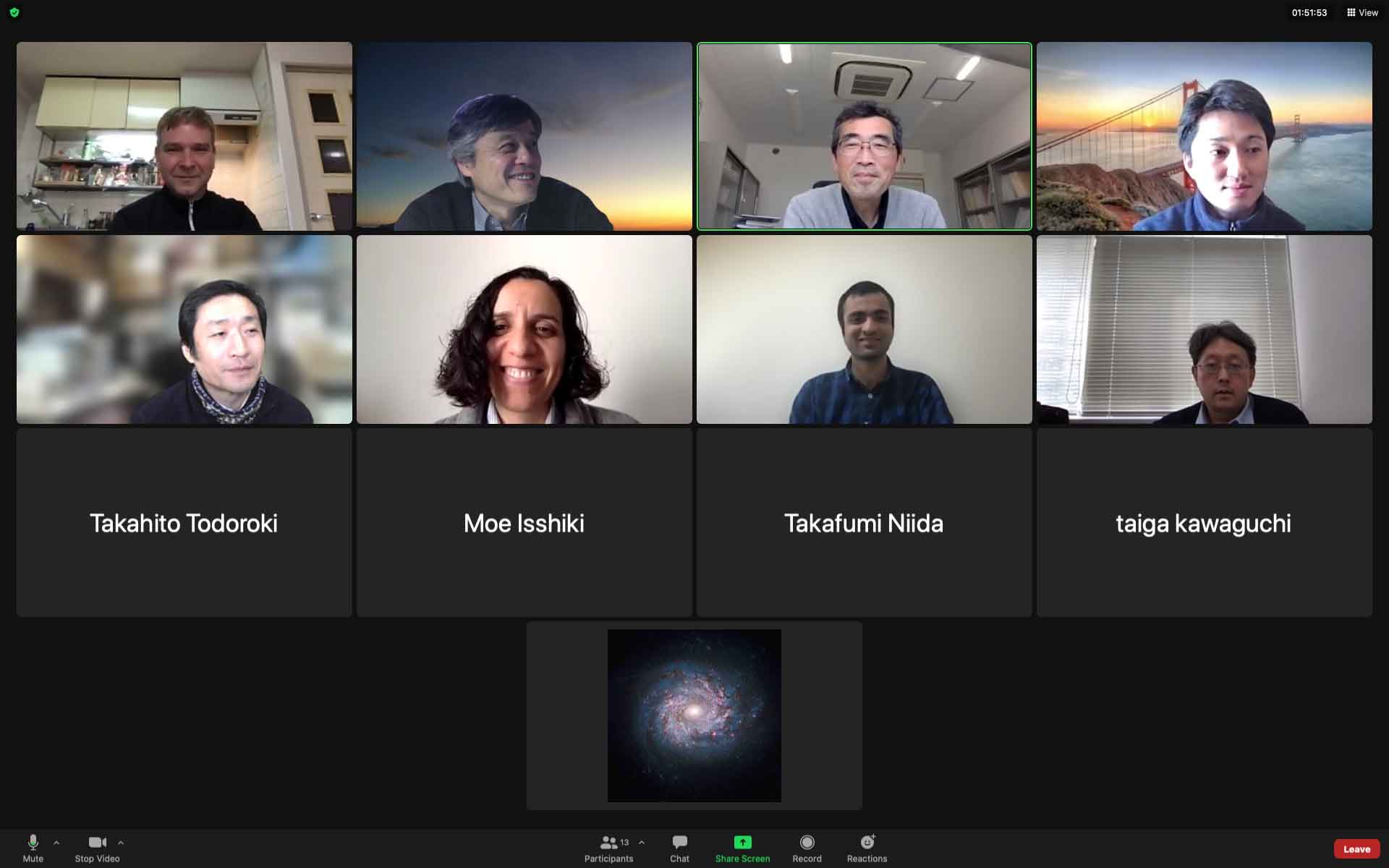
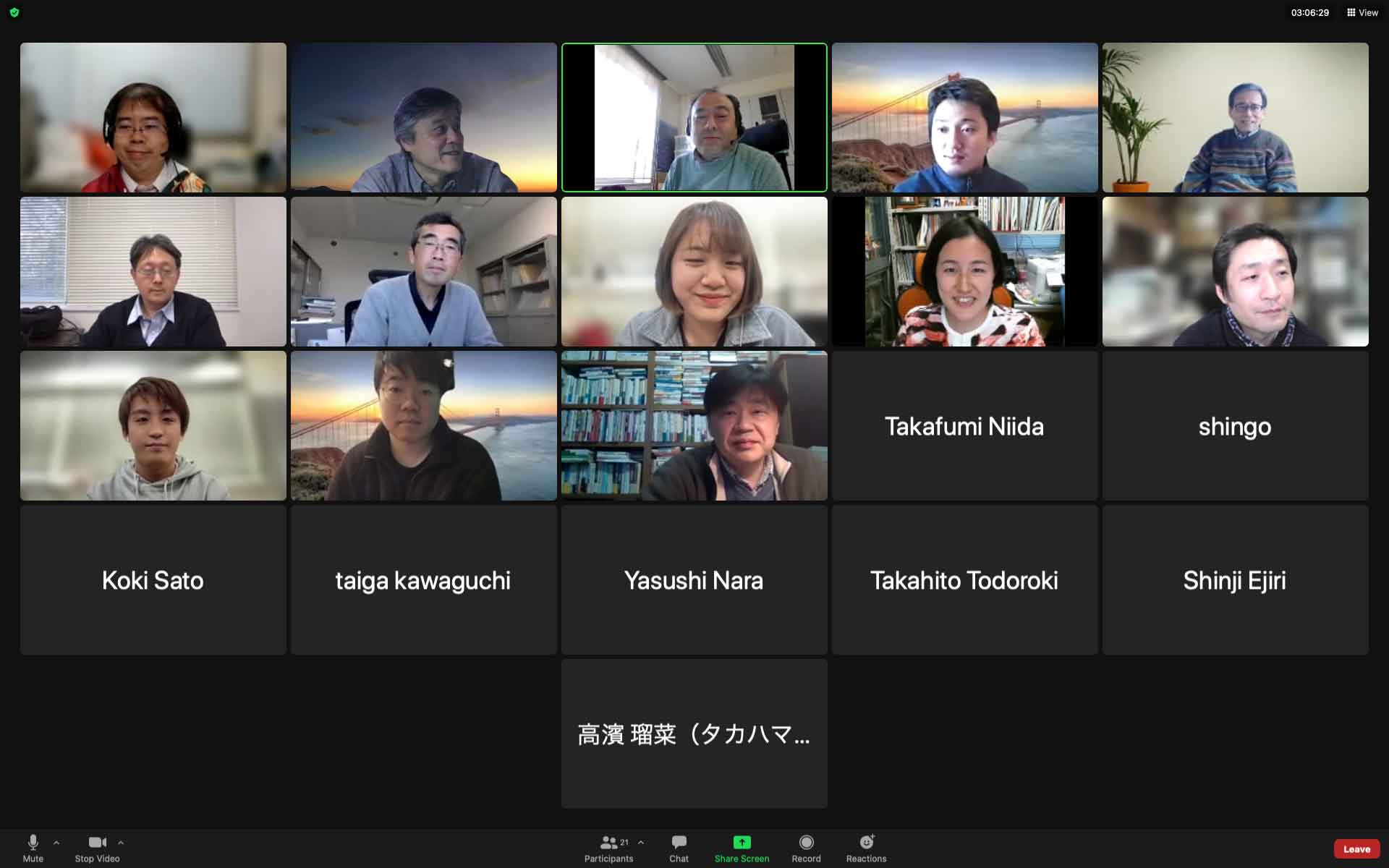
Contact: Assi.Prof. T. Nonaka
- 2022/3/23 TCHoU Workshoo for the Division of Elementary Particles
- Date: March 23 (Wed) 2022, 13:30-18:15
- Venue: zoom online meeting
- 【Program】
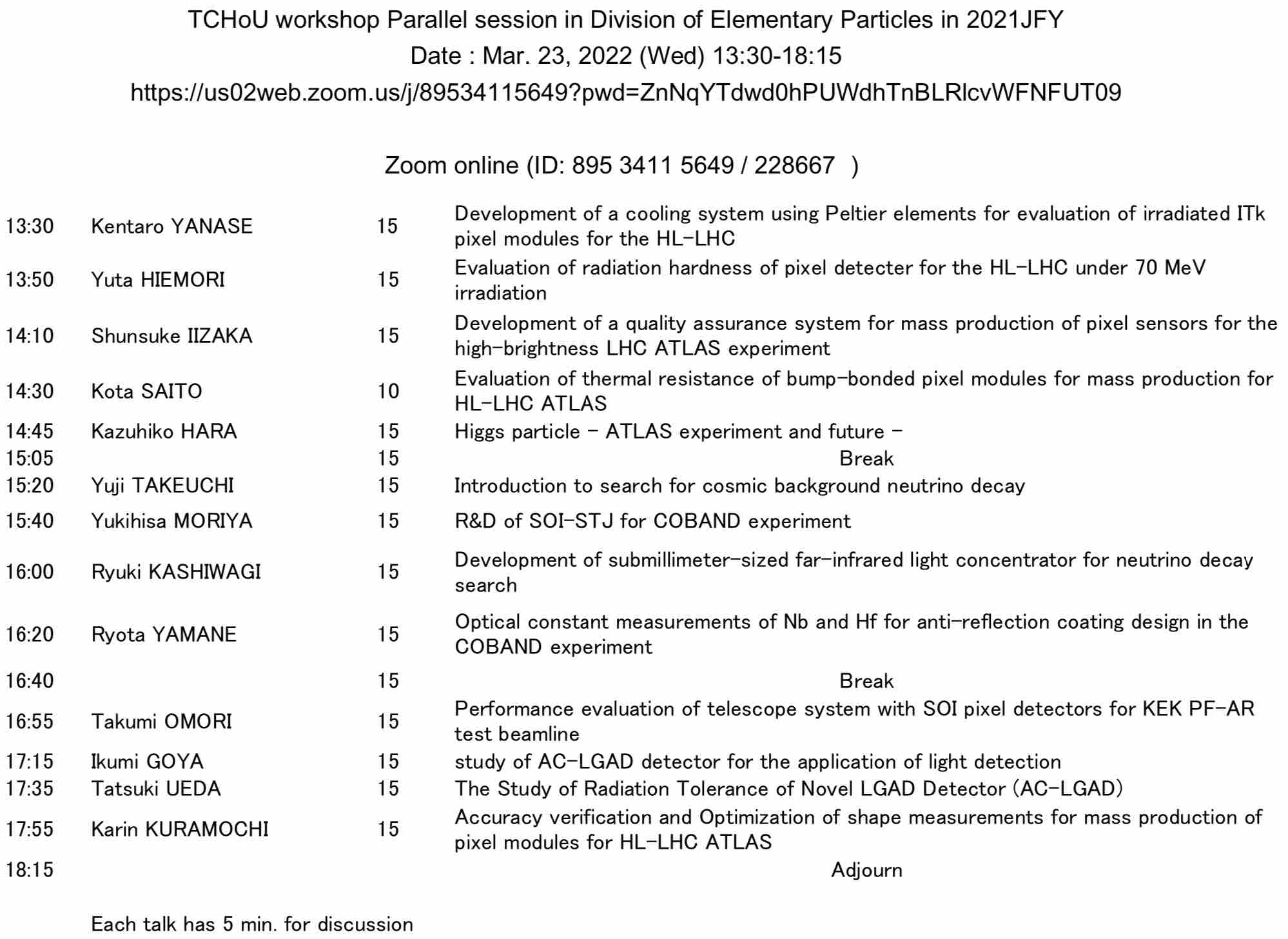
- Number of participants: 22
Visit https://hep-www.px.tsukuba.ac.jp/TCHoU/DEP/index.html#202203ws for presentation slides.
Contact: Assi.Prof. Y. Takeuchi
- 2022/3/22 TCHoU for the Division of Photon and Particle Detectors
- Date: Mar 22 (Tue) 2022, 10:00-12:00
- Venue: zoom online meeting
- 【Program】
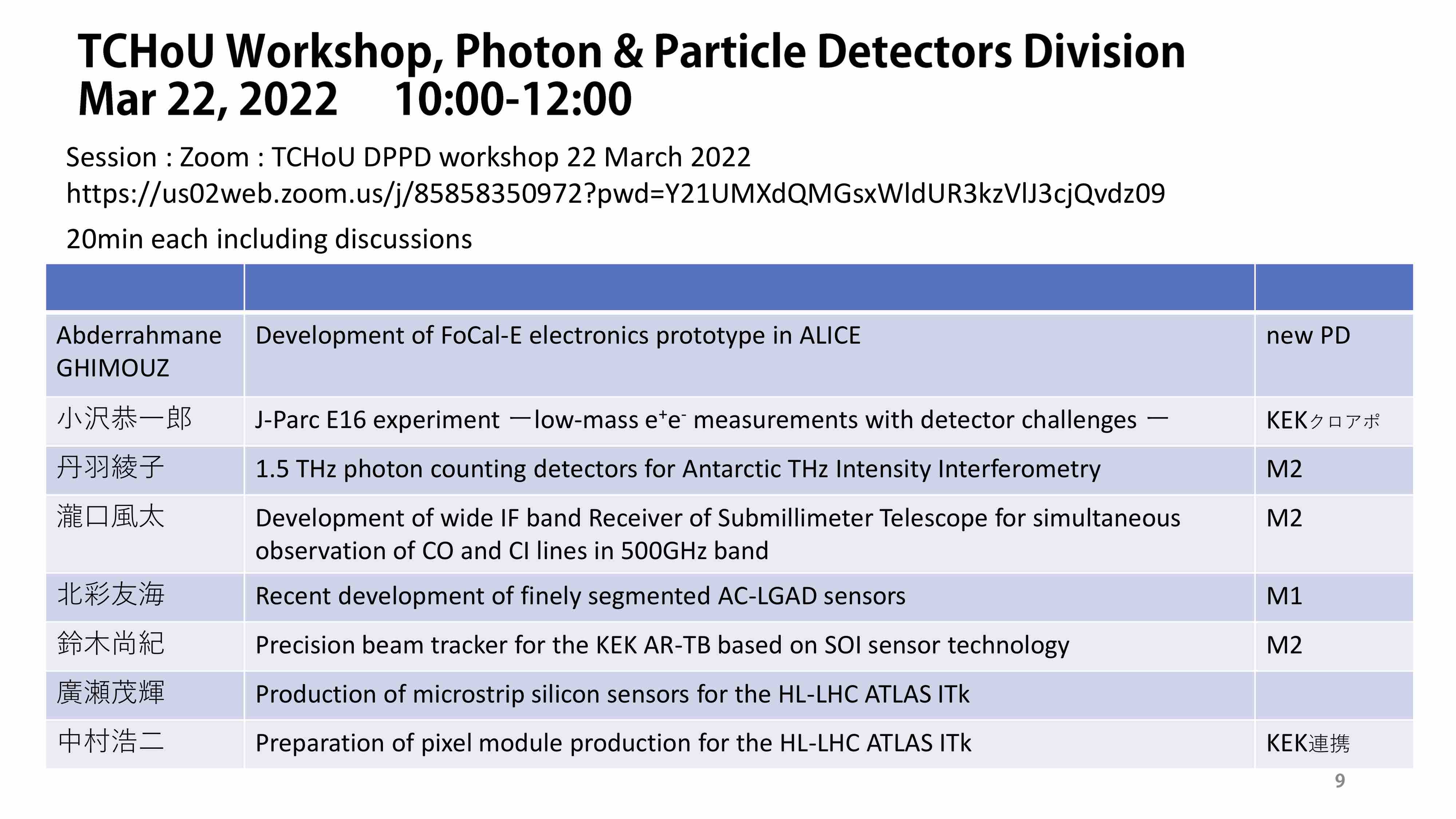
- Number of participants: 20

Contact: Asso.Prof. K. Hara
- 2022/03/18 TCHoU Sterring Committee Meeting
- Date: 18 Mar 2020 (Fri) 14:00-16:30
- Venue: zoom online meeting
- Program: (presentations are in Japanese)
14:00-14:30 N. Kuno Activity report for TCHoU 14:30-14:45 N. Kuno Activity report for the Div. of Antarctic Astronomy 14:45-15:00 Y. Takeuchi Activity report for the Div. of Elementary Particles 15:00-15:15 S. Esumi Activity report for the Div. of Quark Nuclear Matters 15:15-15:30 K. Hara Activity report for the Div. of Photon and Particle Detectors 15:30-16:30 Discussions (closed)
The first part of the Sterring Committee Meeting is open to public. We also have TCHoU Workshops for each division to enhance collaborations with external institues towards clarification of the History of the Universe.
Mar 16-24, 2022 TCHoU Workshops (zoom online meetings) 16 Mar (We) 10:00-14:35 Div. of Antarctic Astronomy (closed) 22 Mar (Tu) 10:00-12:00 Div. of Photon and Particle Detectors [presentation materials 23 Mar (We) 3:30-18:15 Div. of Elementary Particles 24 Mar (Th) 10:30-18:00 Div. of Quark Nuclear Matters Contact: Prof. N. Kuno
- 2022/03/04 Assi. Prof. Hashimoto received the 2021 PASJ Excellent Paper Award
Assi. Prof.Takuya Hashimoto (Div. of Antarctic Astronomy, TCHoU) and his collaborators have received the 2021 PASJ Excellent Paper Award.
Title: "Big Three Dragons: Az=7.15 Lyman-break galaxy detected in [O III] 88 μm, [C II] 158 μm, and dust continuum with ALMA"
Using ALMA, the authors succeeded for the first time in simultaneously detecting emission lines of oxygen and carbon ions ([OIII] 88 μm and [CII] 158 μm) and thermal radiation from cosmic dust in a galaxy about 13 billion light years away. This has revealed the detailed nature of the galaxy in the early universe.

- 2022/03/02 HoU Seminar
- Date: 02 Mar 2022 (Wed) 15:30-
- Venue: zoom online meeting
- Speaker: Prof. Kazunori Itakura (Nagasaki Institute of Applied Sciences)
- Title: Physics of Relativistic Heavy-Ion Collisions via High-Energy Limit
- Number of participants: about 30
We have an intensive lecture for the graduate course in the Univ. of Tsukuba on "Relativistic Heavy-Ion Collisions via High-Energy Limit” by Prof. Kazunori Itakura from 28/Feb/2022 to 2/Mar/2022, 10:00-11:30, 13:00-14:30, and 15:00-16:30 (15:30- on 2 Mar.), as a fully online course. The last part of the lecture will be given as a seminar of the History of the Universe (HoU seminar) starting from 2/Mar/2022 15:30- in the same zoom room.
The lecture course on the various physics phenomena in relativistic heavy-ion collisions will be provided to guide a basic idea of such phenomena via theoretical point of view, especially from the high-energy limit. The gluon saturation known as Color Glass Condensate (CGC) and Glasma formation will be discussed in relation to the high-energy heavy-ion collisions.
Please click on the title for the presentation slides.
Contact: Prof. S. Esumi (esumi.shinichi.gn [at] u.tsukuba.ac.jp)
- 2022/02/25 HoU Seminar
- Date: 25 Feb. 2022 (Fri) 13:45-
- Venue: zoom online meeting
- Speaker: Asso. Prof. Hiroshi Matsuo (National Astronomical Observatory of Japan)
- Title: Far-infrared intensity interferometry for future space mission
- Number of participants: 24
We had an intensive lecture for the graduate course in the Univ. of Tsukuba on "Aspects of THz Astronomy -- from the technological developments --” by Prof. Hiroshi Matsuo, who is giving a seminar of the History of the Universe (HoU seminar) on 25. Feb. with the title given above.
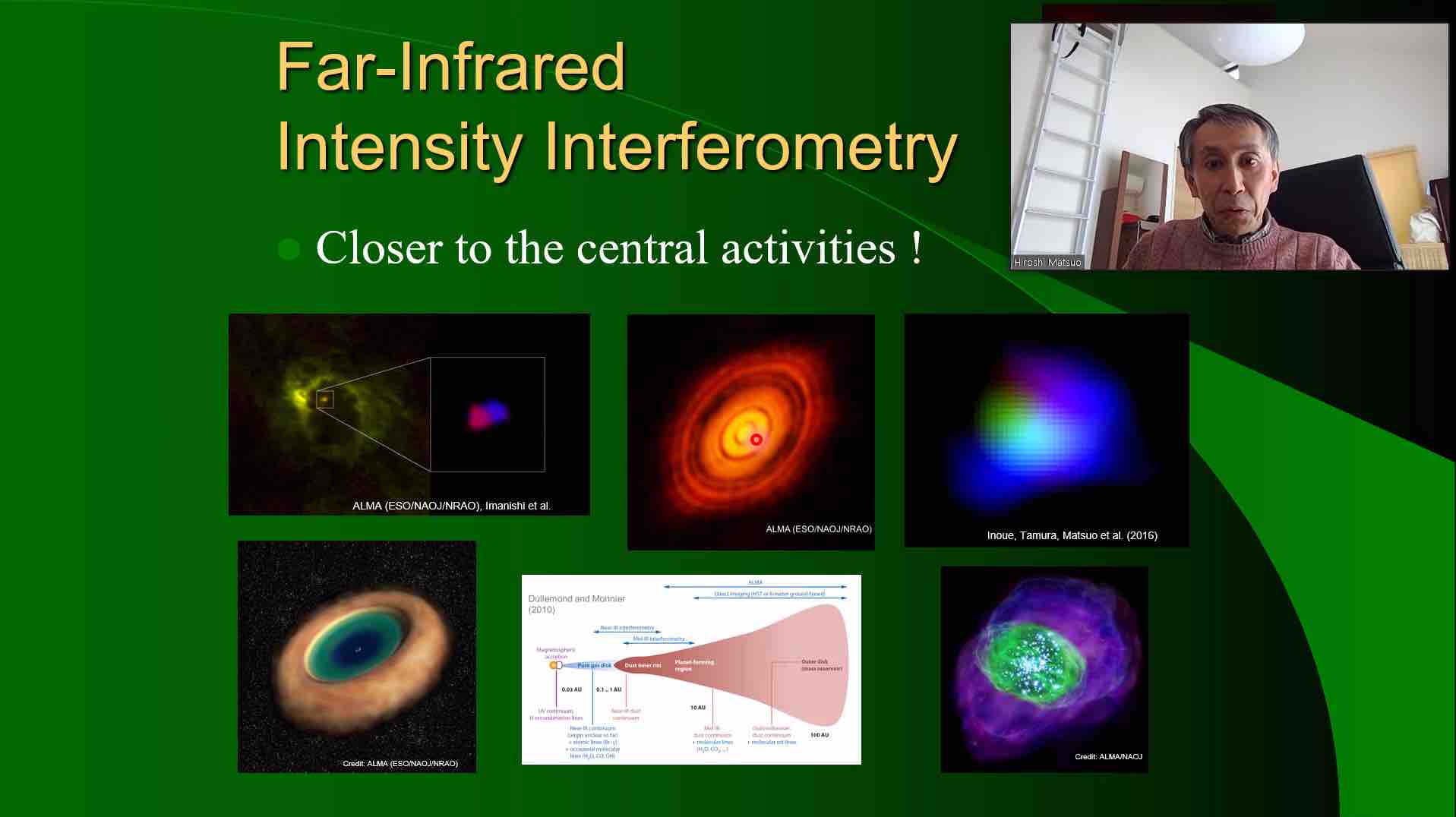
Please click on the title for the presentation slides.
Contact: Prof. N. Kuno (kuno.nario.gt [at] u.tsukuba.ac.jp)
- 2021/11/26 TCHoU Research Member Meeting / Activity and Achievement Reports
We have a meeting of the research members of the Tomonaga Center for the History of the Universe, followed by reports on main achievements in each field in the first period of FY 2021. The public session starts from 10:15-.
- Date: 26 Nov 2021 (Fri) 9:30-17:10
- Venue: zoom online meeting
- Program: (presentations are in Japanese)
- Number of participants: about 30

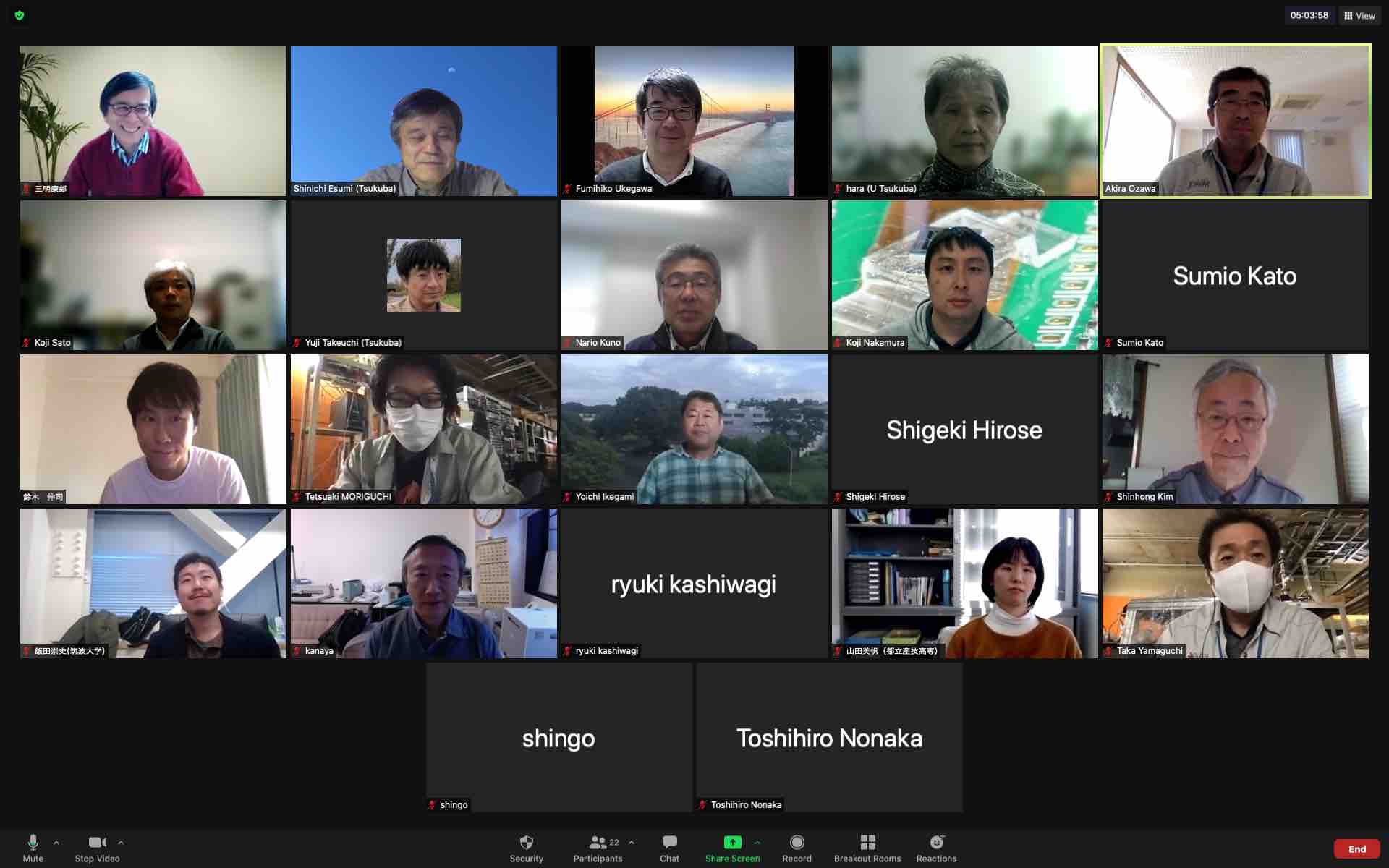
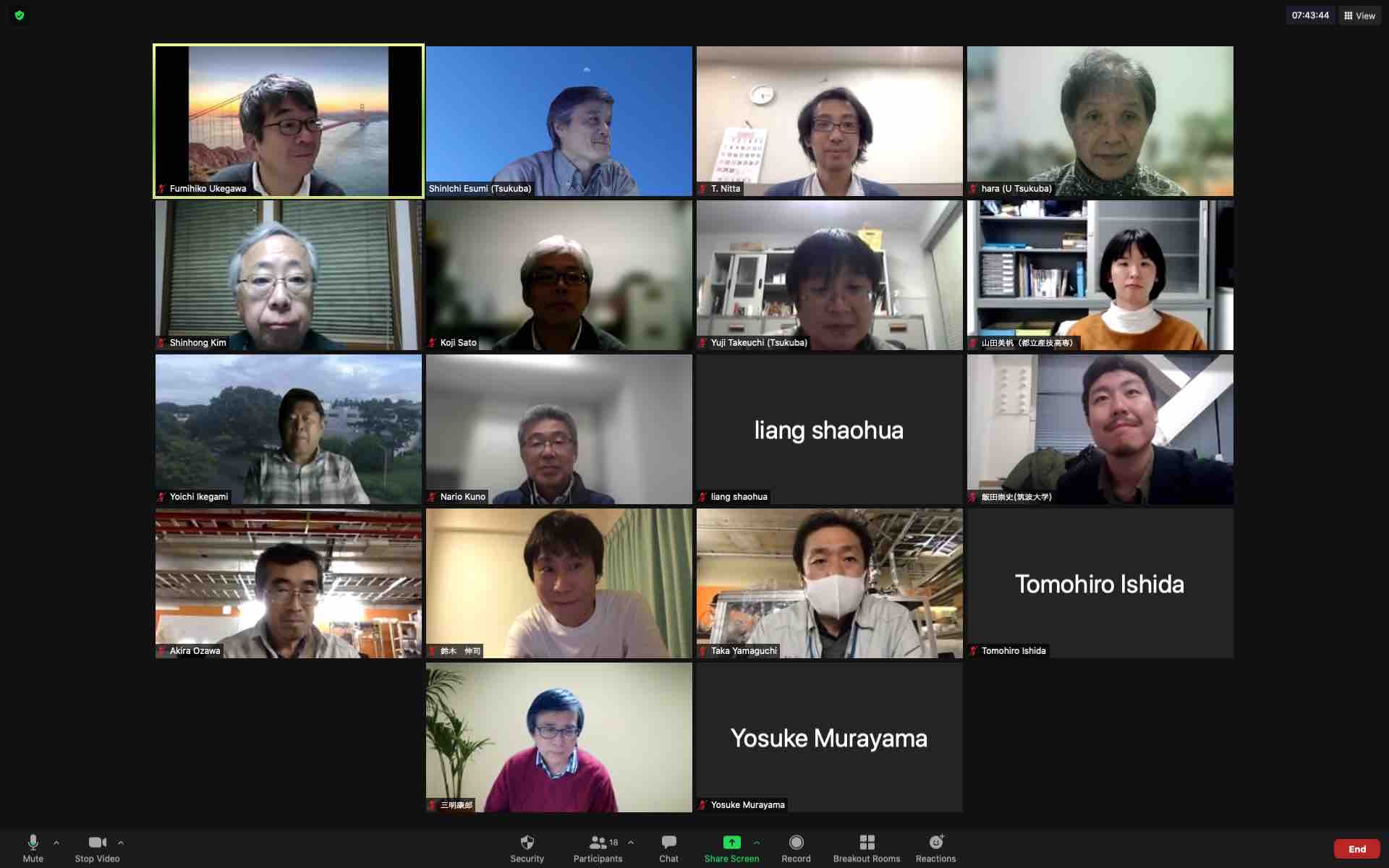
Contact: Prof. S. Esumi
- 2021/11/12 HoU Seminar
- Date: 12 Nov. 2021 (Fri) 13:45-15:00
- Venue: online by teams (b31unzy)
- Speaker: Prof. Ryuichiro Kitano (Inst. of Particle and Nuclear Studies, KEK)
- Title: Stochastic computation of g-2 in QED
- Number of participants: 23
We perform a numerical computation of the anomalous magnetic moment (g − 2) of the electron in QED by using the stochastic perturbation theory. Formulating QED on the lattice, we develop a method to calculate the coefficients of the perturbative series of g − 2 without the use of the Feynman diagrams. We demonstrate the feasibility of the method by performing a computation up to the α3 order and compare with the known results. This program provides us with a totally independent check of the results obtained by the Feynman diagrams and will be useful for the estimations of not-yet-calculated higher order values. This work provides an example of the application of the numerical stochastic perturbation theory to physical quantities, for which the external states have to be taken on-shell.
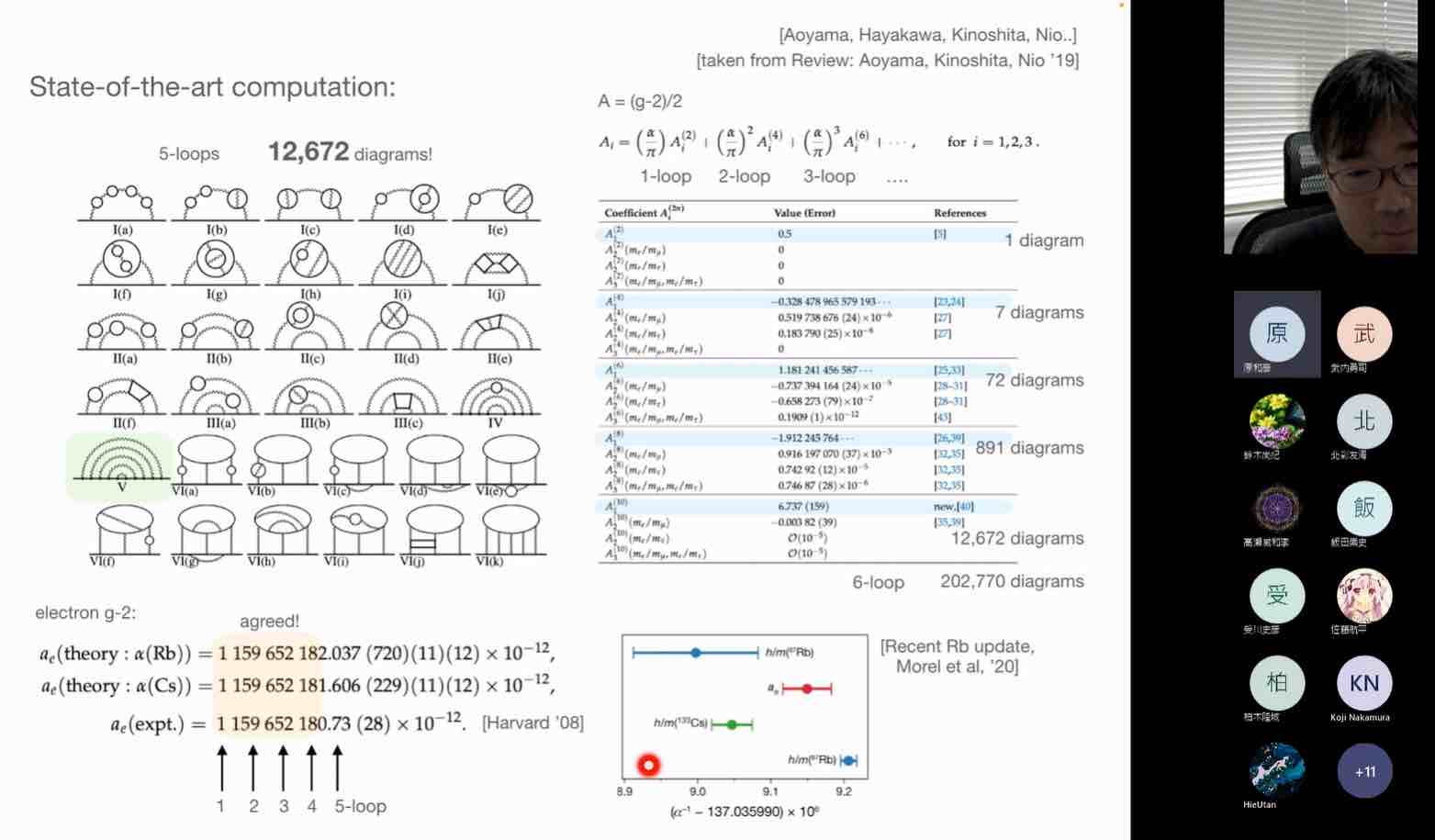
Contact: Asso.Prof. K. Hara
- 2021/10/16 The member list and pamphlet have been updated.
- 2021/09/24 Theory-Experiment Joint Workshop for Modeling of
QCD Phase Transition and QGP Formation in Heavy-Ion collisions
We hold one day online workshop in order to bring together theorists and experimentalists and to discuss about recent status and progress of the modeling of the QCD phase transition and QGP formation in heavy-ion collisions for understanding the space-time evolution of quark-nuclear matter at high-temperature and high-density.
- Date: 24 Sept. 2021 (fri) 9:30-17:30
- Venue: Online Zoom meeting (will be accounced to the registered participants)
- Co-hosts: Heavy Ion Cafe, Heavy Ion Pub
- Registration: registration
- Program: program (Presentations are in Japanese)
09:30-10:30 Yasushi Nara Akita Int. Univ. From Hydro to Hadron 10:30-11:00 Takafumi Niida Univ. of Tsukuba Flow, Correlation, Soft 11:00-12:00 Yuuka Kanakubo Sophia Univ. From Parton to Hydro 13:00-13:30 Daiki Sekihara Univ. of Tokyo Photon, Di-lepton, Hard 13:30-14:30 Yasuki Tachibana Akita Int. Univ. Hydro + Jet 14:30-15:00 Satoshi Yano Hiroshima Univ. Heavy quark, Quarkonium 15:00-15:30 Takahito Todoroki Univ. of Tsukuba Flow in Small Systems 16:00-16:30 Koichi Murase Kyoto Univ. Hydro + Fluctuation 16:30-17:00 Masakiyo Kitazawa Osaka Univ. Fluctuation + Lattice 17:00-17:30 Toshihiro Nonaka Univ. of Tsukuba Critical Point Search - Number of participants: 65
Contact: Prof. S. Esumi
- 2021/09/11 Tsukuba Global Science Week (TGSW) 2021 "Universe Evolution and Matter Origin"

As the Session 4-11 of the Tsukuba Global Science Week 2021, TCHoU is organizing International Workshop on "Universe Evolution and Matter Origin" as an on-line workshop.
Participation is free. Please register from the registration web site below to receive the connection details.
- Date: 11 Sept. 2021 (sat) 12:15-21:10
- Venue: Online Zoom meeting (will be accounced to the registered participants)
- Web site: TGSW / HoU session (session No. 4-11)
- Registration: registration web site
- Program: program
- Number of participants: 60

Contact: Prof. S. Esumi
- 2021/06/25 TCHoU Research Member Meeting / Activity and Achievement Reports
We have a meeting of the research members of the Tomonaga Center for the History of the Universe, followed by reports on main achievements in each field in the second period of FY 2020.
- Date: 25 Jun 2021 (Fr)
- Venue: zoom online meeting
- Program: (presentations are in Japanese)
- Number of participants: 35

Contact: Prof. N. Kuno
- 2021/05/17 New mail address for TCHoU
The mail address to the Tomonaga Center for the History of the Universe (TCHoU) was modified to
TCHoU@tchou.tomonaga.tsukuba.ac.jp - 2021/04/06 New URL for TCHoU
The URL for the web site of the Tomonaga Center for the History of the Universe (TCHoU) has been changed to
https://tchou.tomonaga.tsukuba.ac.jp/Please update the links to TCHoU on your sites.
- 2021/04/06 Asso. Prof. Hara and Assi. Prof. Hashimoto received the 2021 Commendation by the Minister of Education, Culture, Sports, Science and Technology, Japan
Asso. Prof. HARA Kazuhiko (Chair of the Div. of Photon and Particle Detectors) and Assi. Prof. HASHIMOTO Takuya (Div. of Antarctic Astronomy) received the 2021 Commendation for Science and Technology by the Minister of Education, Culture, Sports, Science and Technology (MEXT).
Link at MEXT (in Japanese): "About the 2021 Commendation for Science and Technology by the Minister of Education, Culture, Sports, Science and Technology"
Asso. Prof. Hara won the Award for Science and Technology (Category for Promotion of Science and Technology) for his contributions to the development of silicon detectors for particle physics experiments and their social applications.
He has conducted development of silicon detectors for the energy-frontier experiments, UA2, CDF and ATLAS leading to the discovery and precision measurements of W/Z, top and Higgs particles. He records the highest Google Scholar h-index (according to the University survey) among Japanese researchers. He also investigated the status of nuclear debris in the Units 1-3 of Fukushima Daiichi using cosmic muons and the technologies developed for the high-energy experiments.
Assi. Prof. Hashimoto won the Award for Young Scientists for his observational researches of various most distant galaxies using emissions from ionized carbons.
Observations of the most distant galaxies in the universe are important for understanding galaxy evolution and cosmic reionization phenomena. The establishment of a new observation method has been an important issue for spectroscopic observations of distant galaxies when the age of the universe was less than a billion years. Dr. Hashimoto established a new observation method for distant galaxies based on the combination of a doubly-ionized oxygen emission line and the ALMA telescope, which has the highest sensitivity. He led an international research team and succeeded in observing the most distant galaxy in history, 13.28 billion light years away, and the most distant merging galaxy, 13.1 billion light years away.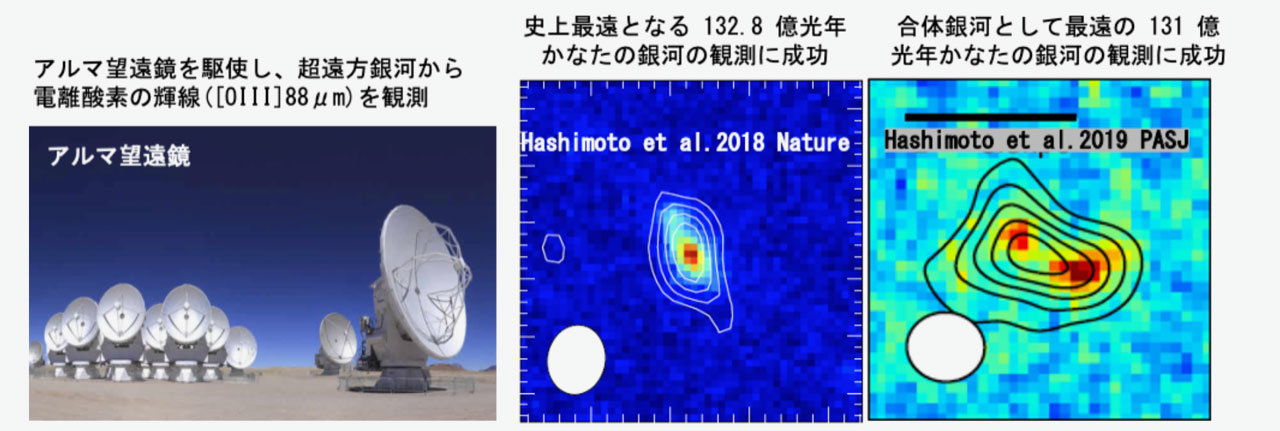
- 2021/03/29 TCHoU Sterring Committee Meeting
- Date: 29 Mar 2020 (Mo) 14:00-16:30
- Venue: zoom online meeting
- Program: (presentations are in Japanese)
14:00-14:30 N. Kuno Activity report for TCHoU 14:30-14:45 N. Kuno Activity report for the Div. of Antarctic Astronomy 14:45-15:00 Y. Takeuchi Activity report for the Div. of Elementary Particles 15:00-15:15 S. Esumi Activity report for the Div. of Quark Nuclear Matters 15:15-15:30 K. Hara Activity report for the Div. of Photon and Particle Detectors 15:30-16:30 Discussions (closed)
Contact: Prof. S. Esumi
- 2021/03/23-30 TCHoU Workshop
To enhance collaborations with external institues towards clarification of the History of the Universe, we organize the TCHoU Workshop.
- Venue: zoom online meeting
- Program:
23 Mar (Tu) 14:00-15:30 Div. of Elementary Particles (I) 25 Mar (Th) 13:00-17:00 Div. of Antarctic Astronomy 29 Mar (Mo) 10:00-12:30 Div. of Photon and Particle Detectors [presentation materials] 30 Mar (Tu) 9:30-17:30 Div. of Quark Nuclear Matters 30 Mar (Tu) 13:30-16:40 Div. of Elementary Particles (II)
Contact: Prof. S. Esumi
- 2021/02/25 HoU Seminar
- Date: 25 Feb 2021 (Thu) 16:00- (about one hour including discussions)
- Venue: online zoom meeting (Please ask the coordinator for connection details.)
- Speaker: Dr. Tetsuro Sugiura (Yahoo Japan, Ph.D. in Tsukuba 2018)
- Title: Science in Yahoo (in Japanese)
- Number of participants: about 16
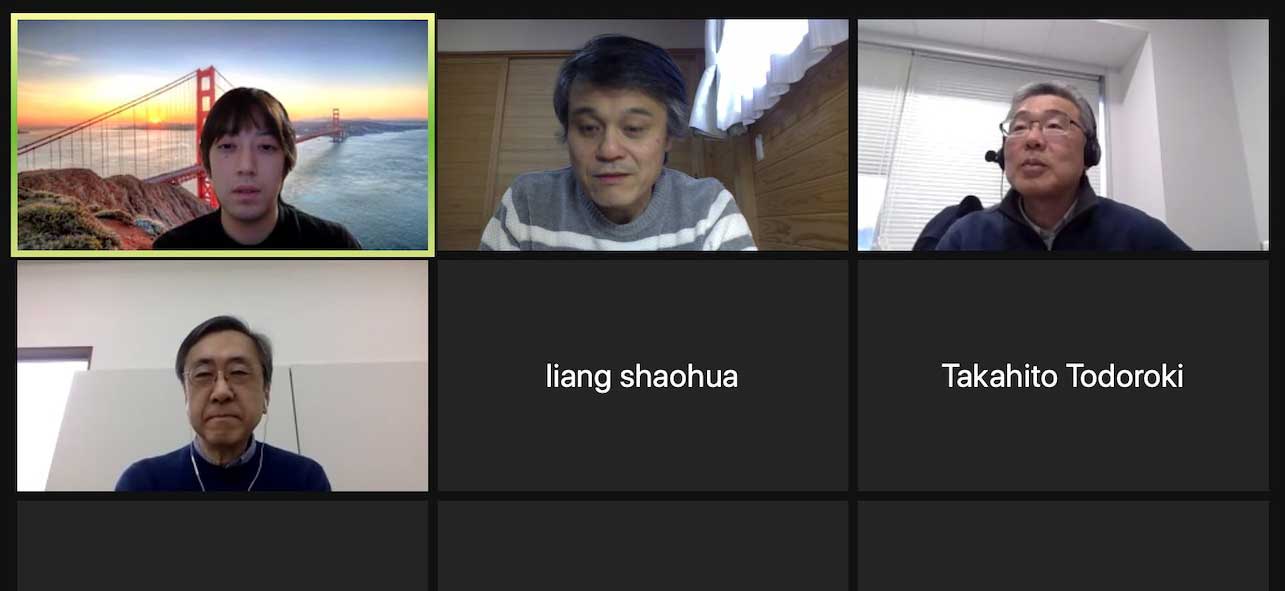
After some self-introduction of himself in science researches in university and in industry, he presented science activities in Yahoo Japan including artificial intelligence in various directions. He bridged a gap between university student’s imagination of industrial activities and actual duties after the one starts working inside the company.
Contact: Prof. S. Esumi
- 2021/02/24 5th workshop on 3D Quantum Imaging Sensor
Imaging sensors detecting visible lights, X-rays and charged particles require innovations such as in sensitivity enhancement by hybridization of different materials, large-scale integration of fine size pixels, high-speed image transfer, and dynamic-range improvement for next stage applications in scientific, medical and industrial areas.
One of the promising solutions is a 3D integration technology stacking different materials/chips vertically. This workshop is organized under a TIA-Kakehashi program "3D semiconductor quantum imaging sensor" (KEK-AIST-U Tokyo-U Tsukuba) to discuss directions of research activities with presentations on latest 3D integration technology and quantum imaging sensor technology.
- Date: 24 Feb 2021 (Wed) 13:30-17:15
- Venue: online with Webex
- Website: workshop URL
- Program: program
- Registration: workshop URL (free)
- Number of participants: 95
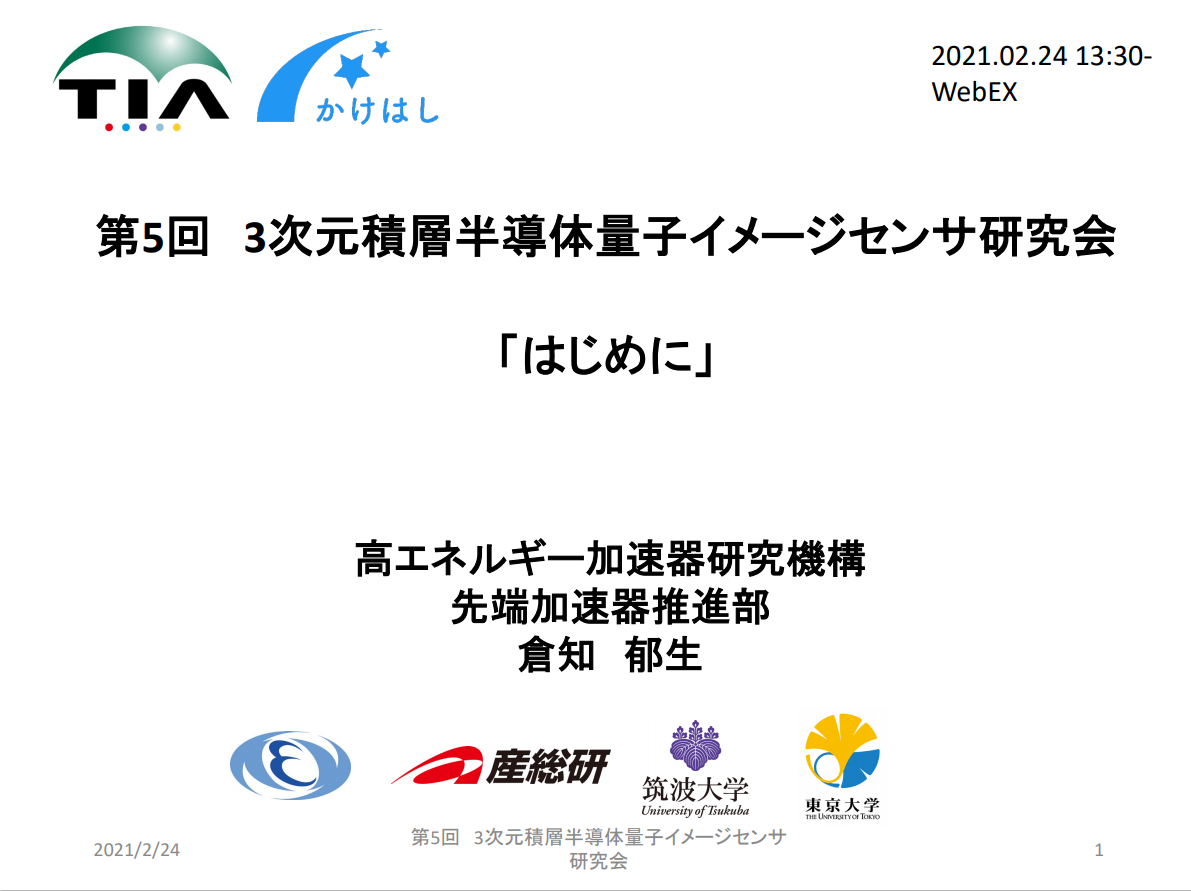
Contact: Asso.Prof. K. Hara
- 2020/11/30 TCHoU Research Member Meeting / Activity and Achievement Reports
We made a meeting of the research members of the Tomonaga Center for the History of the Universe, followed by reports on main achievements of each field in the first period of FY 2020.
- Date: 30 Nov 2020 (Mon)
- Venue: Natural Science Bldg. B114 (limited admission) + Online Zoom meeting
- Program: (presentations are mostly in Japanese)
- Number of participants: 44
Contact: Asso.Prof. Y. Takeuchi
- 2020/10/06 Assi.Prof. Takashi Iida won the Best Young Exploratory Joint Research Award
Assistant Professor Takashi Iida, Div. of Elementary Particles, received the "8th Best Young Exploratory Joint Research Award" from the Institute for Materials Research, Tohoku University. This award motivates young researchers who have achieved excellent results in joint use and joint research at the Institute for Materials Research, Tohoku University, to support further research development, and to develop the field of materials science research.
- Title:
"Development of new scintillator for double beta decay search" - Principal Investigator:Takashi Iida (U. of Tsukuba); Co-investigators: Keita Mizukoshi (Kobe U.), Masao Yoshino (Tohoku U.)
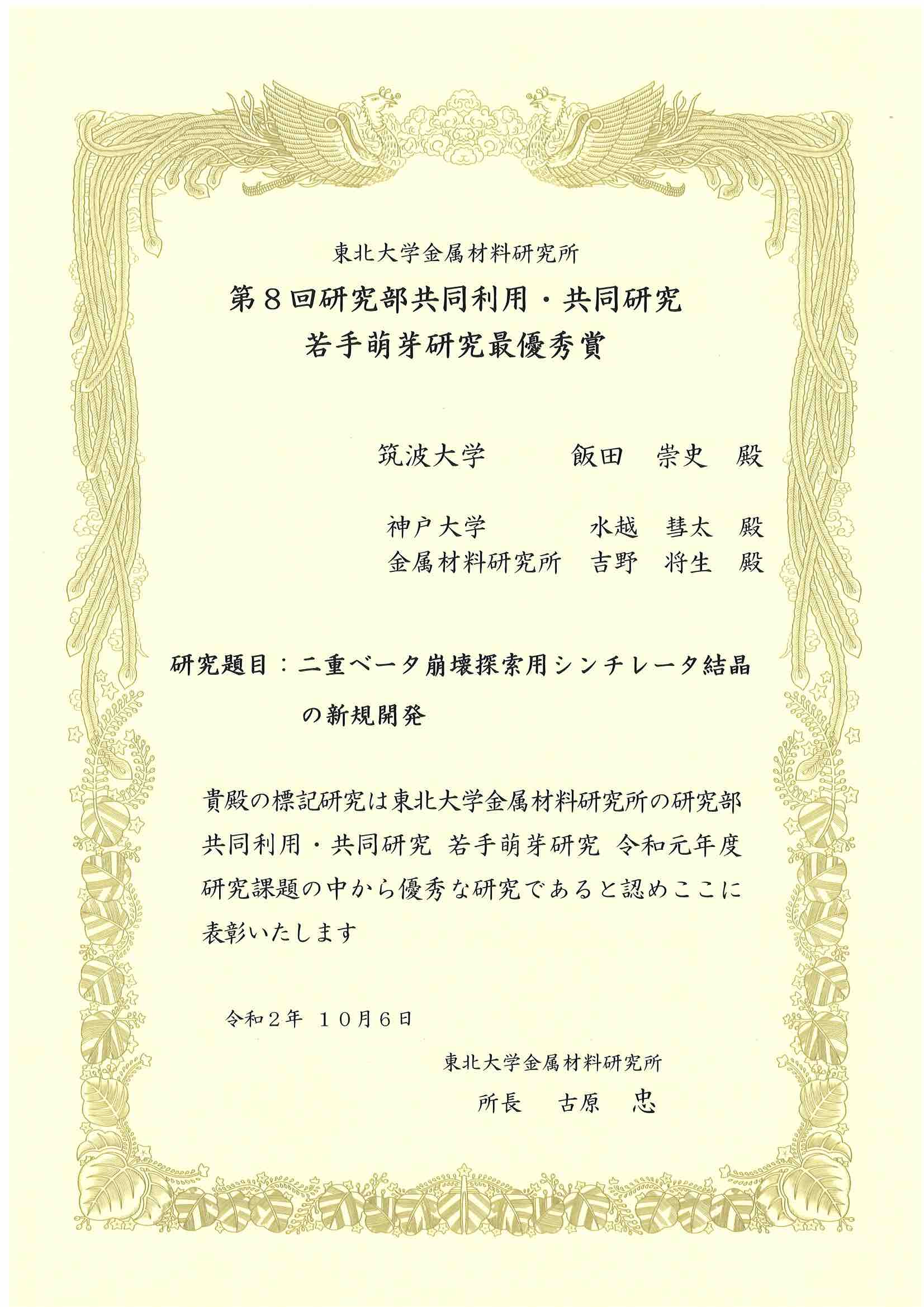
Observation of double beta decay without neutrinos emission is a very important study in elementary particle. If discovered, it can theoretically explain the fact that the universe is made of matter, not antimatter. A detector with high energy resolution is indispensable for the search for this double beta decay. Therefore, a scintillator containing double beta decay nuclei (48Ca, 96Zr, 160Gd, etc.), with a large amount of light emission and high resolution was developed in collaboration with Yoshikawa Laboratory of the Institute of Metallic Materials, Tohoku University, which has a high technologies in scintillator crystal development.
As a result, they succeeded in developing a scintillator called CaI2, and achieved a large emission amount (107,000 [ph./MeV]) and high resolution about 10 times that of commonly used plastic scintillators. In addition, by irradiating the CaI2 scintillator with α / γ rays and examining the waveform, the high particle identification ability of CaI2 was clarified for the first time. Furthermore, the development of a Ca (Brx, I1-x)2 scintillator in which iodine (I) of CaI2 is partially replaced with bromine (Br) and performance evaluation of a scintillator called (Ce0.005, La0.245, Gd0. 75)2Si2O7 including 160Gd was performed. The above research results and their future potential have been highly evaluated, and they have received this award. Currently, they are conducting research toward the practical application of the developed crystals, and developing a new Zr-containing scintillator.
- 2020/10/5-8 29th workshop on 3D Quantum Imaging Sensor
- Date: 5(Mon)-8(Thu) October 2020 20:00-24:00
- Style: remote by internet
- Website: workshop URL
- Number of participants: 135
The International Workshop on Vertex Detectors (VERTEX) is a major annual series of international workshops for physicists and engineers from the high energy and nuclear physics community. VERTEX provides an international forum to exchange the experiences and needs of the community, and to review recent, ongoing, and future activities on silicon based vertex detectors. The workshop covers a wide range of topics: existing and future detectors, new developments, radiation hardness, simulation, tracking and vertexing, electronics and triggering, applications to medical and other fields.
The 29th edition of the series VERTEX2020 will be held on October 5th-8th 2020 virtually by video conferencing.

Reports from the four major groups at the CERN LHC and the KEK-Belle group will cover the operation of the existing and upgrade detectors. In addition, two sessions discussing on the monolithic detectors and timing detectors are scheduled. The workshop will be closed by Prof.Ian Shipsey of the ICFA chair of Instrumentation Innovation and Development Panel.
This workshop was organized by the committee headed by Asso.Prof. Hara, leader of the Division of Photon and Particle Detectors of the Center, and the Center co-hosts the workshop.
Contact: Asso.Prof. K. Hara
- 2020/06/15 TCHoU Research Member Meeting / Activity and Achievement Reports
We have a meeting of the research members of the Tomonaga Center for the History of the Universe, followed by reports on main achievements in each field in the second period of FY 2019.
- Date: 15 June 2020 (Mon) 09:00-17:00
- Venue: Online Zoom meeting
- Program: (presentations are in Japanese)
- Number of participants: 34
Contact: Asso.Prof. S. Esumi
- 2020/04/19 Exhibition for the Science and Technology Week 2020
Due to the current situation with the COVID-19 in Japan, this exhibition has been cancelled.
TCHoU is pushing forward a series of integrated projects to clarify the history of the Universe. For the Science and Technology Week, we display our projects on the cosmic neutrino background, antarctic observatory of astronomy, quark gluon plasma, Higgs particle, nucleosynthesis, and cosmic evolution for junior students by posters, display of instruments, etc.
- Date: 19 Apr 2020 (sun) 13:00-17:00
- Venue: Building 1-E, Univ. Tsukuba
Contact: Prof. N. Kuno
- 2020/04/01 TCHoU Director
Prof. Nario Kuno assumed the post of Director of the Tomonaga Center for the History of the Universe. He also chairs the Division of Antarctic Astronomy.
- 2020/03/27 HoU Seminar
Due to the current situation with the COVID-19 in Japan, this seminar as well as the intensive course has been cancelled.
- Date: 27 Mar (Tue) 16:00-
- Venue: Natural Sciences Building B, B118
- Speaker: Dr. Takehiko R. Saito (Chief Scientist, RIKEN)
- Title: Strengeness Nuclear Physics
A HoU seminar on "Strengeness Nuclear Physics" is given as a part of an intensive course on extension of nuclear physics experiments to nuclei with strangeness, to be given on 26-27 Mar 2020, 10:10-, at Natural Sciences Building B, B118.
Contact: Asso.Prof. S. Esumi
- 2020/03/24 TCHoU Sterring Committee Meeting
- Date: 24 Mar 2020 (Tue) 12:30-16:00
- Venue: Bldg. Sogo-B, Room B110 and B204, Univ. Tsukuba
- Program:
12:30-13:30 K. Kanaya Activity report for TCHoU 13:30-13:45 N. Kuno 13:45-14:00 Y. Takeuchi Activity report for the Div. Elementary Particles 14:00-14:15 S. Esumi Activity report for the Div. Quark Nuclear Matters 14:15-14:30 K. Hara Activity report for the Div. Photon and Particle Detectors 14:30-14:45 break 14:45-16:00 Discussions * On the activities in FY2019.
* On the plans for future.
* On the organization in FY2020.
* Others.
The Sterring Committee Meeting is not open to public.
Due to the current situation with the COVID-19 in Japan, planned get-together has been cancelled.
Contact: Asso.Prof. S. Esumi
- 2020/03/23-24 TCHoU Workshop
Due to the current situation with the COVID-19 in Japan, this workshop has been cancelled.
- Date: 23(Mon)-24(Tue) Mar 2020
- Venue: Bldg. Sogo-B, Room B110 etc., Univ. Tsukuba
Contact: Asso.Prof. S. Esumi
- 2020/01/27 4th workshop on 3D Quantum Imaging Sensor
- Date: 27 Jan 2020 (Mon) 13:30-17:30
- Venue: EPOCHAL Tsukuba
- Website: workshop URL
- Program: program (in Japanese)
- Registration: registration form (free)
- Number of participants: 58
Imaging sensors detecting visible lights, X-rays and charged particles require innovations such as in sensitivity enhancement by hybridization of different materials, large-scale integration of fine size pixels, high-speed image transfer, and dynamic-range improvement for next stage applications in scientific, medical and industrial areas.
One of the promising solutions is a 3D integration technology stacking different materials/chips vertically. This workshop is organized under a TIA-Kakehashi program "3D semiconductor quantum imaging sensor" (KEK-AIST-U Tokyo-U Tsukuba) to discuss directions of research activities with presentations on latest 3D integration technology and quantum imaging sensor technology.
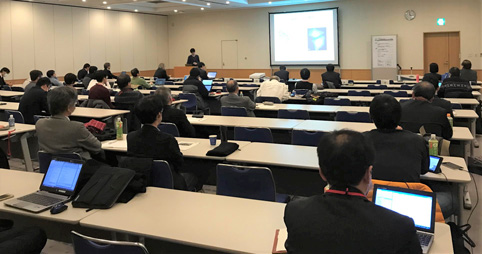
Contact: Asso.Prof. K. Hara
- 2020/01/20 HoU Seminar
- Date: 20 Jan 2020 (Mon) 10:00-11:00
- Venue: 1F201
- Speaker: Prof. Nu Xu (Lawrence Berkeley National Laboratory)
- Title: BES2 physics and future
- bluejeans: https://bnl.bluejeans.com/370165669
- Number of participants: 15
As a part of a local STAR analysis meeting in Tsukuba on 20-21/Jan/2020 Mon-Tue, Prof. Nu Xu gave a HoU seminar.


- 2020/01/10 HoU Seminar
- Date: 10 Jan 2020 (Fri) 13:45-
- Venue: Natural Sciences Building B, B118
- Speaker: Prof. Soo-Bong Kim (SNU/TCHoU))
- Title: Detection of coherent reactor neutrino scattering and search for sterile neutrino
- Abstract:
- Low-energy reactor neutrinos below 1/8 MeV are not measured yet because of the inverse beta decay reaction threshold. A recent observation of the coherent elastic neutrino-nucleon scattering (CEvNS) at ORNL sheds light on detecting the unobserved low-energy reactor antineutrinos using an improved dark-matter detection technology. However, it is extremely difficult to measure tiny nuclear recoil energy of tens of keV or less. We introduce a noble bolometric detector, named as LOCOND, consisting of a ~20 kg CsI(Na) or PPC HPGe crystals with cryogenic sensors as photon and phonon detectors in coincidence. Successful detection of reactor antineutrinos via CEvNS would open a new field of detecting extremely low-energy neutrinos in the unexplored energy region, and bring breakthrough to dark-matter detection. It will also make significant academic impact on efficient searches for neutrino magnetic moment and sterile neutrino. In the second part of this talk, I will present the status of JSNS2 experiment under the final phase of construction. The experiment utilizes an antineutrino beam from muon decay-at-rest using the 1 MW spallation neutron source at J-PARC MLF to explore sterile neutrino oscillations with 17 ton gadolinium-loaded liquid scintillator.
- Number of participants: 15



Contact: Asso.Prof. Y. Takeuchi
- 2020/01/08 HoU Seminar
- Date: 08 Jan 2020 (Wed) 16:45-
- Venue: 1F201
- Speaker: Dr. Ashutosh Kumar Pandey (TCHoU)
- Title: Non-identical particle femtoscopy in Pb-Pb collisions at 2.76 TeV with ALICE detector at the LHC
- Abstract:
- Femtoscopic correlations between charged pions and kaons for different charge combinations are measured in Pb−Pb collisions at √sNN=2.76 TeV with ALICE at the LHC. The three-dimensional pion-kaon (π−K) correlation functions and double ratios in the out-side-long pair rest frame are studied in different centrality bins. The π−K femtoscopic source size parameter (R_out) and emission asymmetry (μ_out) are extracted. It is observed that the average source size of the system and the emission asymmetry between pions and kaons increase from peripheral to central events.
- Number of participants: 20
Contact: Asso.Prof. S. Esumi
- 2019/12/21 Workshop "New aspect of the universe revealed by THz observations"
- Date: 21 Dec 2019 (Wed) 10:00-17:00
- Venue: National Institute of Polar Research
- Website: workshop URL (in Japanese)
- Program: program (in Japanese)
- Number of participants: 28
THz band is the only atmospheric window which has not yet been opened by ground-based large telescopes. In this workshop, we discussed what is new science that we can develop in THz band, striving for the realization of Antarctic THz telescope. This workshop was received a financial support from National Institute of Polar Research.
Contact: Prof. N. Kuno
- 2019/12/19 HoU Seminar
- Date: 19 Dec 2019 (Thu) 11:30-
- Venue: 1F201
- Speaker: Hiroki Yokoyama (Nikhef National institute for subatomic physics, researcher)
- Title: High granularity digital calorimeter with MAPS sensor
- Number of participants: 20
Contact: Assi.Prof. T. Chujo
- 2019/12/13 HoU Seminar
- Date: 13 Dec 2019 (Fri) 13:45-15:15
- Venue: Natural Sciences Building B, B118
- Speaker: Prof. Nicolo Cartiglia (INFN, Italy)
- Title: Tracking particles in space and time
- Abstract:
- The possibility of tracking particles in space and time has attracted a lot of attention in the last few years: it is now part of the CMS and ATLAS upgrades for HL-LHC and it is considered the baseline tracking system at FCC and at the next muon collider.
In this talk, Professor Nicolo Cartiglia will review the progress towards the development of silicon sensors able to track particles in 4D with a precision of ~ 10 μm and ~ 10 ps. He will show why thin silicon sensors with moderate internal gain are a very promising technology to achieve this goal, and how we can make this technology radiation-tolerant so that sensors can work after being exposed to fluences well above 1015 n/cm2. - Number of participants: 13

Contact: Asso.Prof. K. Hara
- 2019/12/04 Member list and TCHoU pamphlet updated.
- 2019/11/29 HoU Seminar
- Date: 29 Nov 2019 (Fri) 13:45-15:00
- Venue: Natural Sciences Building B, B114
- Speaker: Assi.Prof. Yusuke Koshio (Okayama Univ.)
- Title: Supernova neutrino measurement in Super-Kamiokande and Hyper-Kamiokande
- Number of participants: 21
This HoU Seminar on perspective of neutrino physics was given as a part of special lectures on "Neutrino Physics" given by Asso.Prof. Koshio on 27-29 Nov. 2019.


Contact: Dr. T. Iida
- 2019/11/21 TCHoU Research Member Meeting / Activity and Achievement Reports
We make a meeting of the research members of the Tomonaga Center for the History of the Universe, followed by reports on main achievements of each field in the first period of FY 2019.
- Date: 21 Nov 2019 (Thu) 9:30- around 18:00 (to be fixed soon)
- Venue: Natural Sciences Building B, B114
- Program: (click on the title to get presentation slides)
9:30-10:10 K. Kanaya TCHoU activity report 10:10-10:40 D. Salak Galactic winds driven by star formation in the local Universe 10:40-11:10 H. Saito Distribution of molecular clouds in the Galaxy by FUGIN 11:10-11:40 A. Wagner Galaxy Formation and AGN Feedback 11:40-13:00 lunch 13:00-13:30 K. Hara SOFIST, an SOI based pixel sensor for the ILC 13:30-14:00 I. Kurachi
(KEK)Challenge of SOI-MOSFET under extreme environments 14:00-14:30 Y. Kuramashi Application of the tensor-network method to particle physics 14:30-14:50 coffee 14:50-15:20 Y. Yamaguchi
(RIKEN)Heavy-ion storage ring at RIBF 15:20-15:50 Y. Takeuchi Recent developments for COBAND 15:50-16:20 K. Sato Recent results from ATLAS 16:20-16:50 G. Ishiki Diffeomorphism on a non-commutative space and its approximate invariants 16:50-17:00 F. Ukegawa summary - Number of participants: 27












Contact: Prof. N. Kuno
- 2019/11/20 Physics Seminar
- Date: 20 Nov 2019 (Wed) 16:45-18:00
- Venue: Natural Sciences Building B, B118
- Speaker: Asso.Prof. Yuju Takeuchi (TCHoU)
- Title: COBAND project to explore beyond the standard theory few seconds after the big bang (click on the title to get presentation slides)



- 2019/11/08 HoU Seminar
- Date: 08 Nov 2019 (Fri) 13:45-15:00
- Venue: Natural Sciences Building B, B118
- Speaker: Prof. Keisuke Fujii (KEK)
- Title: The International Linear Collider Project: Physics, Accelerator, Detectors and their Status
- Number of participants: 14



Contact: Prof. F. Ukegawa
- 2019/11/3-4 Exibition at Campus Festival "Soho-Sai" of Univ. of Tsukuba
An exposition introducing the research activities of the Tomonaga Center was made at the Campus Festival "So-Ho Sai" of the Univ. of Tsukuba.
- Date: 3(Sun)-4(Mon) Nov 2019, 10:00-16:00
- Venue: 3A207, Univ. Tsukuba
- Thema: "Clarification of the History of Universe"
- Number of Visitors: 306 (3 Nov), 471 (4 Nov); 777 (total)



- 2019/08 TCHoU Annual Report 2018
TCHoU annual report for FY 2018 (in Japanese) has been published. Please visit "Materials".
- 2019/08/19-21 Tutorial Workshop on "Physics of high-energy heavy-ion collisions: basics, achievements, issues, and perspectives"
- Date: Aug. 19 (Mon) - 21 (Wed), 2019
- Venue: RIKEN (Wako)
- URL: https://indico2.cns.s.u-tokyo.ac.jp/event/72/
- Admission fee: free
- Registration: Visit the URL above. Deadline is June 28 for presentations and supports, and July 31 for others.
- Program: time table
- Hosted by High-Temperature High-Density QCD Matter Open Forum (QCDMOF)
- Number of participants: 81
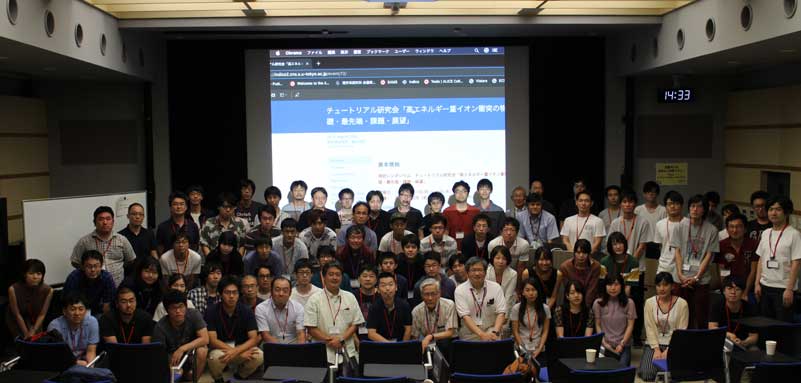
Contact: Masakiyo Kitazawa (Osaka), Taku Gunji (CNS Tokyo)
- 2019/07/06 Tanabata public lecture
- Date: July 6 (Sat.), 2019 13:30-16:30
- Venue: Tsukuba International Congress Center EPOCHAL
- Program:
13:30- Yuichi Takamizu
(Univ. Tsukuba)"Where are we from? -Invitation to galaxies-" 15:00- Tomoharu Oka
(Keio Univ.)"Search for stray black holes in the Milky way" - Admission: free
- Number of participants: 80
Contact: Prof. N. Kuno
- 2019/06/24-26 The 17th International Conference on QCD in Extreme Conditions (XQCD 2019)
International conference XQCD 2019 on the properties of quark matter at extreme temperatures and/or extreme densities will be held at the University of Tsukuba.
- Date: June 24 (Mon.) – June 26 (Wed.), 2019
- Venue: Tokyo Campus, University of Tsukuba, Tokyo, Japan
- URL: https://www2.ccs.tsukuba.ac.jp/xqcd2019/
- Registration fee: 12,000 yen
- Registration: Visit the conference URL. Deadline for registration is May 26, and that for abstract submission is May 12.
- Hosted by XQCD 2019 Local Organizing Committee
- Co-hosted by Center for Computational Sciences, University of Tsukuba / Tomonaga Center for the History of the Universe, University of Tsukuba / KEK
- Number of participants: 89







Organizers: Shinji Ejiri (Niigata), Kazuyuki Kanaya (Tsukuba), Masakiyo Kitazawa (Osaka), Yoshinobu Kuramashi (Tsukuba), Hideo Matsufuru (KEK), Hiroshi Ohno (Tsukuba, Chair), Yusuke Taniguchi (Tsukuba)
- 2019/06/15 CDF Collaboration was awarded the 2019 HEP Prize of EPS
The CDF Collaboration, in which main members of the Division of Elementary Particles are participating, was awarded the 2019 High Energy and Particle Physics Prize of the European Physical Society, together with the D0 Collaboration, for

This prize, for an outstanding contribution to High Energy Physics in experimental, theoretical or technological area, has been awarded to one or more persons or to collaboration(s) every two years since 1989. The Award Ceremony take place on Monday morning, July 15 during the EPS-HEPP Conference 2019, Ghent, Belgium.
- 2019/06/03 TCHoU Research Member Meeting / Activity and Achievement Reports
We have a meeting of the research members of the Tomonaga Center for the History of the Universe, followed by reports on main achievements of each field in the second period of FY 2018.
- Date: 03 June 2019 (Mon) 10:00-17:30
- Venue: Natural Sciences Building B, B114
- Program:
10:30-11:10 K. Kanaya TCHoU activity report 10:30-11:10 K. Sato LHC ATLAS experiment 11:50-13:00 lunch 13:00-13:30 Y. Takeuchi Development of STJ+SOI amplifire for the COBAND experiment
and its application to sub-GeV region towards detection of
dark-matter particles13:35-14:05 Y. Takamizu Cosmology and primordial gravitational wave 14:10-14:30 N. Kuno Activity report from the Division of Antarctic Astronomy 14:35-15:05 Y.Murayama Development of 109-pixel NbTiN/Al Hybrid MKID
for 100-GHz band continuum observations15:30-16:00 T. Chujo Status of the ALICE experiment and upgrade of the Focal project. 16:05-16:35 S.Nishimura
(RIKEN)Study of nucleosynthesis at RIBF 16:40-17:10 K.Nakamura
(KEK)Detector for inner-track path detector for the HL-LHC ATLAS experiment. 17:15-17:25 F. Ukegawa summary 18:00- T. Iida BBQ party @ Yasei-no-Mori, Univ. Tsukuba - Number of participants: 24













Contact: Prof. F. Ukegawa
- 2019/05/31 HoU Seminar
- Date: May 31 (Fri.) 2019, 13:45-15:00
- Venue: Natural Sciences Building B, B118
- Speaker: Asso. Prof. Tamaki Yoshioka (Research Center for Advanced Particle Physics, Kyushu University)
- Title: Fundamental Physics using low energy neutron at J-PARC
- Number of participants: ca. 15
Contact: Prof. F. Ukegawa
- 2019/05/20 Visit from Hamburg University
Professor Dr. Ingenuin Gasser, Vice Dean for Internationalization and Support for Young Researchers of the Hamburg University, and M.A. Gero Hemker, Dept. of International Affairs Strategy and Partnerships, Hambrg Univ., have visited the Univ. of Tsukuba to explore extension of research and education cooperations between the two Universities. They stopped by TCHoU and discussed with us about possible exchanges in the fields related to the History of the Universe.
- 2019/05/11 Prof. Shinhong Kim won the Kim Manyu Academic Award
Seiwa Memorial Foundation has given the Seiwa Memorial Foundation Kim Manyu Academic Award to Specially Appointed Prof. Shinhong Kim, Div. of Elementary Particles, for
- the research of particle physics including top quark discovery, Bc meson discovery and first observation of Bs meson oscillation at 2-TeV proton antiproton collision experiment CDF.
This Award is given to Korean people born in Japan for their excellent research in natural science. The award ceremony was held in Tokyo on May 11.
- 2019/04/20 Exhibition for the Science and Technology Week 2019
TCHoU is pushing forward a series of integrated projects to clarify the history of the Universe. For the Science and Technology Week 2019, we display our projects on the cosmic neutrino background, antarctic observatory of astronomy, quark gluon plasma, Higgs particle, nucleosynthesis, and cosmic evolution for junior students by posters, display of instruments, etc.
- Date: 20 Apr 2019 (sat) 10:00-16:00
- Venue: Sogo-B ground floor
- URL: Web site (in Japanese)
- Number of visitors: 135



Posters (click to enlarge):
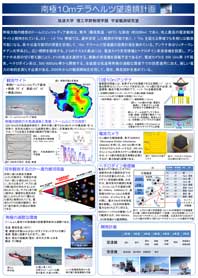
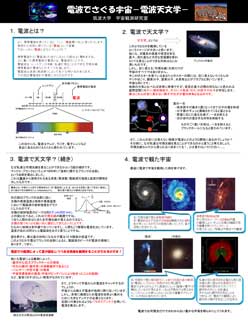
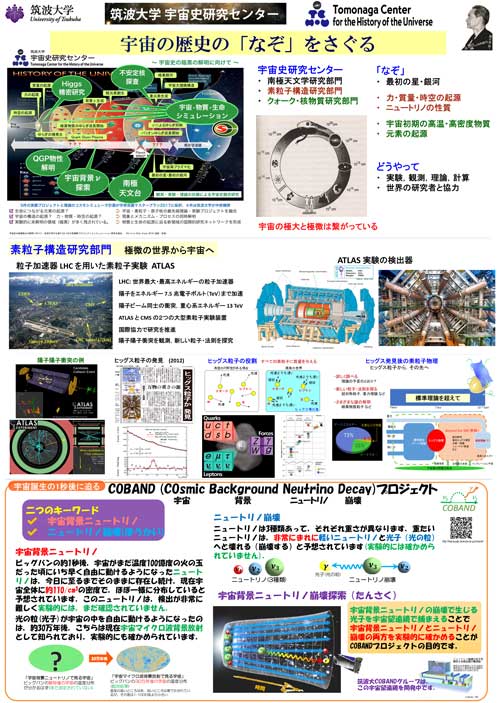
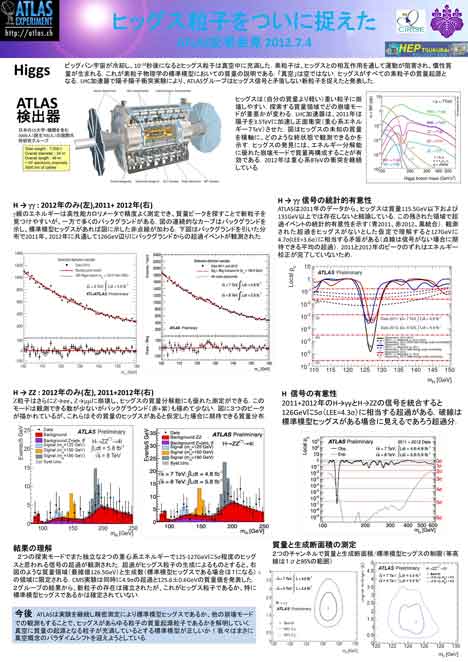
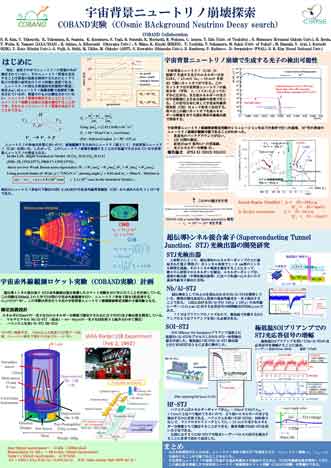
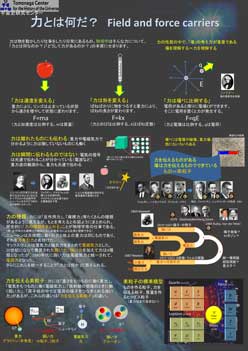
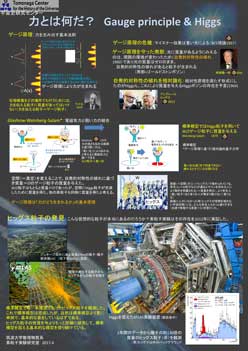
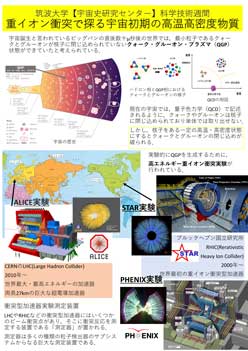
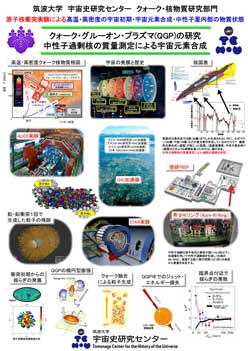

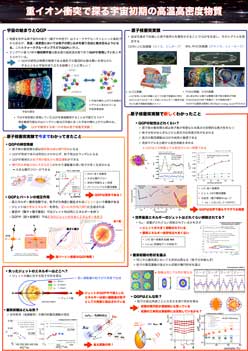
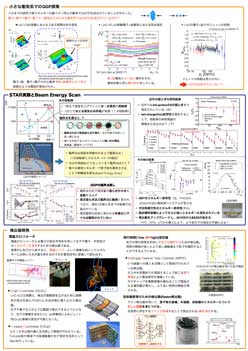
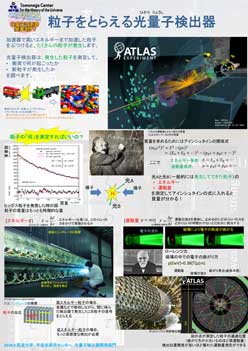
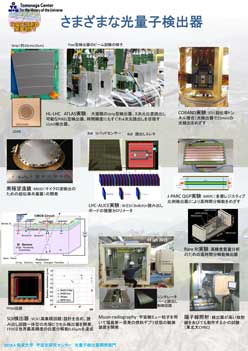
Contact: Prof. F. Ukegawa
- 2019/04/19 The members and associates list as well as the TCHoU pamphlets were updated.
- 2019/03/11 HoU Seminar
We held a HoU seminar as follows. Please join the seminar if you are interested in. This seminar was given by in English.
- Date: Mar 11, 2019 (Mon) 16:00-18:20
- Venue: Natural Science Bldg. B, Room B118, Univ. Tsukuba
- Speaker: Marco van Leeuwen (Utrecht Univ. / Nikhef, Univ. of Tsukuba)
- 16:00-17:00
- Title: Probing the Quark Gluon Plasma with energetic partons
- Speaker: Thomas Peitzmann (Utrecht Univ. / Nikhef, Univ. of Tsukuba)
- 17:20-18:20
- Title: Photon production in high-energy heavy-ion reactions
- Number of participants: ca. 15



Contact: Assi.Prof. Tatsuya Chujo
- 2019/03/08 4th Symposium on TIA Photon and Particle Measurements
"TIA Photon and Particle Measurement" Square combines advanced technologies on photon-particle measurements developed by TIA five institutes aiming at creation of new sciences and industrial seeds. The technologies involve high performance creation of photons and particles, photon and particle detectors including leading-edge processes, fundamental material researches using photon and particle beams.
- Date: Mar 8, 2019 (Fri) 13:00-17:00
- Venue: Tsukuba International Conference Center (EPOCAL Tsukuba) 2F
- URL: https://www2.kek.jp/URA/tiaacc4.html
- Program: poster and program (in Japanese)
- Admission fee: free
- Number of participants: 83
- Invited Talks (in Japanese)
- "Optical pressure and nano particle: manipulation, measurement and reaction control" Shoji Ito (Osaka Univ.)
- "New definition of Kilogram based on Planck constant" Kenichi Fujii (AIST)
After the invited talks, we have poster presentations.
Visit the symposium web page (in Japanese) for registration etc.
Contact: Asso.Prof. K. Hara
- 2019/03/07-09 International Workshop on Forward Physics and Forward Calorimeter Upgrade in ALICE
We hold the international workshop on forward physics at RHIC and LHC and the forward calorimeter (FoCal) upgrade in ALICE, from March 7 - 9, 2019 at University of Tsukuba, Center for Computational Sciences, Tsukuba, Ibaraki, Japan.
- Date: 07-09 Mar 2019
- Venue: Center for Computational Sciences, Univ. Tsukuba, Tsukuba, Ibaraki, Japan.
- Website: https://indico.cern.ch/event/783989/
- Topics:
- * Forward physics at high energy pp, p-A and AA collisions
- * Initial condition of high energy heavy ion collisions at LHC and RHIC
- * Thermalization mechanism, strong fields
- * Small-x physics, gluon PDF, saturation and Color Glass Condensate (CGC)
- * Forward detector upgrade using Si-W calorimeter and hadron calorimeter at LHC, related detector technologies and upgrade project in other fields
- Program: https://indico.cern.ch/event/783989/timetable/#all.detailed
- March 7, Thursday: Forward physics (ALICE FoCal, HERA, ATLAS, LHCf, RHICf, PHENIX/sPHENIX), workshop dinner
- March 8, Friday: Si-W calorimeter, FoCal design
- March 9, Saturday: Future program at LHC beyond Run-5, close the meeting around the lunch time
- Registration:
- Visit the workshop website for on-line registration.
- Number of participants: 40 (9 from abroad)
The first part of the workshop covers the forward physics at high energy in general, and the second part is more focused on the technical aspects on FoCal detector in ALICE.
Contact: Assi.Prof. Tatsuya Chujo
- 2019/02/27-28 Particle Physics Seminar
We have an introductory seminar on the lattice calculation of transport coefficients in finite-temperature QCD by Assi.Prof. Masakiyo Kitazawa (Osaka University).
- Date: 27-28 Feb 2019, 10:00-18:00
- Venue: Natural Science Bldg. D, Univ. Tsukuba, Room D410
- Speaker: Assi.Prof. Masakiyo Kitazawa (Osaka University)
- Title: Hydrodynamic equations and simulations on the lattice
- Number of participants: ca. 15
The seminar is given in Japanese. Admission is free.

Contact: Prof. K. Kanaya
- 2019/02/05 TCHoU Sterring Committee Meeting
- Date: 05 Feb 2019 (Tue) 13:00-17:45
- Venue: Bldg. Sogo-B, Rooms B110 and B204, Univ. Tsukuba
- Program:
- 13:00-15:00: Activity reports for FY2018 @ Room B110
- 15:30-17:45: Closed discussions of the Sterring Committee @ Room B204
- Activity reports:
- Tomonaga Center [Kanaya]
- Division of Antarctic Astronomy [Kuno]
- Division of Elementary Particles [Takeuchi]
- Division of Quark Nuclear Matters [Esumi]
- Division of Photon and Particle Detectors [Hara]
- Get-together: 18:00-20:00 @ "Soup Factory", at the 1st area of Univ. Tsukuba
- Please visit the registration page of the TCHoU workshop for pre-registration. On the day registration is also possible.
The first part is open to public, and is held also as a session of the TCHoU Workshop introduced in the next column.
Contact: Prof. K. Kanaya
- 2019/02/04-05 TCHoU Workshop
To enhance collaborations with external institues towards clarification of the History of the Universe, we organize the 1st TCHoU Workshop.
- Date: 04 Feb 2019 (Mon) 13:00-18:00, 05 Feb 2019 (Tue) 09:30-17:30
- Venue:
- 04 Feb: CCS, Univ. Tsukuba, Workshop room, Meeting rooms A and B
- 05 Feb: Bldg. Sogo-B, Room B110, Univ. Tsukuba
- Website: workshop website
- Program overview:
- 04 Feb 13:00-18:00: Parallel sessions for Divs. of Antarctic Astronomy, Elementary Particles, and Quark Nuclear Matters
- 05 Feb 09:30-11:30: Joint session (Div. of Photon and Particle Detectors)
- 05 Feb 13:00-15:00: TCHoU activity reports for FY2018
- Registration:
- Online registration by Jan 27, 2019 (Sun) at workshop website.
- (We accept registrations after Jan 27 too.)
- Get-together: 18:00-20:00 @ "Soup Factory", at the 1st area of Univ. Tsukuba
- Please visit the registration page of the TCHoU workshop for pre-registration. On the day registration is also possible.
- Number of participants: 18(AA)+20(EP)+20(QNM)+31(DPPD)
Visit the workshop website for details.
Antarctic Astronomy 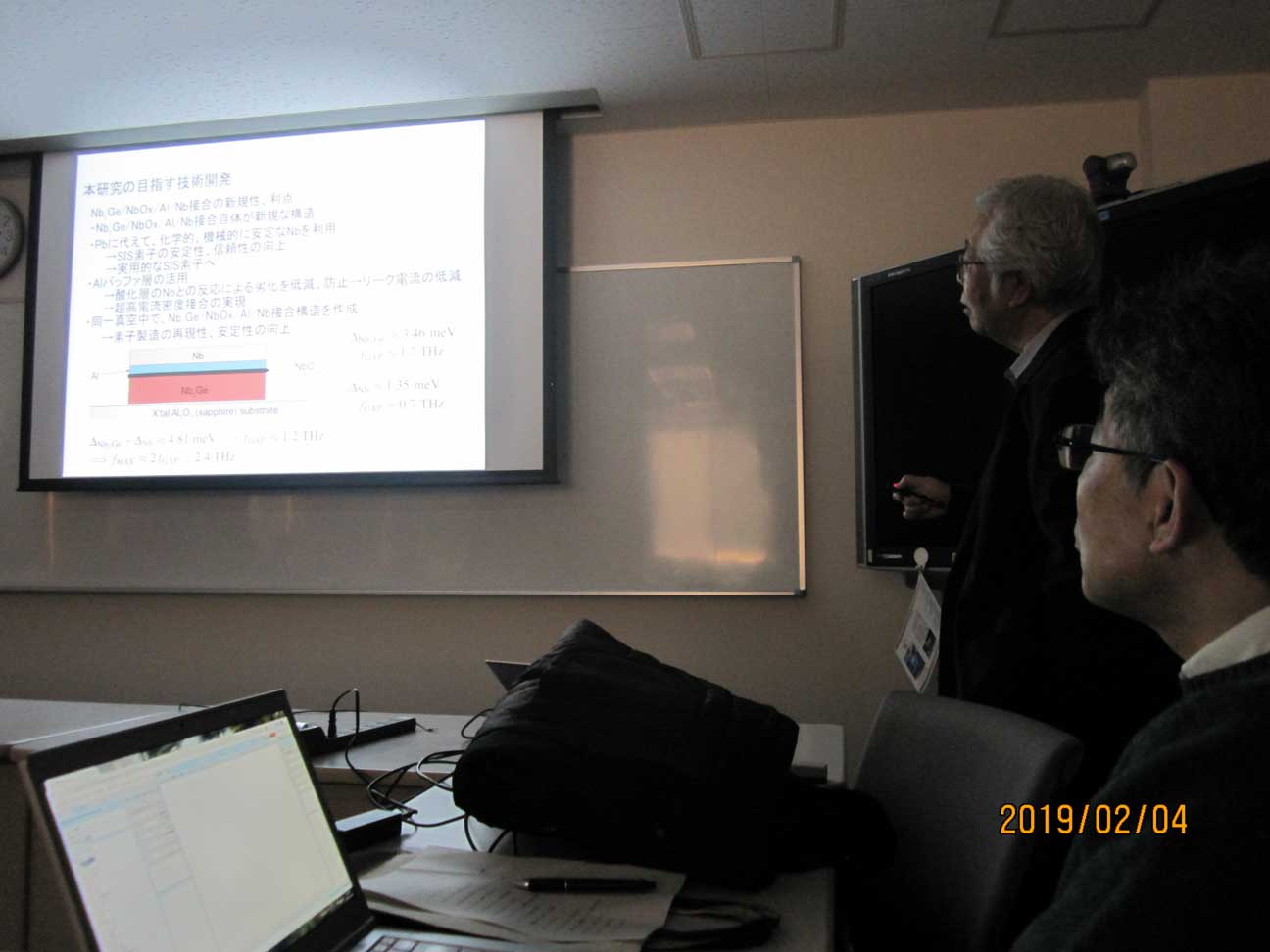
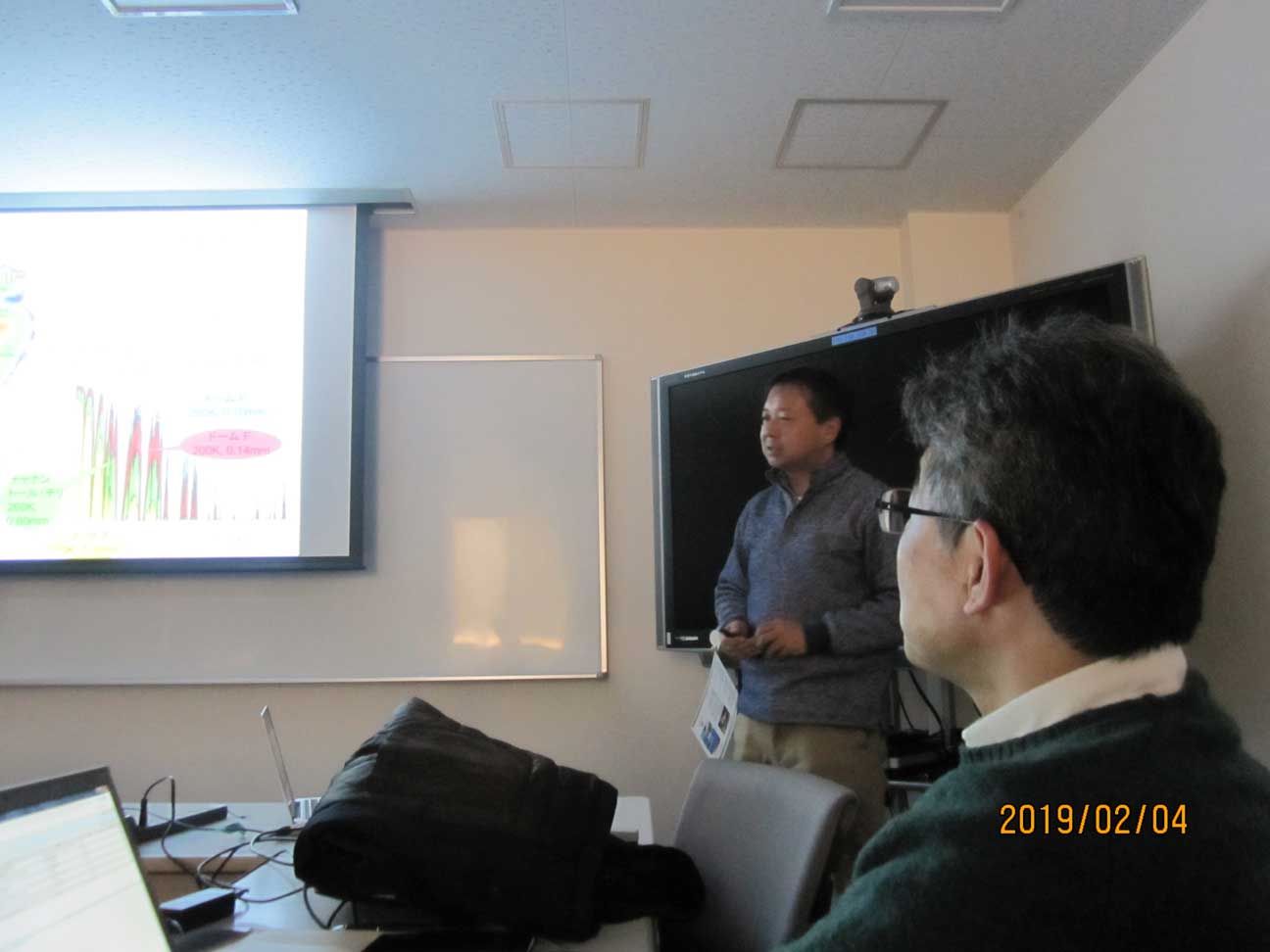
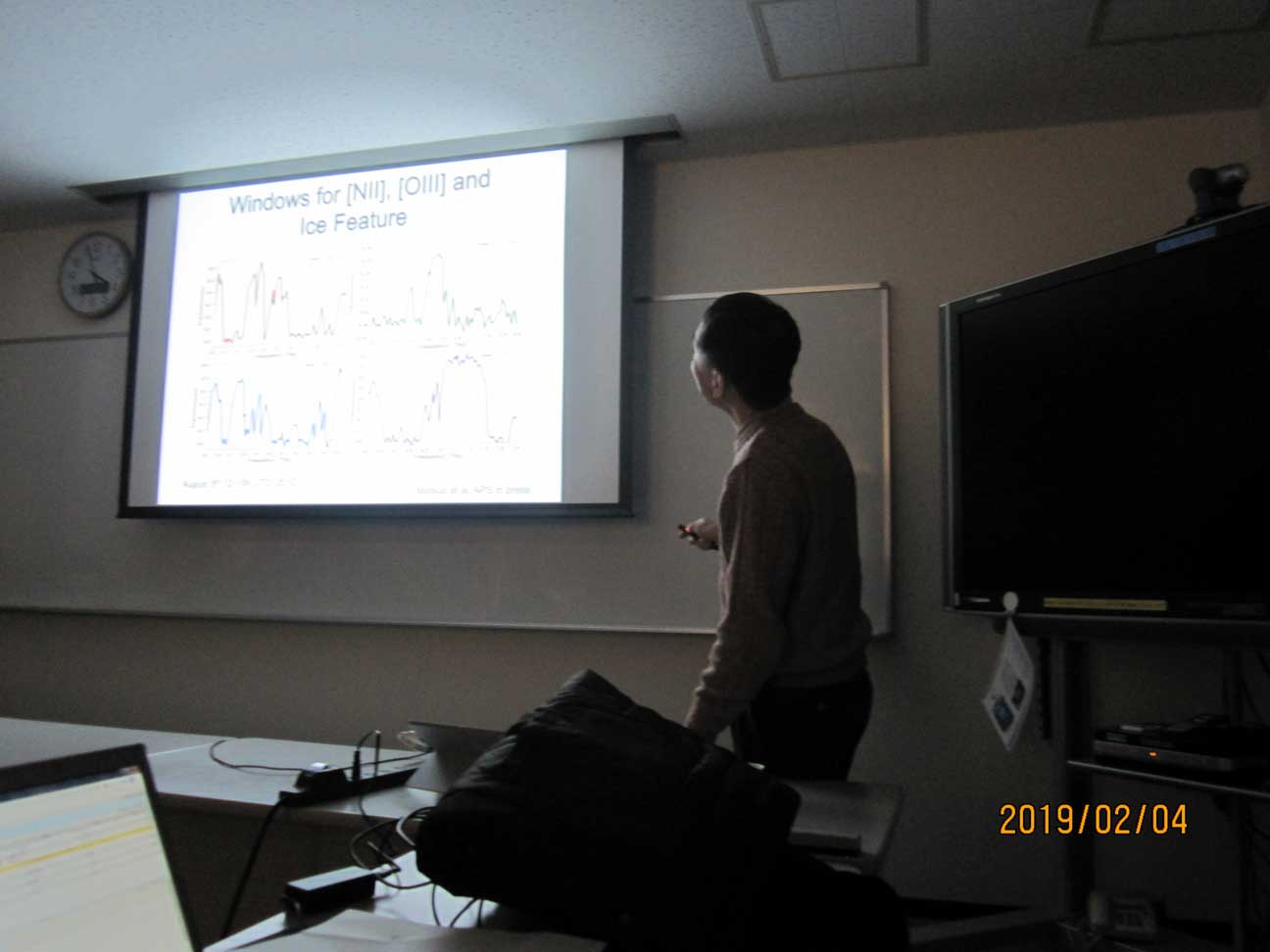
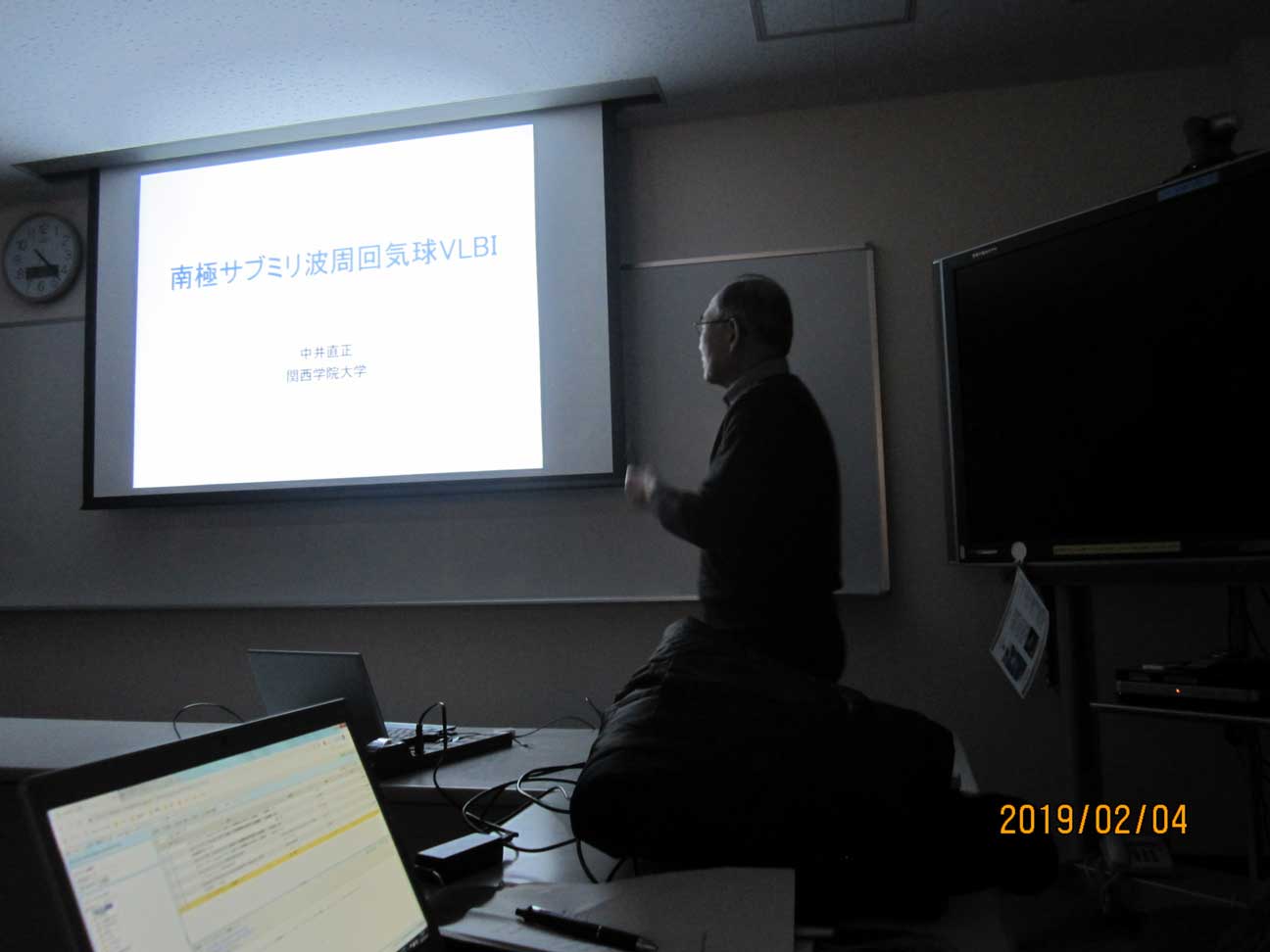
Elementary Particles 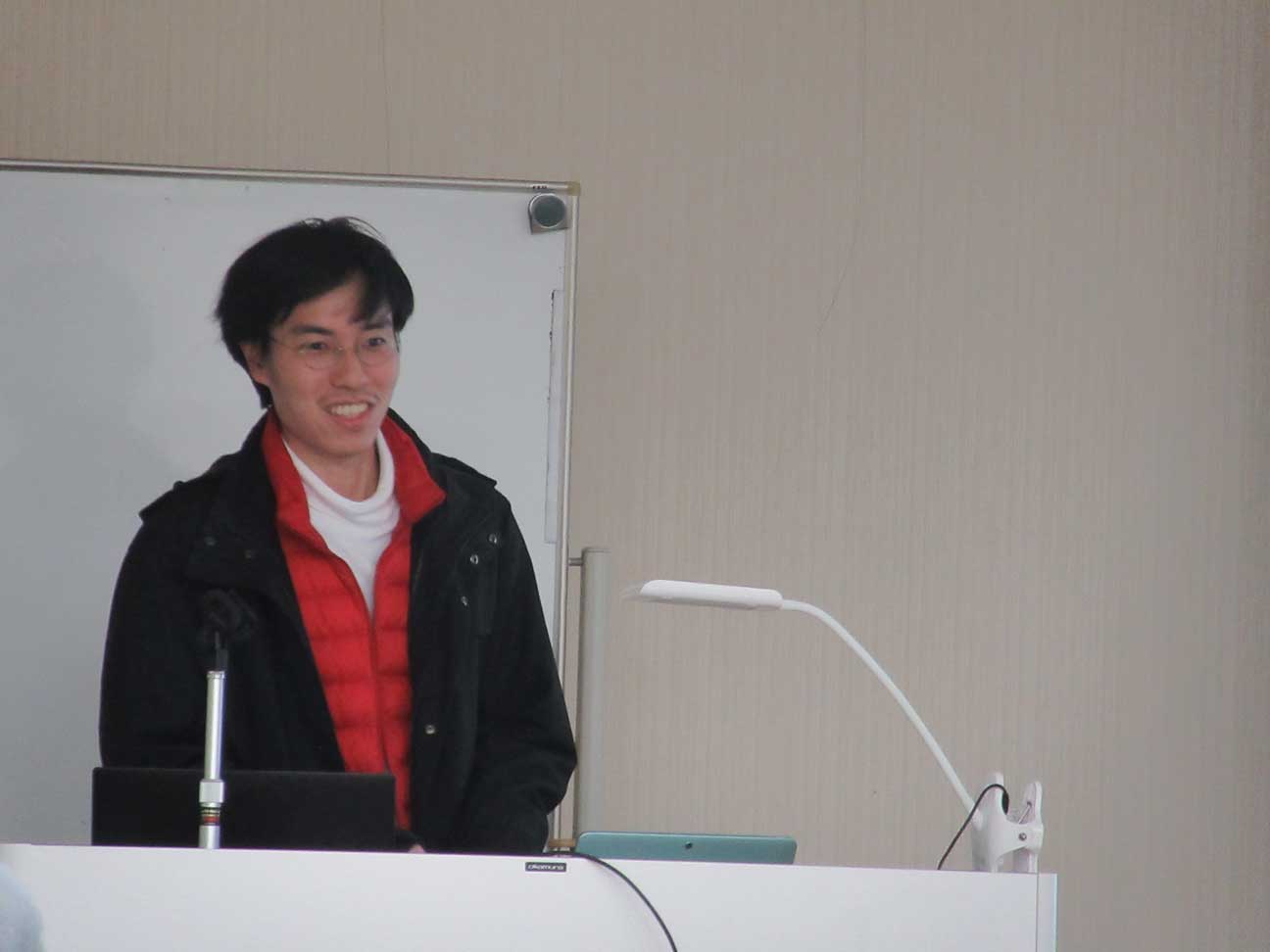
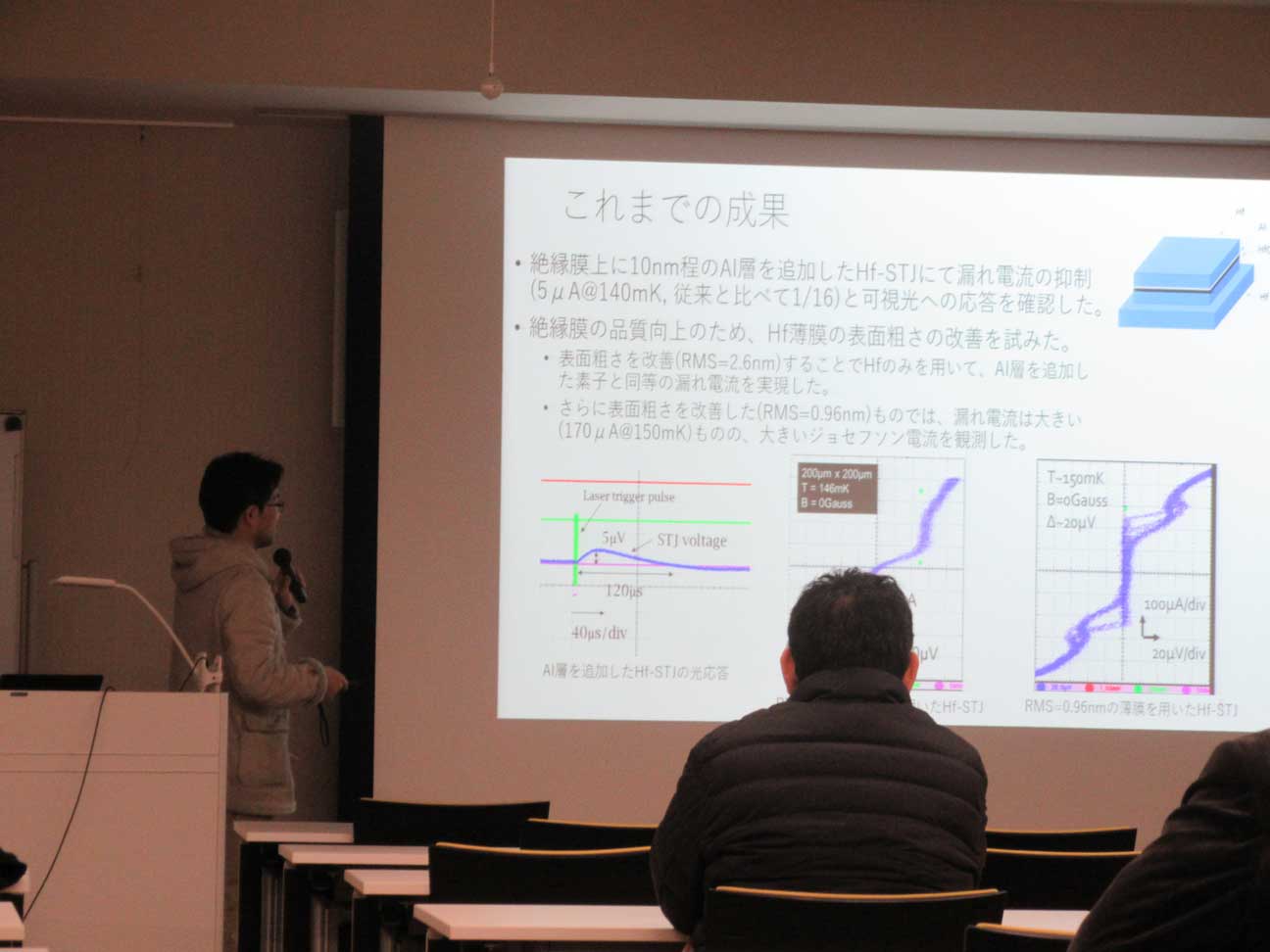

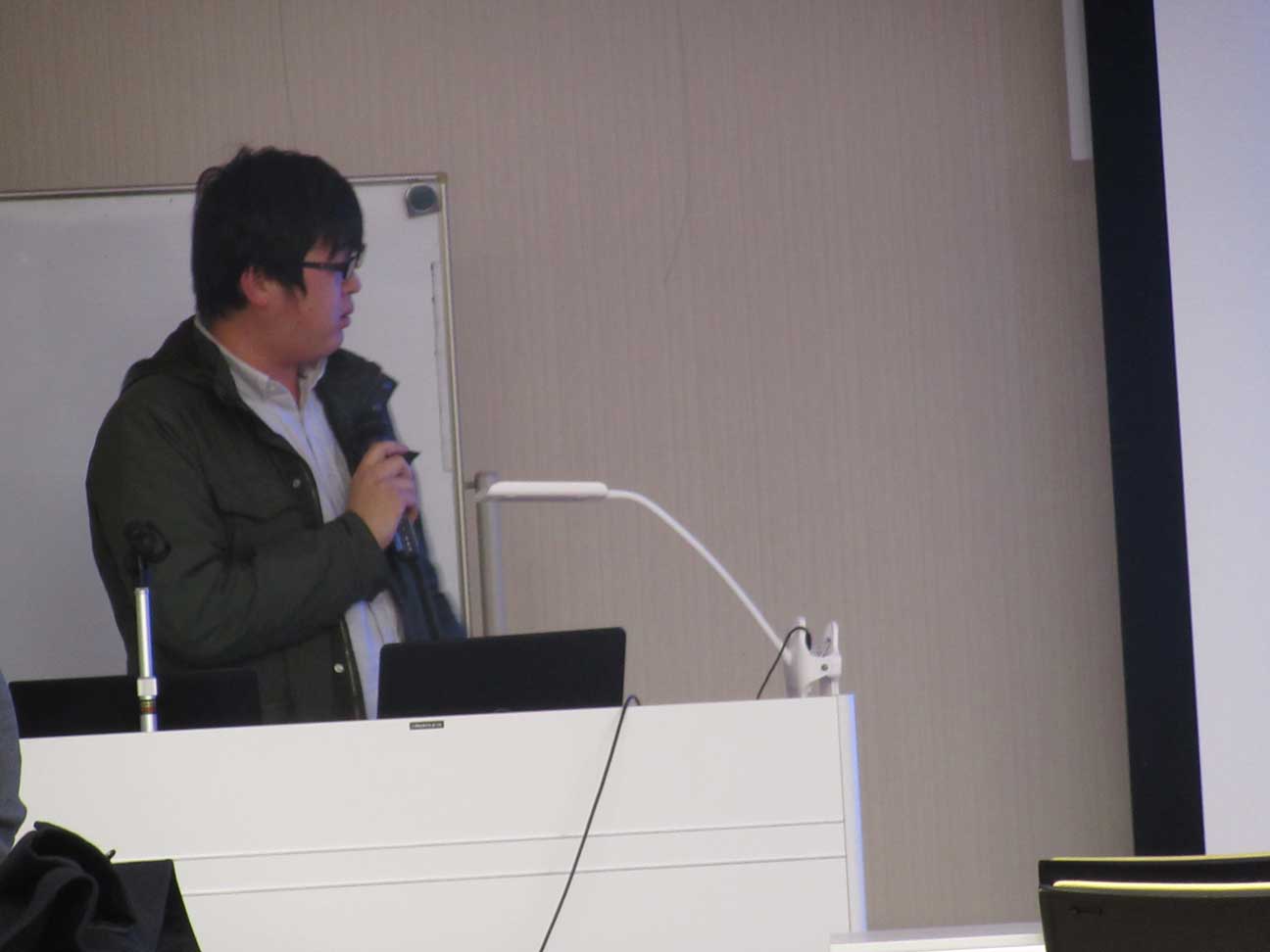
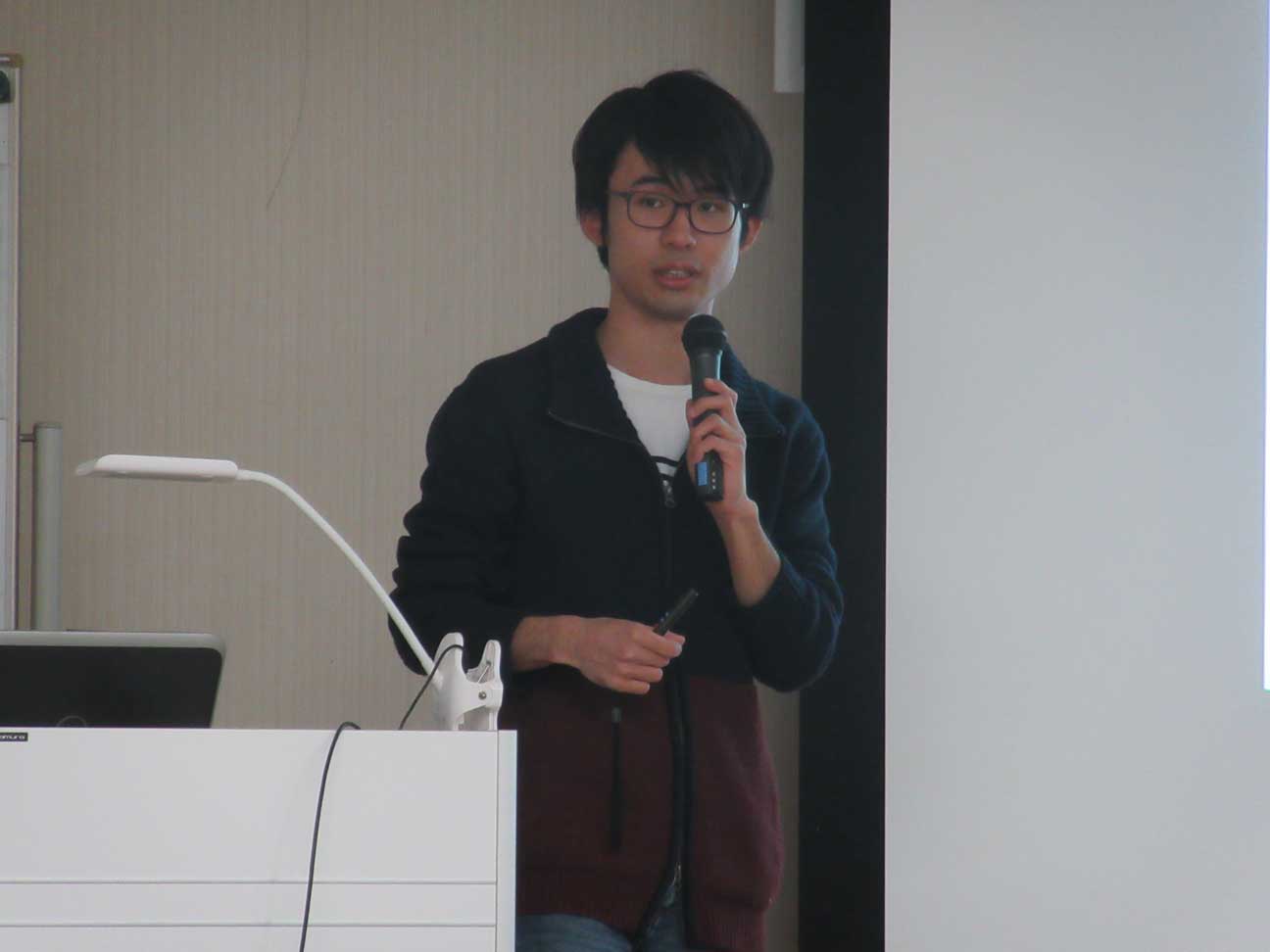
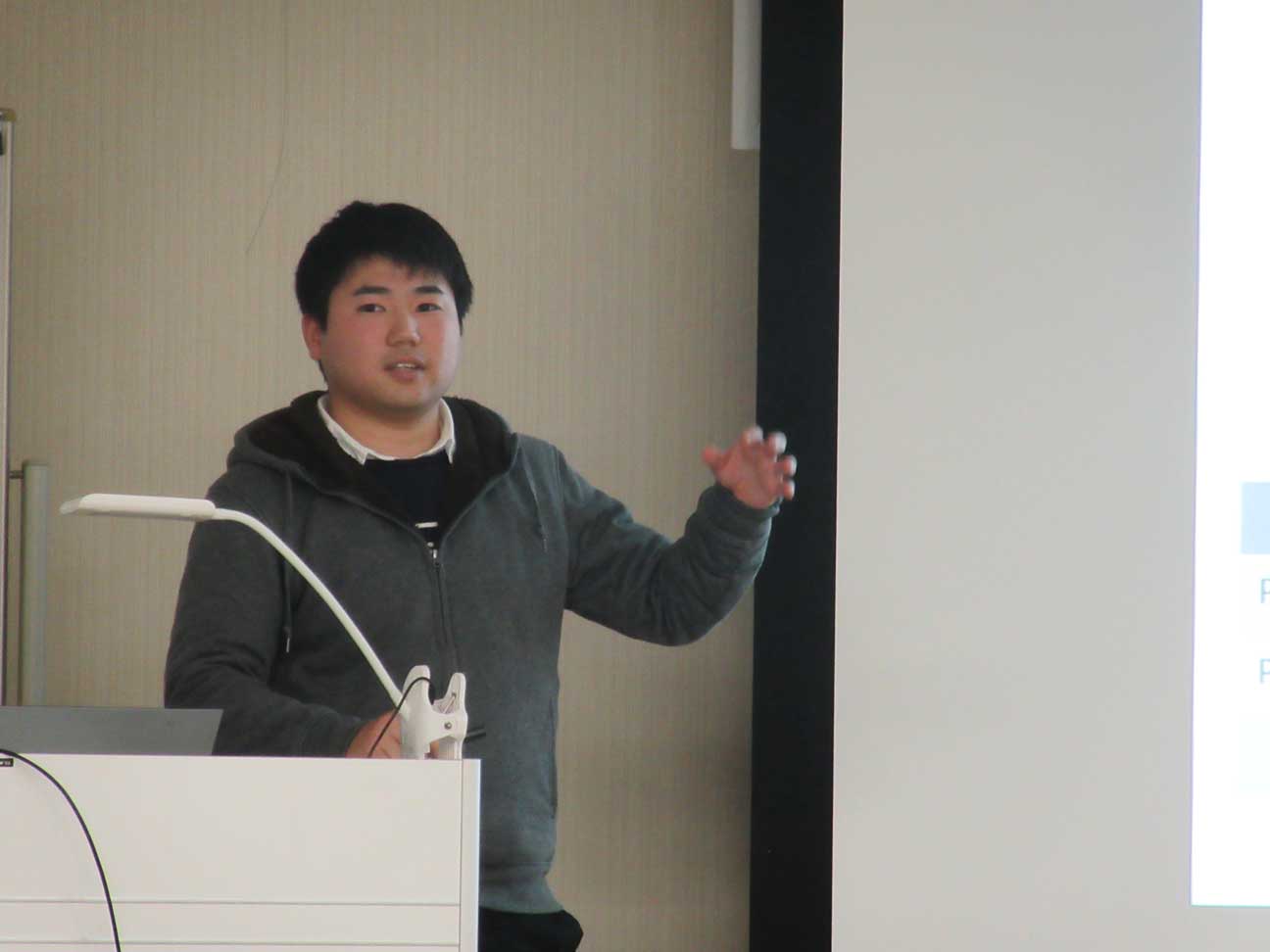
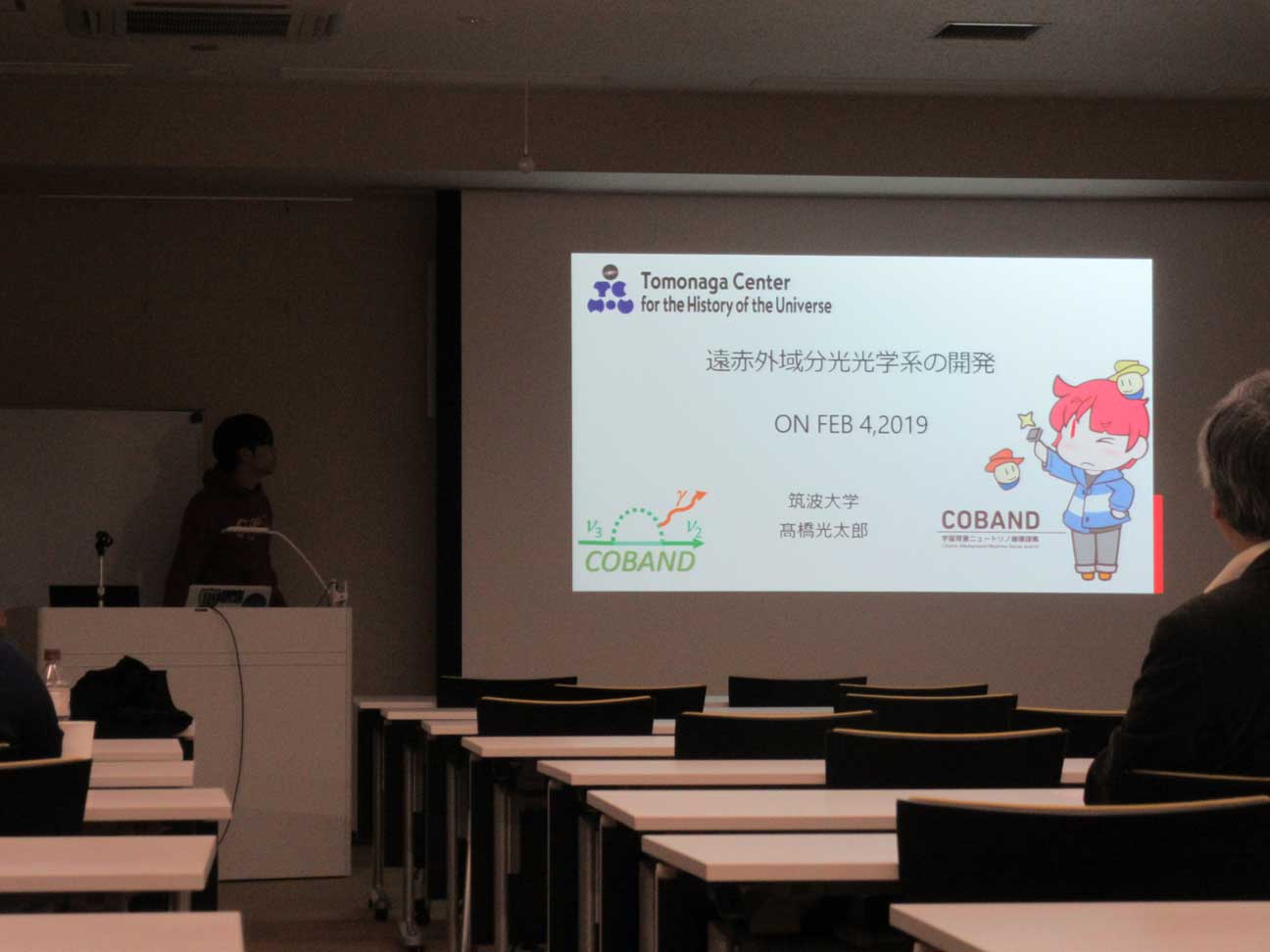
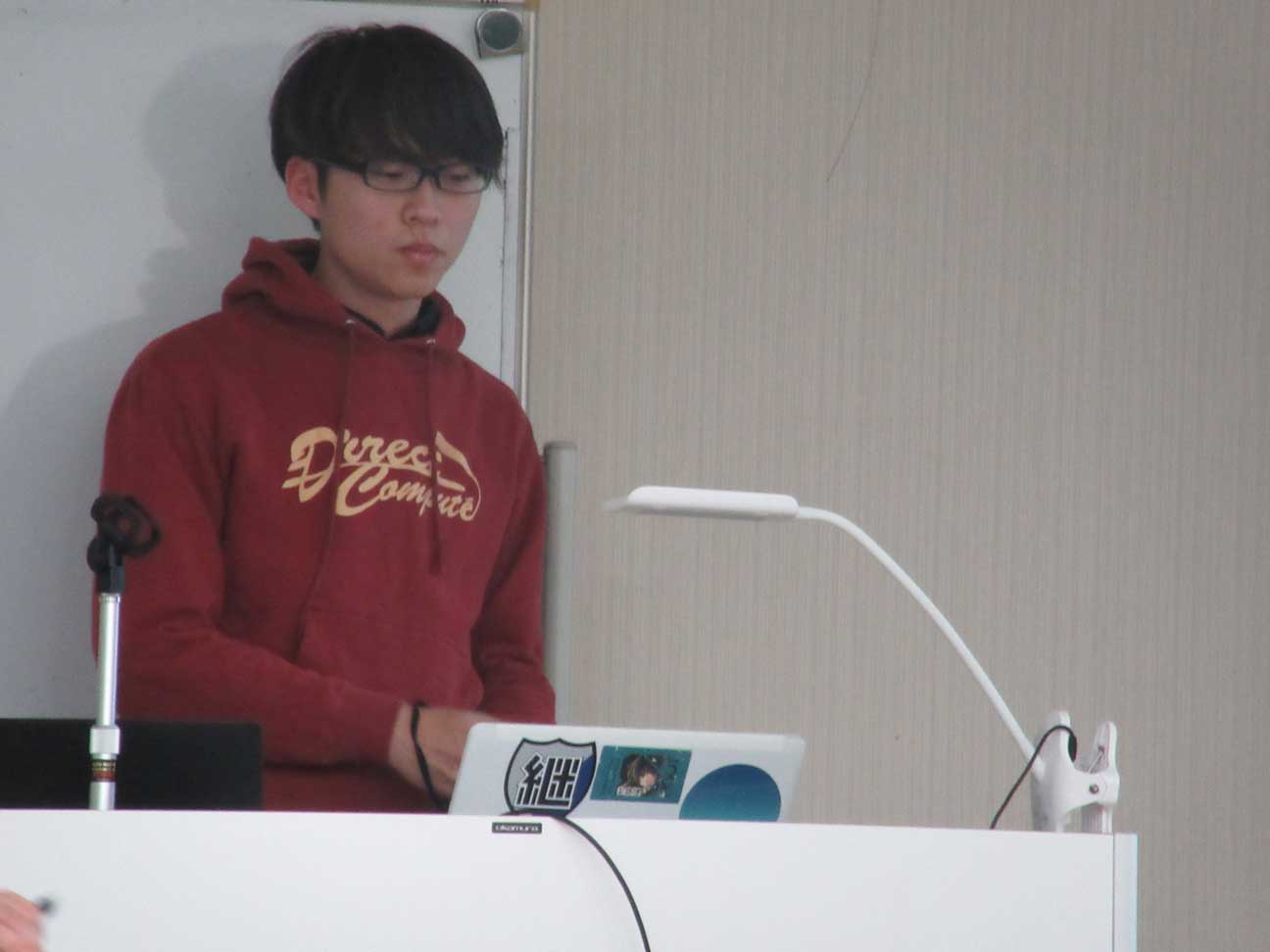
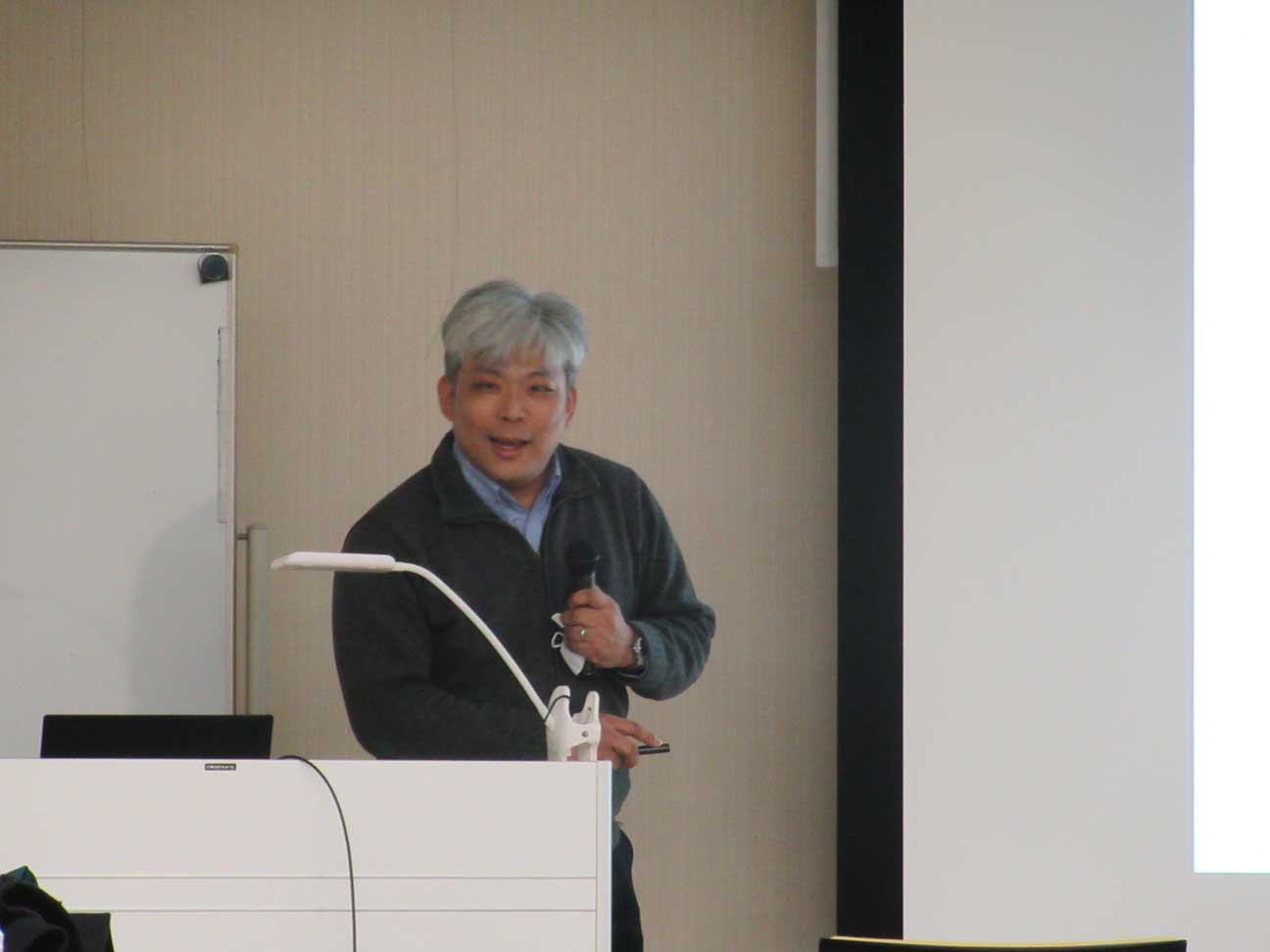
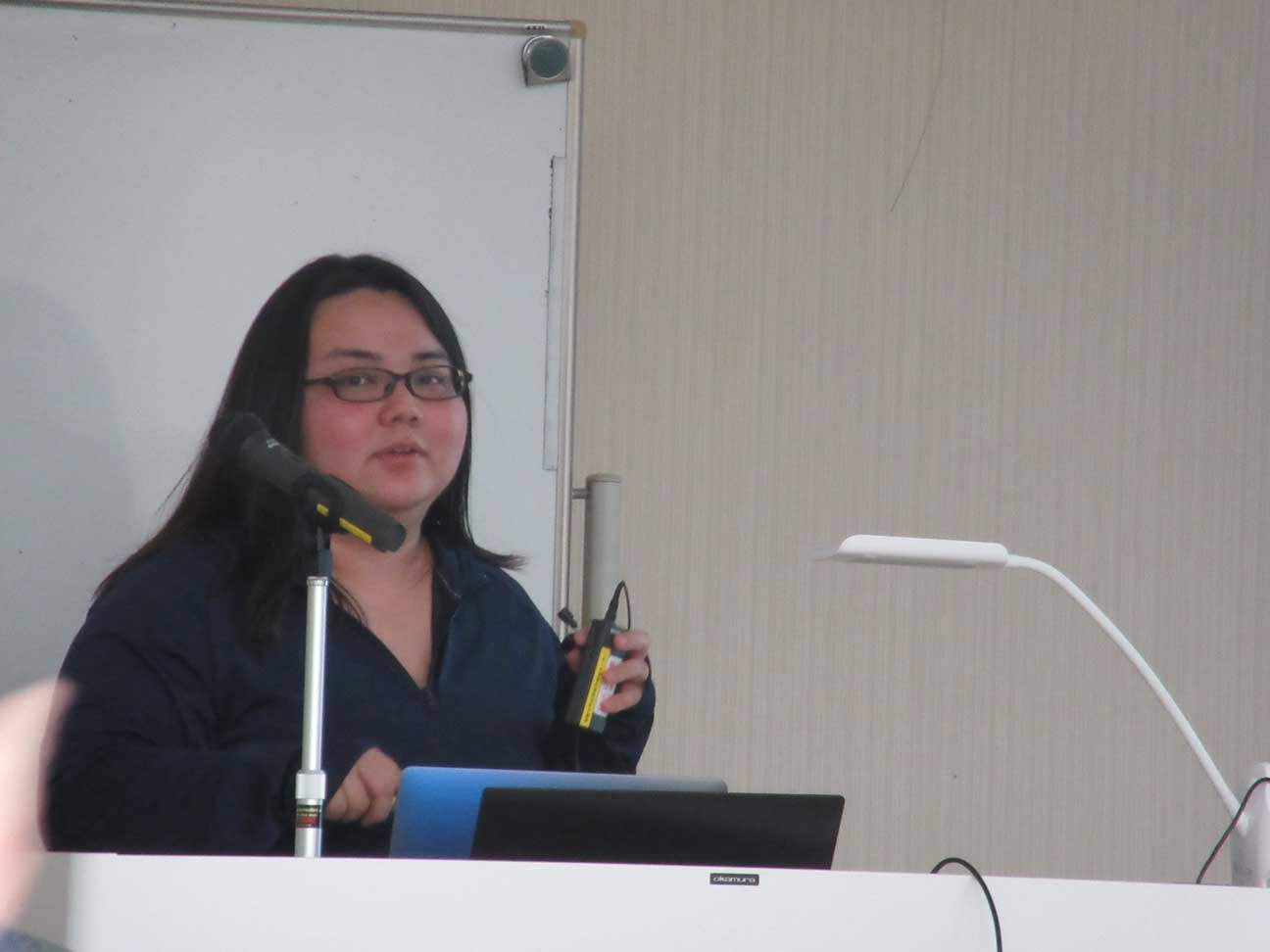
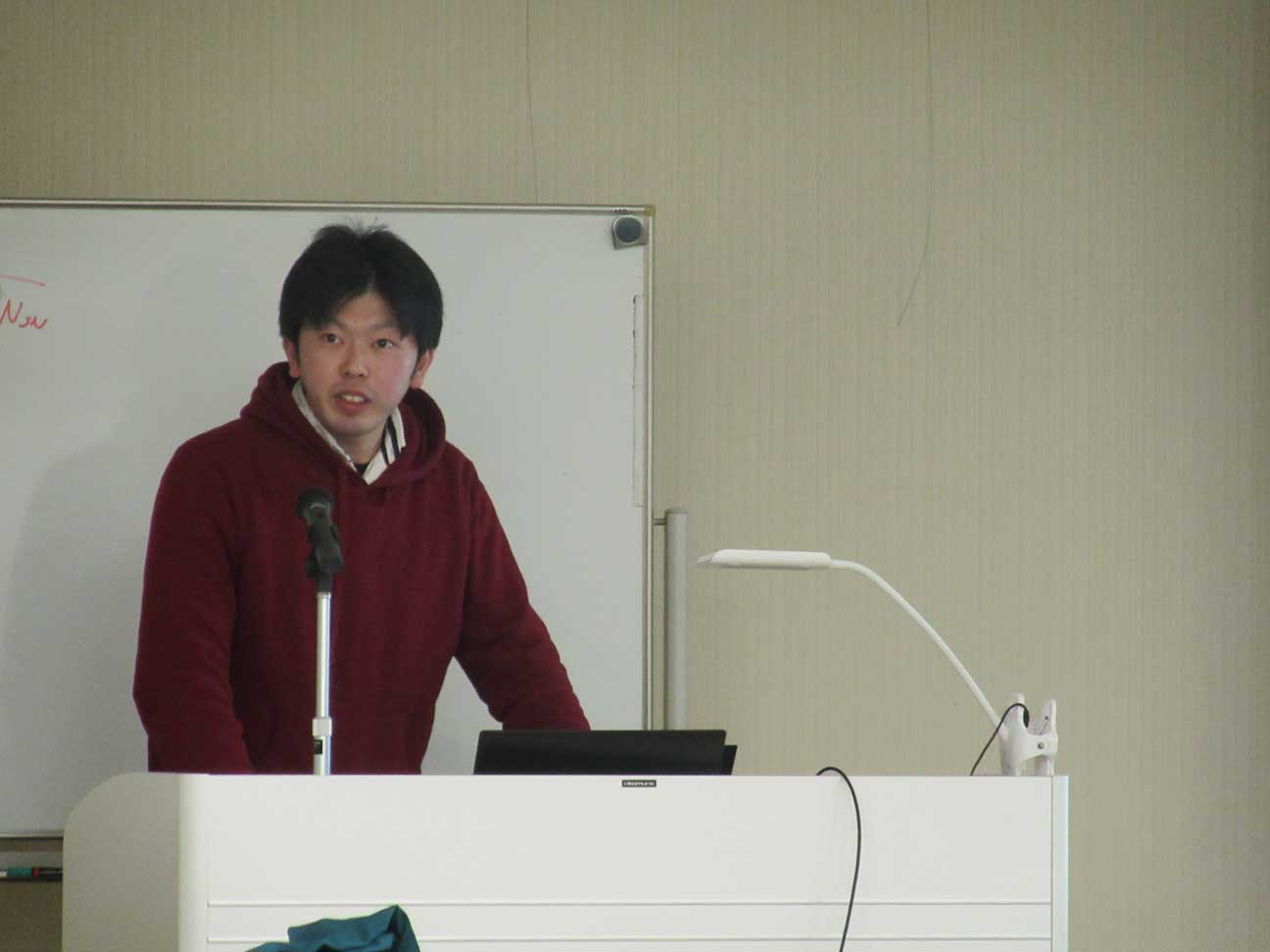
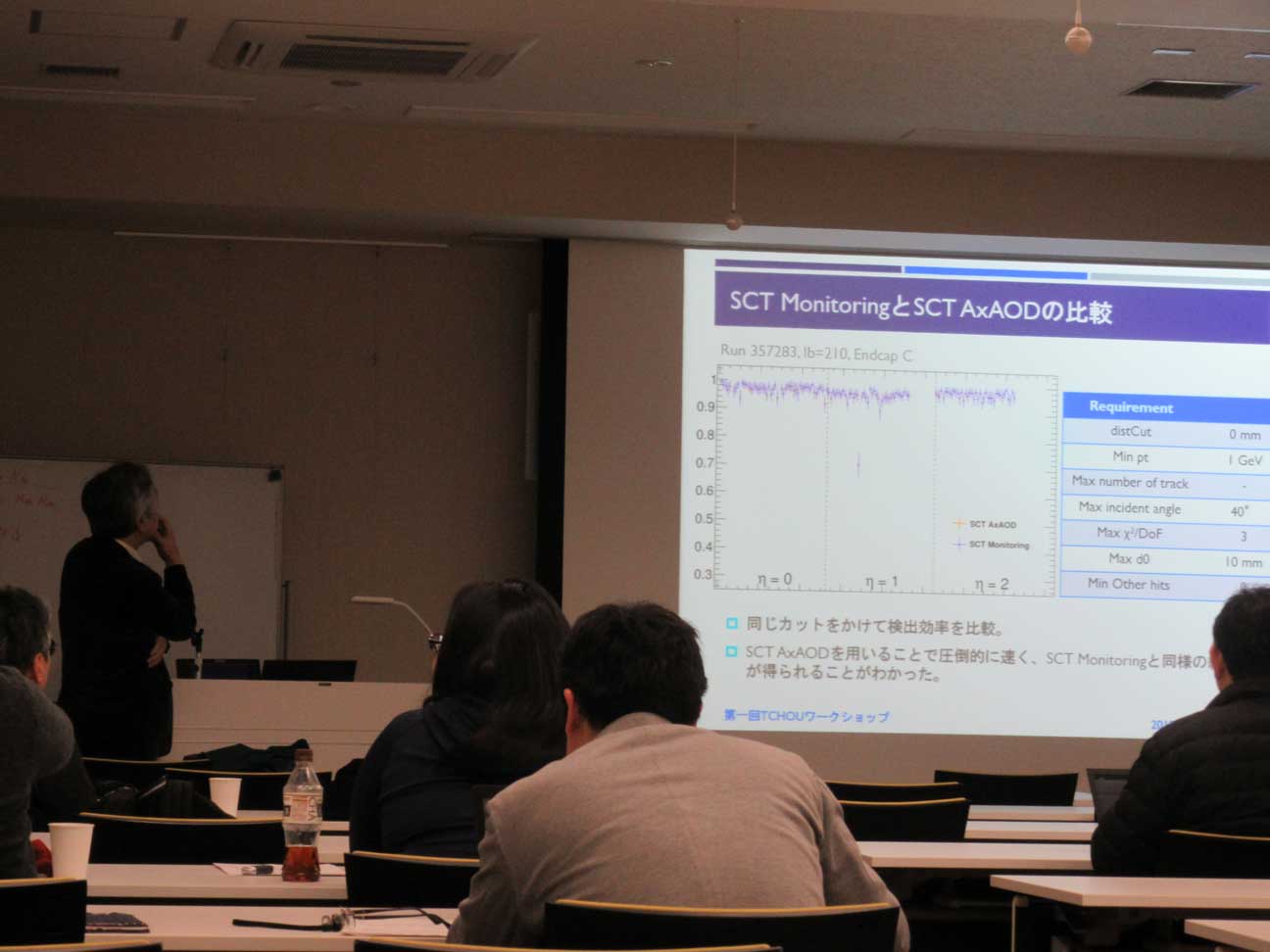
Quark Nuclear Matters 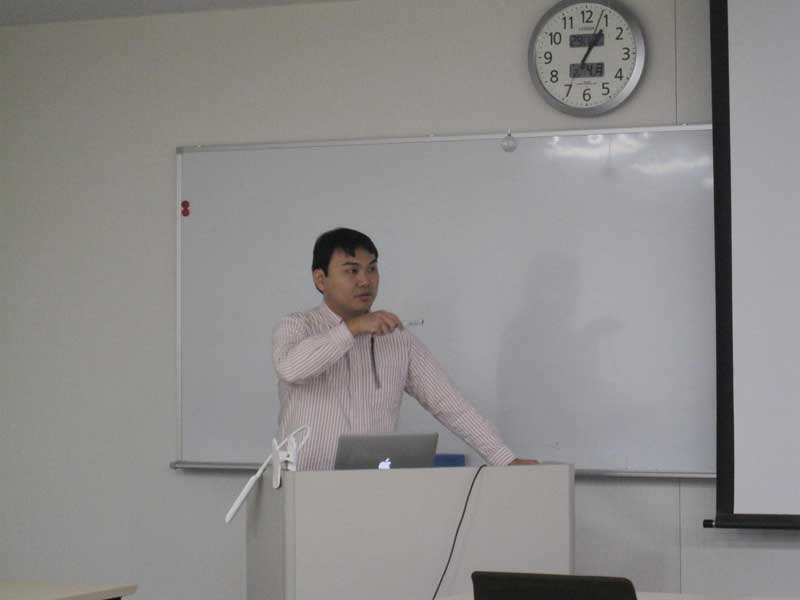
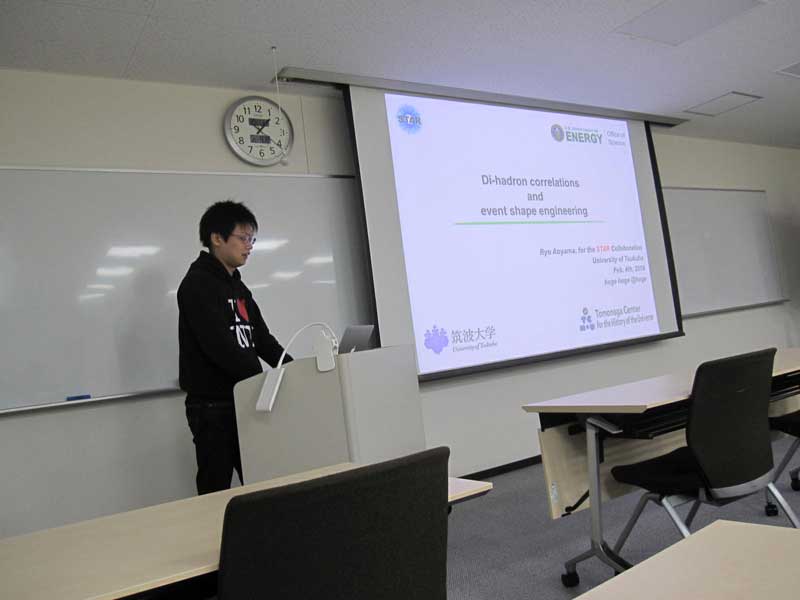
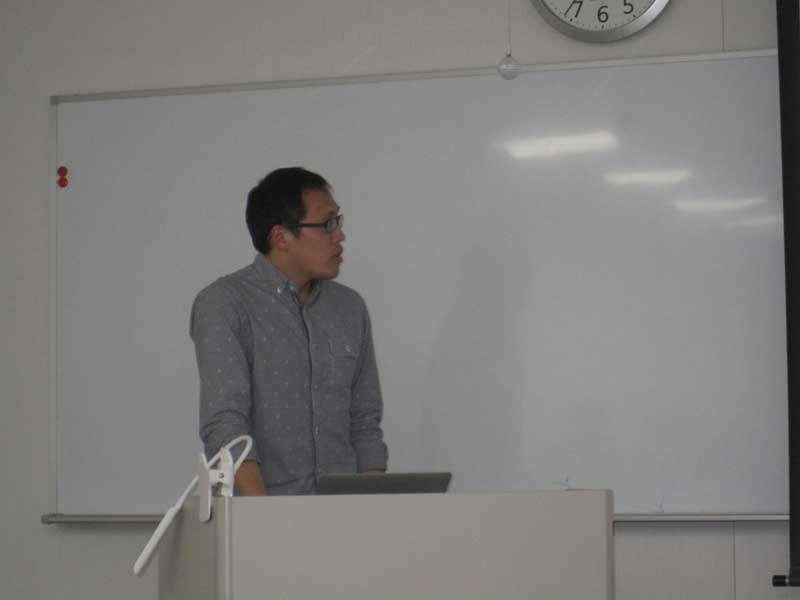
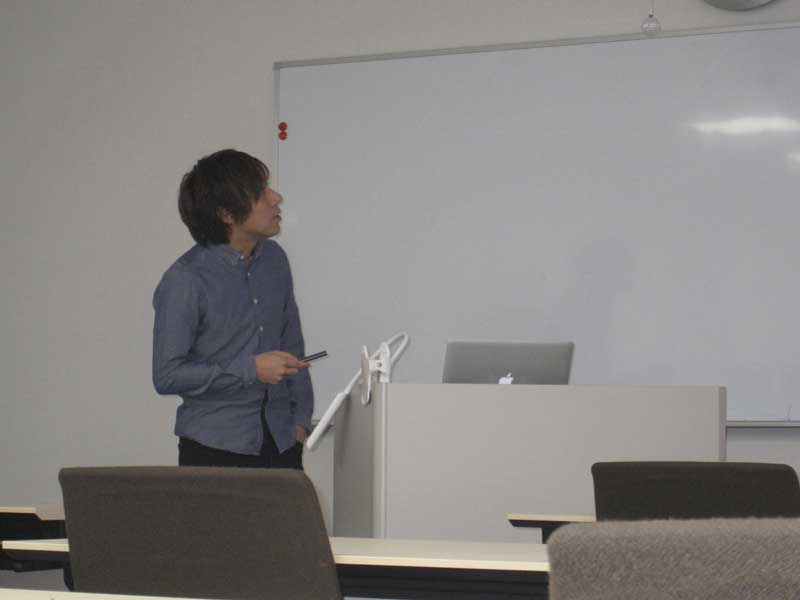
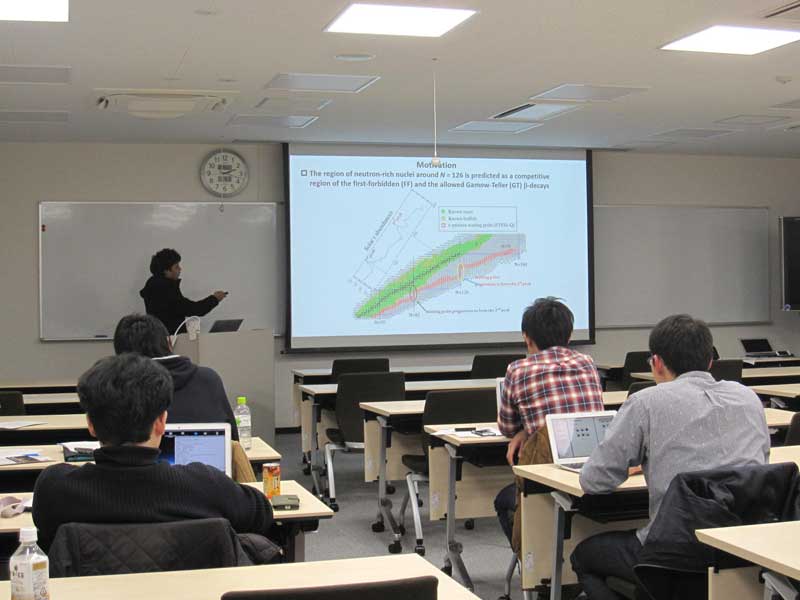
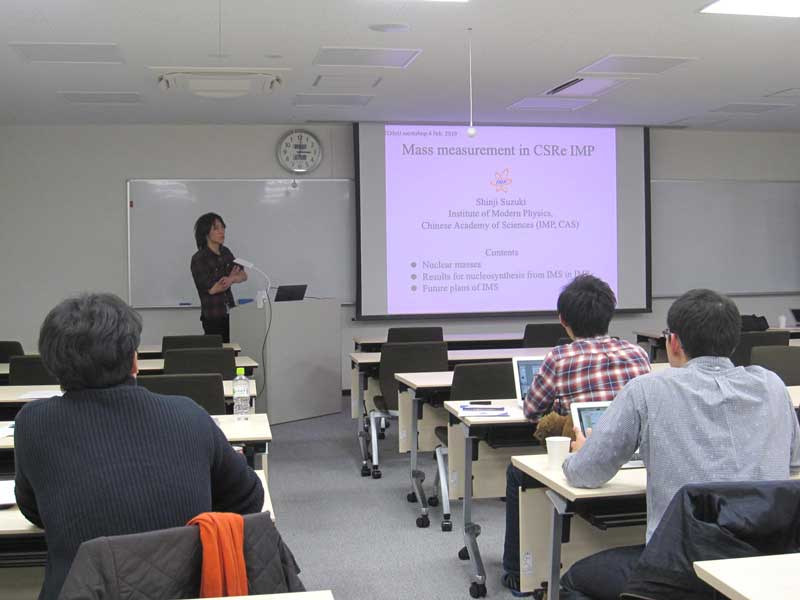
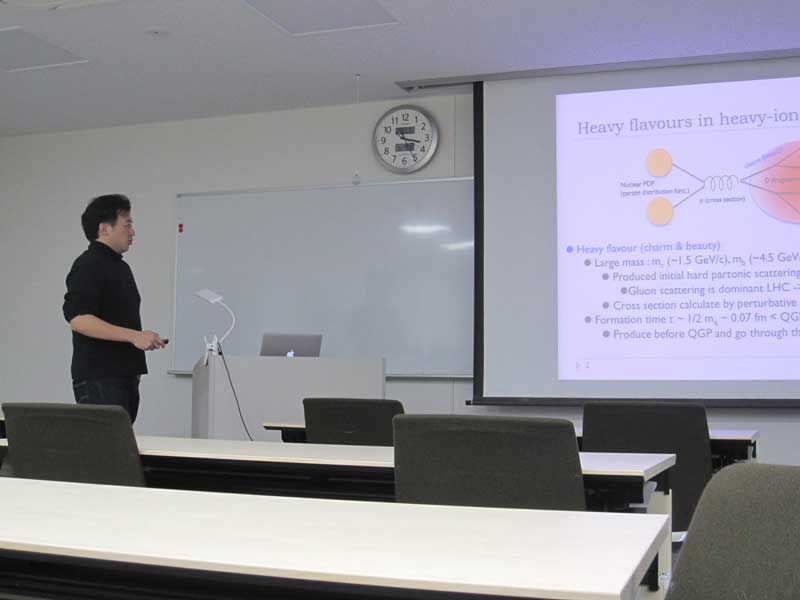
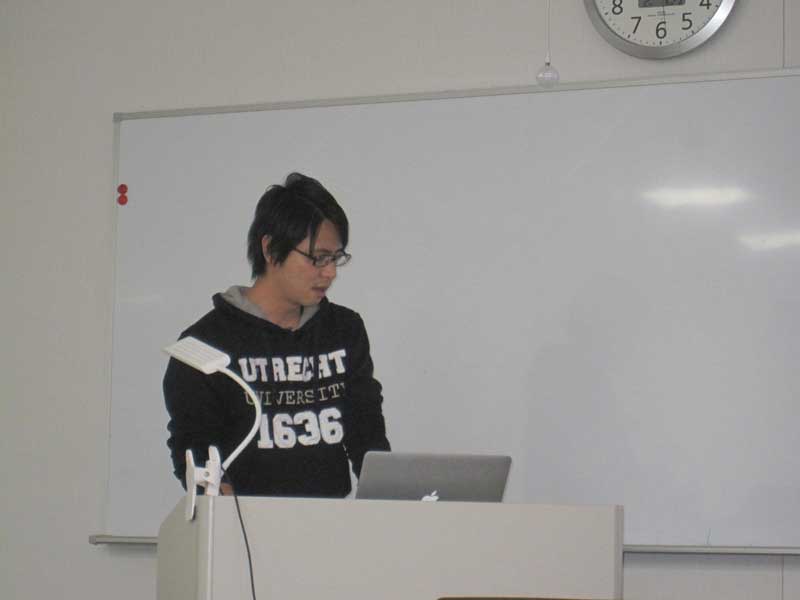
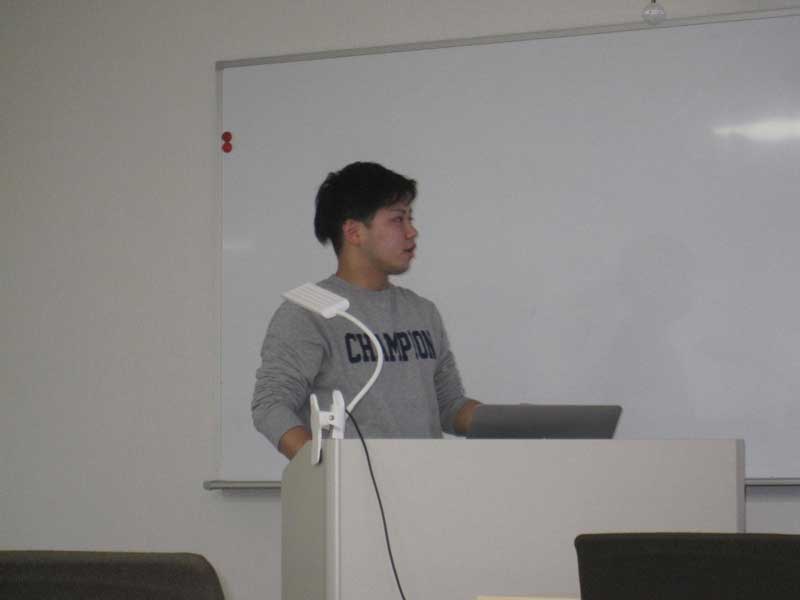
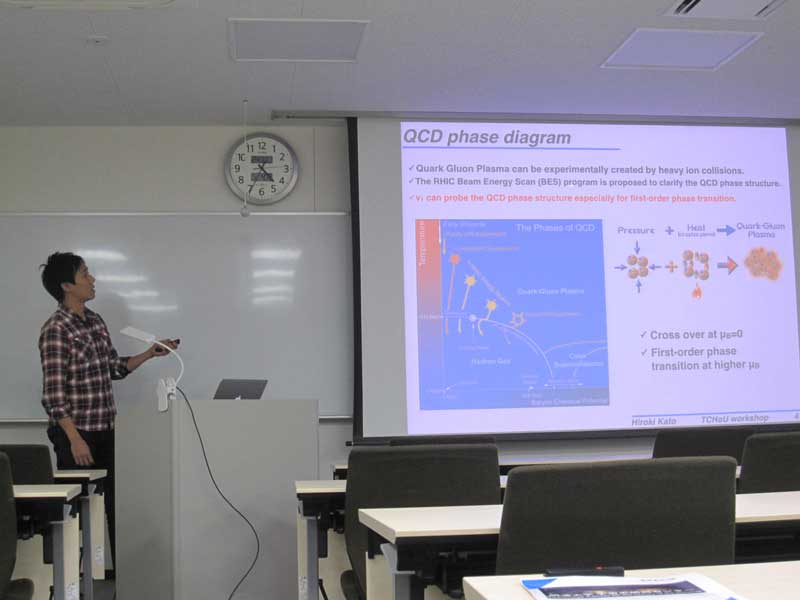


Photon and Particle Detectors 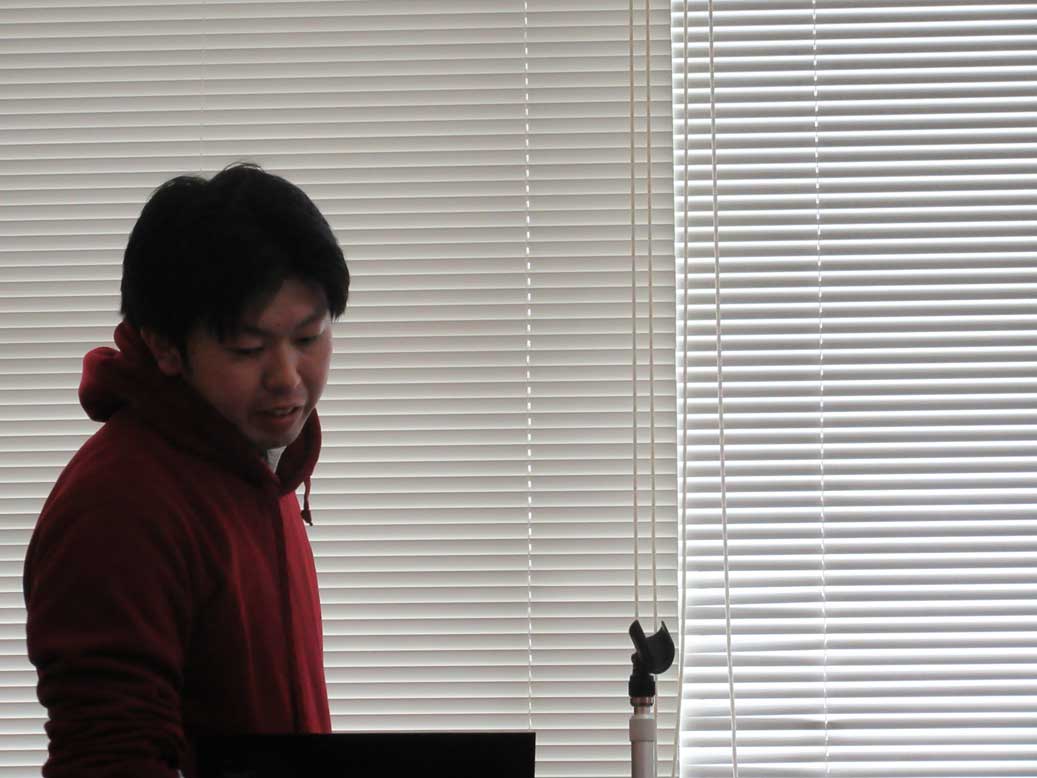
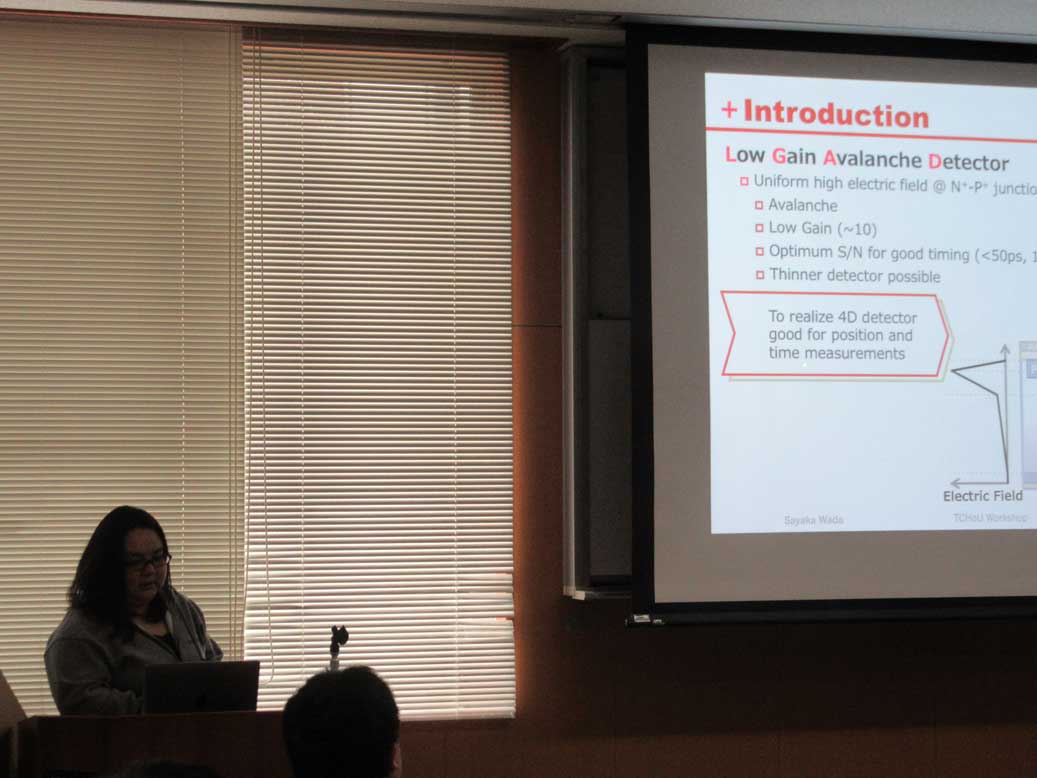
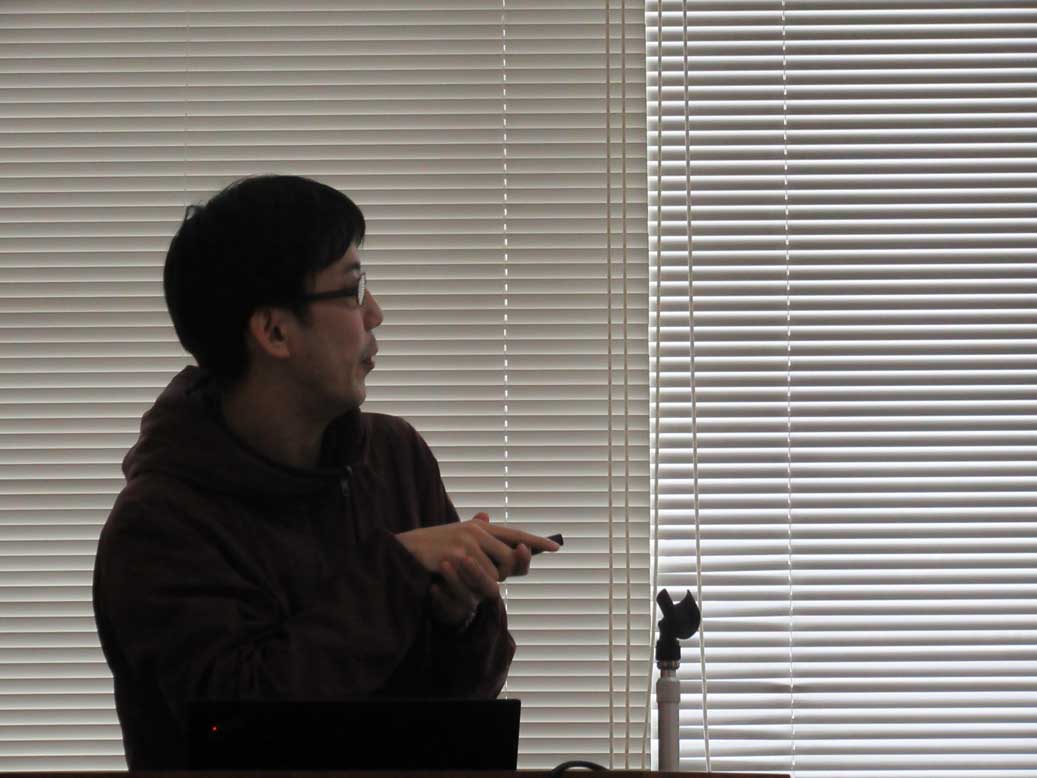
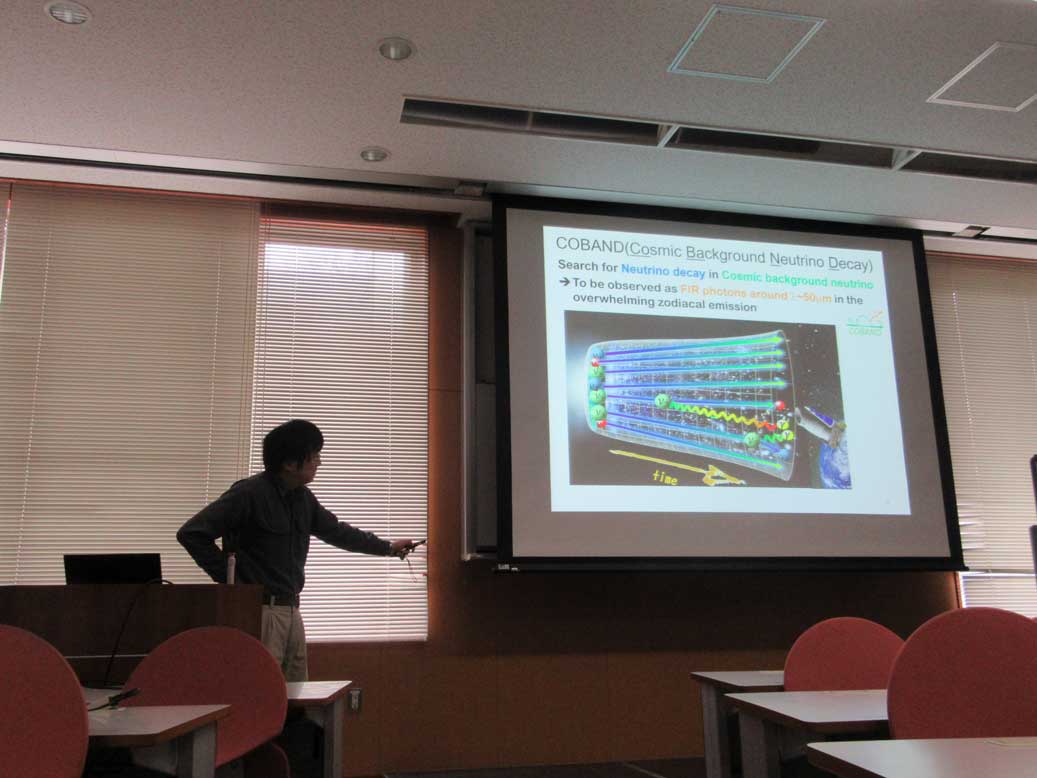
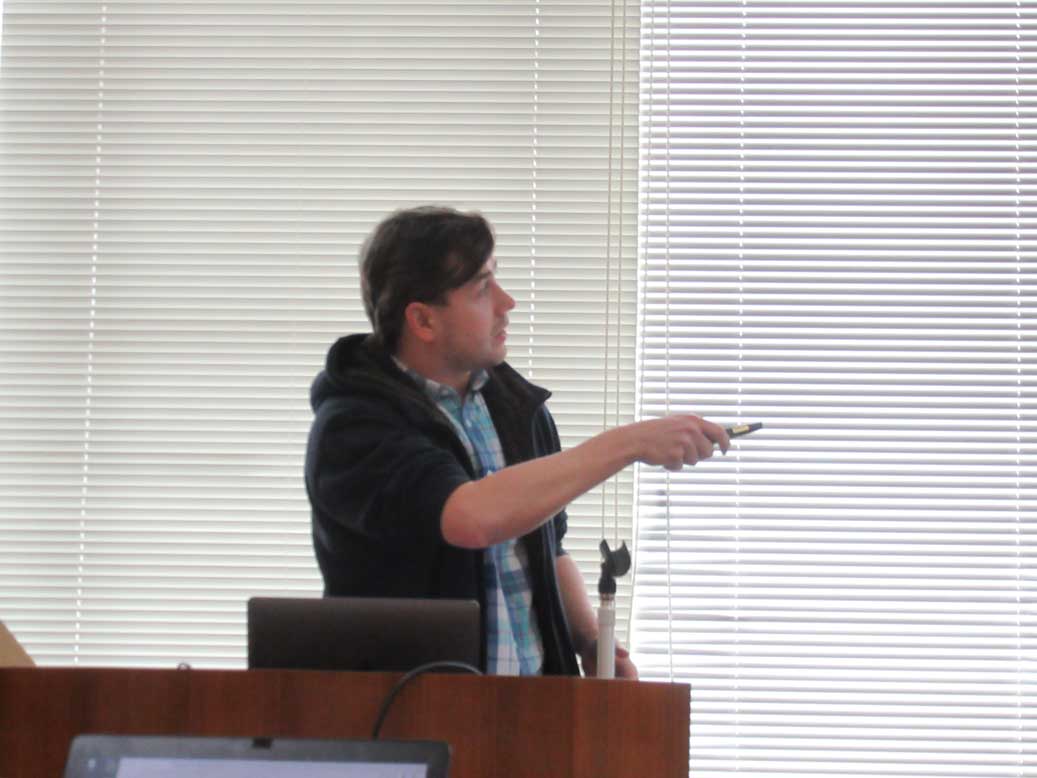
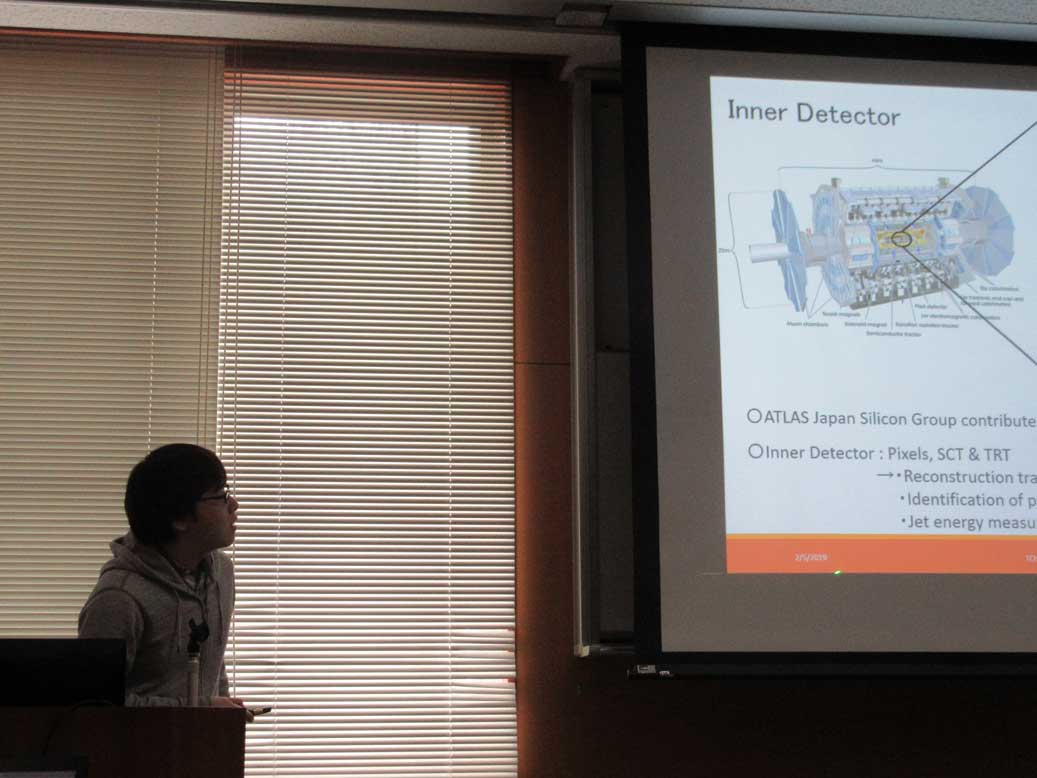
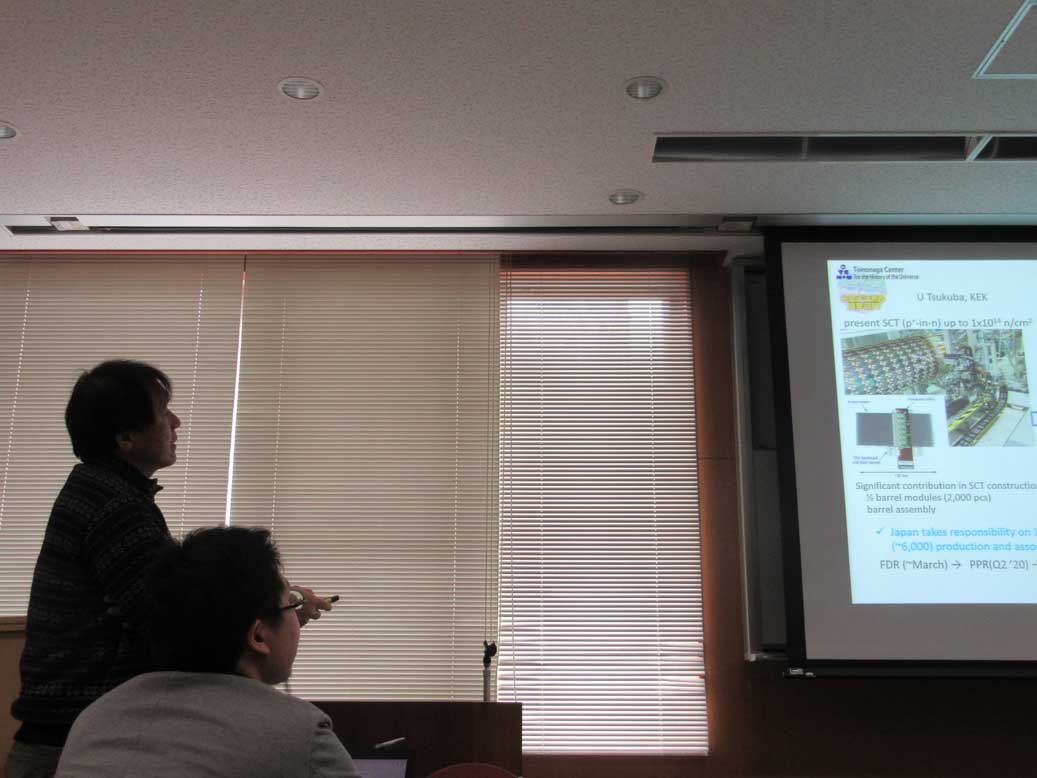
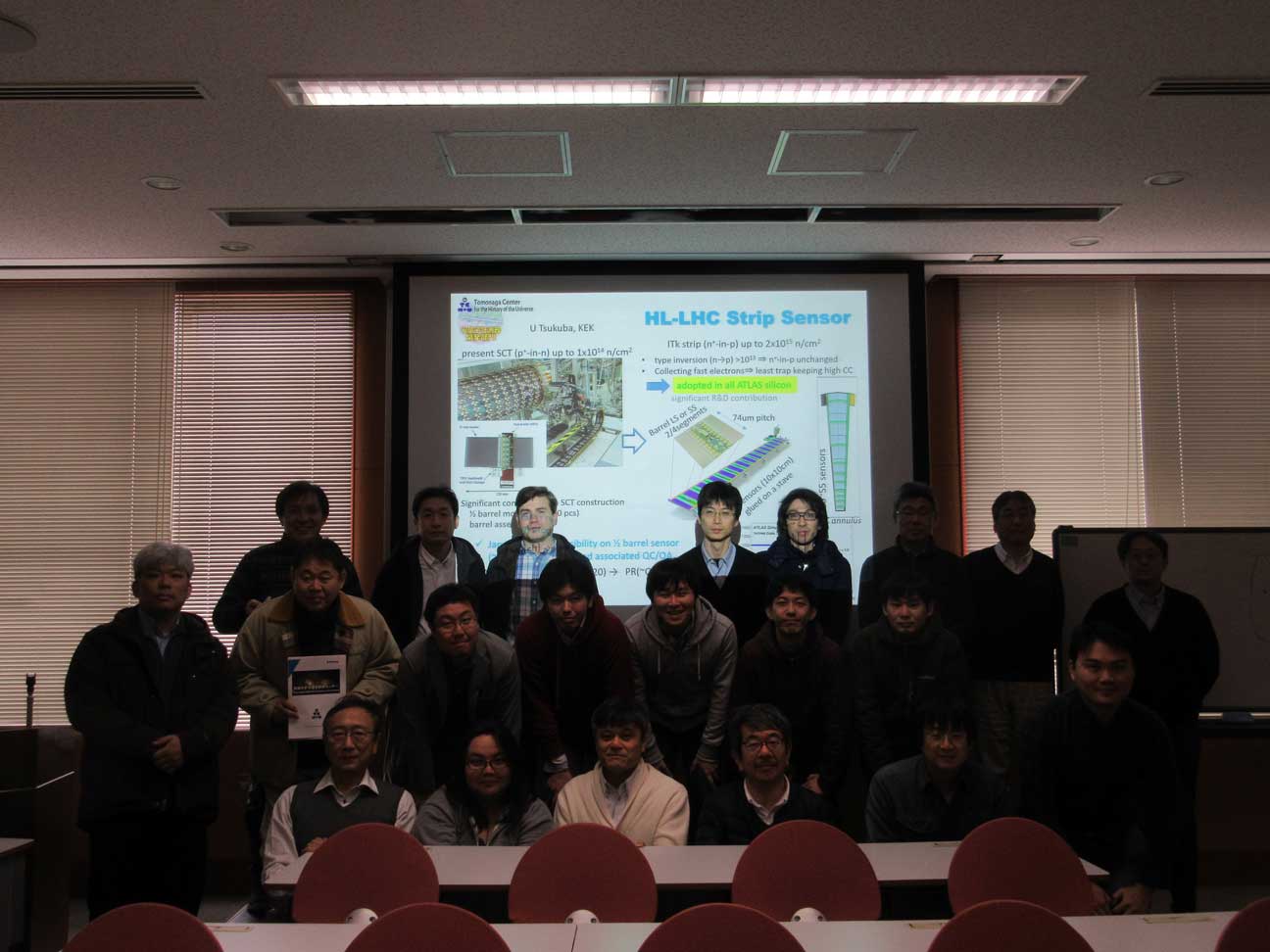
Contact: Asso.Prof. Y. Takeuchi
- 2019/01/28 3rd Workshop on "3D Semiconductor Imaging Sensor"
will be held at EPOCAL (Tsukuba). This workshop is organized by members from KEK, AIST, U Tokyo and U Tsukuba under TIA KAKEHASHI program.
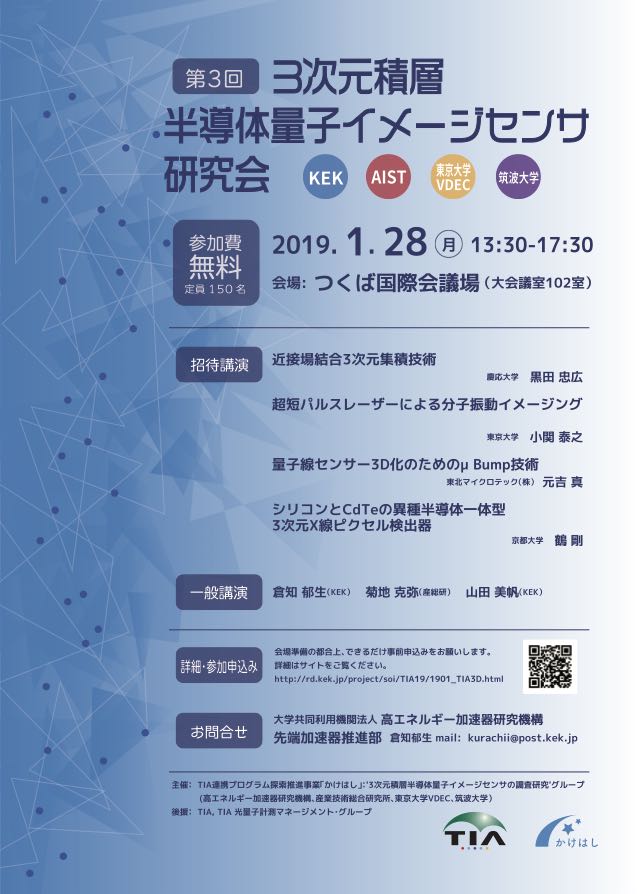
- Date: Jan 28, 2019 (Mon) 13:30-17:30
- Venue: Tsukuba EPOCHAL Room 102
- Website: http://rd.kek.jp/project/soi/TIA19/1901_TIA3D.html
- Registration:
- Online registration by Jan 25, 2019 (Fri) at the website.
- On the day registration is also possible.
- Registration fee free.
- Number of participants: 55
Imaging sensors detecting visible lights, X-rays and charged particles require innovations such as in sensitivity enhancement by hybridization of different materials, large-scale integration of fine size pixels, high-speed image transfer, and dynamic-range improvement for next stage applications in scientific, medical and industrial areas.
One of the promising solutions is a 3D integration technology stacking different materials/chips vertically. This workshop is organized under a TIA-Kakehashi program "3D semiconductor quantum imaging sensor" (KEK-AIST-U Tokyo-U Tsukuba) to discuss directions of research activities with presentations on latest 3D integration technology and quantum imaging sensor technology.
Visit the website for the program.
Contact: Asso.Prof. K. Hara
- 2019/01/17 HoU Seminar
- Date: 17 Jan 2019 (Thu) 13:45-15:00
- Venue: Natural Science Bldg. B, Room B118, Univ. Tsukuba
- Speaker: Prof. Soo-Bong Kim (SNU/TCHoU)
- Title: Variation of Observed Reactor Antineutrino Yield at RENO
- Abstract:
- The Reactor Experiment for Neutrino Oscillation(RENO) started data-taking from August, 2011 and has observed the disappearance of reactor electron antineutrinos to measure the smallest neutrino mixing angle theta13. The experiment has analyzed roughly 2200 days of data to make an accurate measurement of the oscillation amplitude and frequency based on energy and baseline dependent disappearance of reactor antineutrinos. RENO’s precisely measured flux and spectral shape of reactor antineutrinos has shown a deficit in the flux and an excess in the region of 5 MeV relative to the most commonly used model. Furthermore, it has observed fuel-composition dependent variation of reactor antineutrino yield and spectrum. We find that reevaluation of 235U’s antineutrino yield per fission may solve the reactor antineutrino anomaly. We also report a hint of correlation between the 5-MeV excess and the 235U fuel isotope fraction.
- Slide: presentation file
- Number of participants: 12



Contact: Asso.Prof. Y. Takeuchi
- 2018/12/14 HoU Seminar
- Date: 14 Dec 2018 (Fri) 13:45-15:00
- Venue: Natural Science Bldg. B, Room B118, Univ. Tsukuba
- Speaker: Hidetoshi Otono (Kyushu University, Research Center for Advanced Particle Physics)
- Title: Hidetoshi Otono, Kyushu University, Research Center for Advanced Particle Physics
- Number of participants: ca. 15
Contact: Prof. F. Ukegawao
- 2018/12/10 HoU Seminar
- Date: 10 Dec 2018 (Mon) 16:00-17:00
- Venue: Bldg. 1F, Room 1F201, Univ. Tsukuba
- Speaker: Jinfeng Liao (Physics Department and Center for Exploration of Energy and Matter, Indiana University)
- Title: Chirality, Vorticity and Magnetic Field in the Subatomic Swirls
- Abstract:
- By colliding heavy ions at high energies, physicists are able to "break up" nuclear particles like protons and neutrons and create a hot "subatomic soup" - a new form of matter called a quark-gluon plasma (QGP). Experiments at the Relativistic Heavy Ion Collider (RHIC) and the Large Hadron Collider (LHC) have found the QGP to be a nearly perfect quantum fluid over the past decade. Very recently, there emerged compelling evidences that the hot fluid formed in these collisions behaves like "subatomic swirls" carrying a large angular momentum with the resulting nontrivial fluid vorticity field as well as a super-strong magnetic field. The nontrivial interplay between such extreme fields and the spin degrees of freedom of the underlying microscopic constituents, leads to a number of novel quantum phenomena that have triggered widespread enthusiasm. In this talk, I will discuss two remarkable examples, the global spin polarization of produced hadrons and the tantalizing anomalous transport via so-called Chiral Magnetic Effect (CME).
- Number of participants: ca. 15
Contact: Asso.Prof. S. Esumi
- 2018/12/08 Workshop for development and applications of fast-timing semiconductor devices
Division of Photon and Particle Detectorsis organizing a Workshop on LGAD at the Tokyo Campus of the Univ. of Tsukuba.
Since the several successful operation demonstrations of low-gain avalanche detectors (LGAD), we are in a stage of further investigation on development and application possibilities using such fast-timing, ca. 30 ps, semiconductor devices which should realise a superior position resolution of O(10microns) at the same time. The workshop is organised to summarise the LGAD status and to discuss further R&D activities. Talks for ToF-PET application and ATLAS applications are foreseen.
- Date: 8 Dec. 2018 (Sat)
- Venue: University of Tsukuba, Tokyo Campus (Otsuka)
- Registration URL: registration
- Program:
- * Welcome and Introduction
- * Performance Evaluation of HPK Segmented LGAD
- * Timing results of HPK LGAD PD
- * Development of inverse-LGAD for PID application in ILC
- * TCAD simulation of LGAD
- * ATLAS application of LGAD for HL-LHC
- * 3D fast timing sensors and related electronics
- * Tracking at FCC
- * Development of fast, monolithic silicon pixel sensors in a SiGe Bi-CMOS process for TOF-PET
- * Radiation detectors for positron emission tomography
- * Summary and Prospects
- Summary of the workshop: summary
- Number of participants: 18

Contact: Asso.Prof. K. Hara
- 2018/12/05 Graduate General Education Program "History of the Universe"
As a course of the Graduate General Education Program of the University of Tsukuba, we give a series of lectures on the History of the Universe, covering from the creation of the Universe to the evolution of life and society.
- Date: 5-7 Dec. 2018
- Venue: University of Tsukuba, Biology and Agriculture Bldg. A, Room A106
- URL: Graduate General Education 01ZZ619
- Program: poster (in Japanese)
- Number of participants: ca. 60
Contact: Asso.Prof. S. Esumi
- 2018/11/22 TCHoU Research Member Meeting / Activity and Achievement Reports
We made the second meeting of the research members of the Tomonaga Center for the History of the Universe, followed by reports on main achievements of each field in the first period of FY 2018.
- Date: 22 Nov. 2018 (Thu) 0845-17:30
- Venue: Natural Sciences Building B, B114
- Program:
- 08:45- (45) Research Member Meeting -- Kazuyuki Kanaya Activity and Achievement Reports
- 09:30- (25) Koji Sato "Search for charged Higgs in ATLAS"
- 10:00- (25) ShinIchi Esumi "Search for QCD critical point with beam energy scan"
- break
- 11:00- (25) Hiro Saito "Identification of molecular cloud inside galaxy in FUGIN"
- 11:30- (25) Kazuhiko Hara "Development of new semiconductor tracking detector"
- lunch
- 13:30- (25) Goro Ishiki "Superstring theory"
- 14:00- (25) Yusuke Taniguchi "Study of EM tensor in Nf=2+1 full QCD"
- 14:30- (25) Ken Ohsuga "Gas accretion onto magnetized neutron stars"
- break
- 15:30- (25) Tadashi Iida "COBAND experiment"
- 16:00- (25) Momo Mukai "Nucleosynthesis at RIBF"
- 16:30- (25) Taishi Okumura "New technique for mirror measurement of Antarctic Telescope"
- 17:00- (10) Fumihiko Ukegawa "Closing remarks"
- Number of participants: 28












Contact: Asso.Prof. S. Esumi
- 2018/11/15 HoU Seminar
- Date: 11 Dec 2018 (Thu)16:00-17:00
- Venue: Bldg. 1F, Room 1F201, Univ. Tsukuba
- Speaker: Yi Wang (Department Of Engineering Physics, Tsinghua University)
- Title: Development and production of high rate Multi-gap Resistive Plate Chamber (MRPC) for CBM-TOF at FAIR and STAR-eTOF at RHIC
- Number of participants: 7
Contact: Asso.Prof. S. Esumi
- 2018/11/20 "Seminars on HoU" at Doctor Course in Physics
As a lecture for the Doctor Course in Physics, Univ. Tsukuba, we give "Seminars on the History of the Universe".
- Date: 11 Nov 2018 - 8 Jan 2019, Tuesdays 16:30-18:00
- 11/20, 12/4, 12/11, 12/18, 12/25, 1/8
- Venue: Natural Science Bldg. D, Room D413, Univ. Tsukuba
- Program: program (in Japanese)
Contact: Asso.Prof. K. Hara
- 2018/11 TCHoU Annual Report 2017
TCHoU annual report for FY 2017 (in Japanese) has been published. Please visit "Materials".
- 2018/11/3-4 Exibition at Campus Festival "Soho-Sai" of Univ. of Tsukuba
An exposition introducing the research activities of the Tomonaga Center was made at the Campus Festival "So-Ho Sai" of the Univ. of Tsukuba.
- Date: 3(Sat)-4(Sun) Nov 2018, 10:00-16:00
- Venue: 3A207, Univ. Tsukuba
- Thema: "Clarification of the History of Universe"
- Number of Visitors: 397 (3 Nov), 323 (4 Nov); 720 (total)





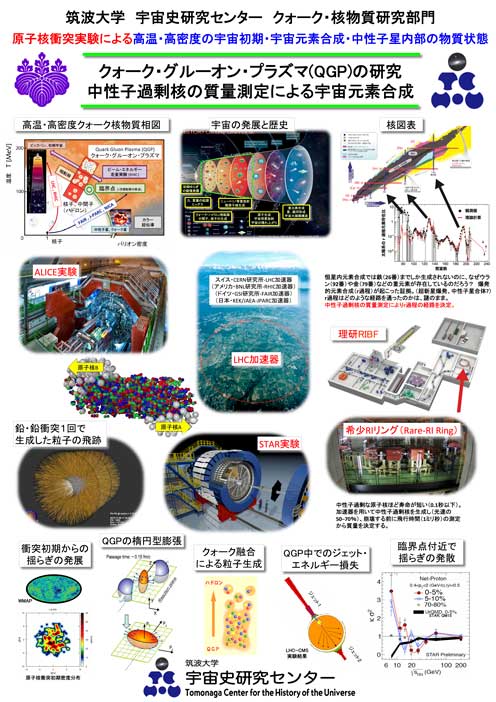

- 2018/10/25 Dr. Shunsuke Honda won JPS Yang Researcher Award 2019

Dr. Shunsuke Honda, who has involved in the Higgs research project of the Division of Elementary Particles and has graduated the Doctoral Program in Physics, Graduate School of Pure and Applied Sciences, University of Tsukuba, in March 2018, won Yang Researcher Award 2019 of the Physical Society of Japan for his PhD thesis "Search for the Higgs Boson Produced in Association with Top Quarks and Decaying into Bottom Quarks with the ATLAS Detector" under supervision of Asso.Prof. K. Hara. He is now a PhD fellow of the Kyoto University.
URL: JPS Yang Researcher Award 2019 (in Japanese)
Through this research, the Higgs particle discovered by the Atlas experiment at CERN was shown to make top quarks massive too besides bosonic particles. This is a big step forward to confirm the standard theory, in which the Higgs particle is the origin of all masses. The Atlas experiment is further studying if the Higgs particle is the origin of mass also for other quarks.
- 2018/09/22-23 Satellite meetings after TGSW 2018
Following the Tsukuba Global Science Week 2018, we have informal meetings of our Divisions.
- joint lunch meeting
- Date: 22 (sat) Sept. 2018, 13:30-
- Venue: restaurant "Suginoya"
- Contact: Asso. Prof. S. Esumi
- Div. Quark Nuclear Matters
- Date: 22-23 (sat-sun) Sept. 2018
- Venue: 1F201 (Tsukuba Univ., Area1)
- Program:
- 22/Sept (Sat) "ALICE and future upgrade"
- 9:00- Rachid Guernane, Tatsuya Chujo - ALICE and future plan
- 11:00- Ritsuya Hosokawa - ALICE analysis, Jet-hadron correlation
- free discussions
- 13:30- joint lunch meeting
- 23/Sept (Sun) "Future program toward high-density"
- 9:00- 9:30 : Nu Xu - CEE and CBM project
- 9:40-10:00 : Hiroyuki Sako - J-PARC heavy-ion program and related physics
- 10:30-11:00 : Issac Upsal - Event Plane Detector and BES/BES2 program in STAR
- free discussions & lunch
- 23/Sept afternoon "STAR analysis and beam energy scan program"
- 13:30-13:50 : Tetsuro Sugiura - Net-charge fluctuation
- 14:00-14:20 : Ryo Aoyama - Jet-flow correlation
- 14:30 - 14:50 : Kazuya Nakagawa - Correlation in dAu
- 15:30 - 15:50 : Yota Kawamura - HBT in CuAu
- 16:00 - 16:20 : Hiroki Kato - Flow with fixed target
- 16:30 - 16:50 : ShinIchi Esumi - unfolding for num.-temp. fluctuation, EPD with N.N.
- free discussions
- Contact: Asso. Prof. S. Esumi
- Div. Elementary Particles
- Date: 22 (sat) Sept. 2018
- Venue: Shizen B118 (Natural Sciences Build.)
- Program:
- 10:00- K. Sato - Possible collaborations at ATLAS
- 10:30- All participants - discussions
- 13:30- joint lunch meeting
- Contact: Prof. F. Ukegawa
- Div. Antarctic Astronomy
- Date: 22 (sat) Sept. 2018
- Venue: Sogo-B B421
- Program:
- 10:00- All participants - discussions
- 13:30- joint lunch meeting
- Contact: Prof. N. Kuno
- joint lunch meeting
- 2018/09/21 Tsukuba Global Science Week (TGSW) 2018
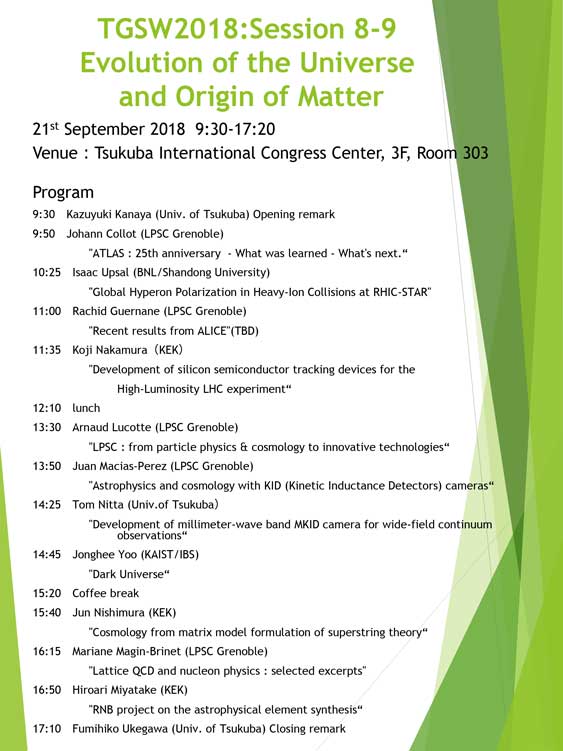

As the Session 8-9 of the Tsukuba Global Science Week 2018, TCHoU is organizing the 5th International Workshop on "Universe Evolution and Matter Origin".
- Date: 21 Sept 2018 (Fri) 9:30-17:30
- Venue: EPOCHAL Tsukuba / International Congress Center Room 303
- Website: TGSW website
- Program: program
- Kazuyuki Kanaya (TCHoU Tsukuba) "Opening remark"
- Johann Collot (LPSC Grenoble)
- "ATLAS : 25th anniversary - What was learned - What's next"
- Isaac Upsal (BNL/Shandong Unive.)
- "Global Hyperon Polarization in Heavy-Ion Collisions at RHIC-STAR"
- Rachid Guernane (LPSC Grenoble) "Recent results from ALICE"
- Koji Nakamura (KEK)
- "Development of silicon semiconductor tracking devices for the High-Luminosity LHC experiment"
- Arnaud Lucotte (LPSC Grenoble)
- "LPSC : from particle physics & cosmology to innovative technologies"
- Juan Macias-Perez (LPSC Grenoble)
- "Astrophysics and cosmology with KID (Kinetic Inductance Detectors) cameras"
- Tom Nitta (TCHoU Tsukuba)
- "Development of millimeter-wave band MKID camera for wide-field continuum observations"
- Jonghee Yoo (KAIST/IBS) "Dark Universe"
- Jun Nishimura (KEK)
- "Cosmology from matrix model formulation of superstring theory"
- Mariane Magin-Brinet (LPSC Grenoble)
- "Lattice QCD and nucleon physics : selected excerpts"
- Hiroari Miyatake (KEK)
- "RNB project on the astrophysical element synthesis"
- Fumihiko Ukegawa (TCHoU Tsukuba) "Closing remark"
- Number of participants: 54
In order to answer various questions in basic natural science especially about the evolution of the universe and the origin of matter, University of Tsukuba has formed a new basic science research center "Tomonaga Center for the History of the Universe" (TCHoU) in Faculty of Pure and Applied Sciences. TCHoU includes the following 4 divisions; (1) Antarctic Astronomy, (2) Elementary Particles, (3) Quark Nuclear Matters, and (4) Photon and Particle Detectors. These 4 divisions are trying to cooperate together to find out the "dark-" matter, energy and galaxies and to understand the origin of matter, phase transition and structure formation as well as their fluctuation and evolution. This session is to share the understanding of our fields and to discuss about the next step.
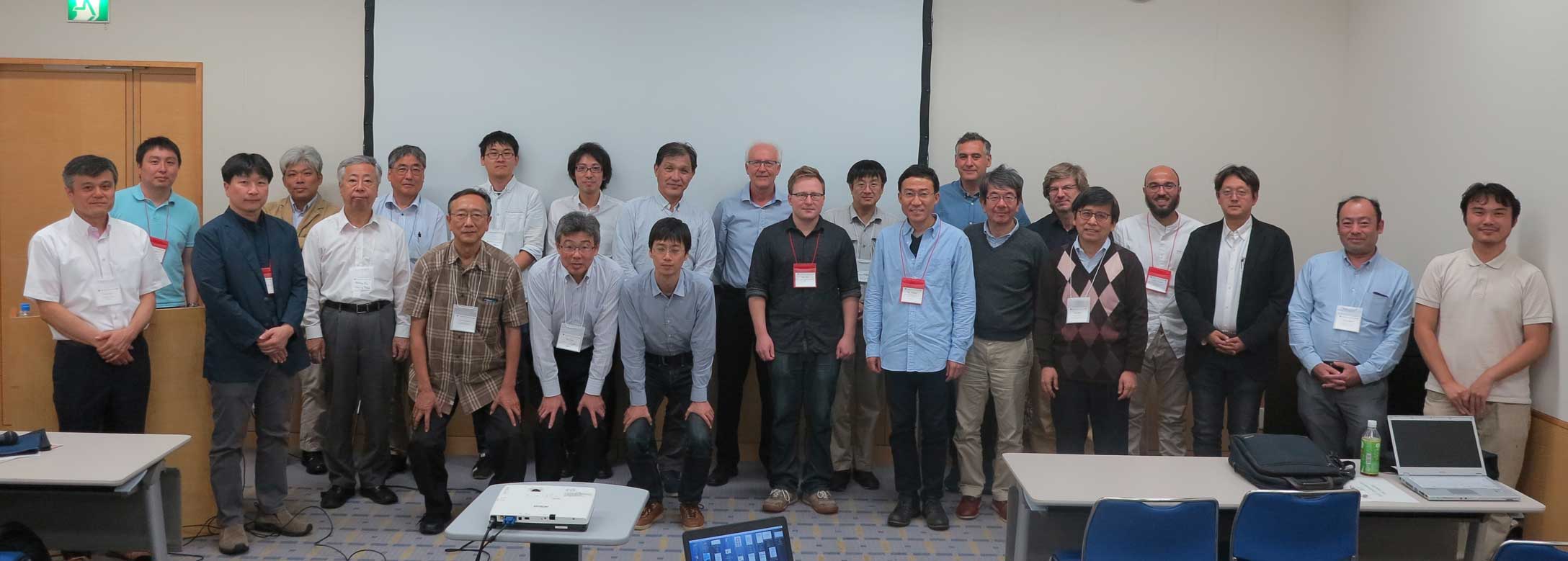
























Contact: Prof. N. Kuno
- 2018/09/13 The members and associates list as well as the TCHoU pamphlets were updated.
- 2018/07/27 HoU Seminar
- Date: 27 July 2018(Fri) 13:45-
- Venue: Natural Science Build. B, Room B118, Univ. Tsukuba
- Program: program (in Japanese)
- Speaker: Dr. Yusuke Iida(Kwansei Gakuin University)
- Tile: Solar dynamo problem approached by image recognition techniques
- Abstract: The atmospheric activity of the Sun has the 11-year cycle, and its mechanism is considered to be the most important key for the Solar dynamo problem. The “Magnetic flux transport model” has been established mainly from magnetohydrodynamics theory and numerical experiment. On the other hand, the dynamo model has not been proved from the observation data due to the difficulty of analyzing innumerable small magnetic elements on the actual solar surface. In this talk, I will show our observational studies using image recognition by computers.
- Speaker Dr. Yuuki Nakano(ICRR)
- Tile: Current status and future prospect of solar neutrino observation using the Super-Kamiokande detector
- Abstract: Super-Kamiokande(SK) is a 50 kton water Cherenkov detector whose purposes are proton decay search, and solar and atmospheric neutrino observation as well as an accelerator experiment (T2K). In this seminar, recent physics results are presented focusing on solar neutrino observation. At the end, expected future prospect is also reported.
- Number of participants: 15



Contact: Assi.Prof. T. Iida
- 2019/07/06 Tanabata public lecture
- Date: July 7 (Sat.), 2018 13:30-16:30
- Venue: Tsukuba International Congress Center
- Program:
13:30- Ken Osuka
(Univ. Tsukuba)"Getting to the Core of Black Holes" 15:00- Kazuo Sorai
(Hokkaido Univ.,
Univ. Tsukuba)"Search for Galaxies by Radio Telescopes" - Admission: free
- Number of participants: 95
Contact: Prof. N. Kuno
- 2018/07/02 Member list and pamphlets were updated.
- 2018/06/11 Member list and pamphlets were updated.
- 2018/06/04 TCHoU Member Meeting and Activity Reports
We make the first meeting of the members of the Tomonaga Center for the History of the Universe, followed by reports on main activities in FY 2017.
- Date: 4 June 2018 (Mon) 10:30-18:40
- Venue: Natural Sciences Building B, B114
- Program (all presentations are in Japanese)
- 10:30-11:30 : Foundation of TCHoU and its status (Kanaya) + TCHoU Member Meeting Reports on activities in FY 2017
- 11:30-12:00 : Development of super-conducting detectors for COBAND (Takemasa)
- 13:30-14:00 : Gravitational wave and cosmology (Takamizu)
- 14:00-14:30 : X-ray chemistry for the Antarctic telescope and observation of deuteride compounds (Watanabe)
- 14:40-15:05 : Division of Antarctic Obsevatory of Astronomy (Kuno)
- 15:05-15:30 : Development of super-conducting micro-wave camera for the 45m telescope at Nobeyama (Nitta)
- 15:40-16:05 : ATLAS project (Okawa)
- 16:05-16:30 : COBAND project (Takeuchi)
- 16:30-16:55 : String theory (Y. Sato)
- 17:00-17:25 : QGP project (Miake)
- 17:25-17:50 : Presision measurement of unstable nuclei by storage ring towards nucleogenesis (Yamaguchi)
- 17:50-18:15 : Division of Photon and Particle Detectors (Hara)
- 18:15-18:40 : Summary (Ukegawa)
- Number of participants: 25




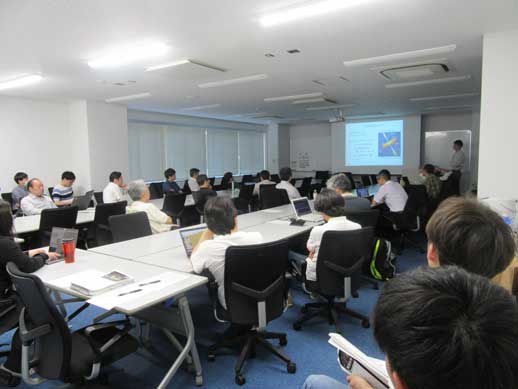







- 2018/04/21 Exhibition for the Science and Technology Week 2019
TCHoU is pushing forward a series of integrated projects to clarify the history of the Universe. For the Science and Technology Week 2019, we display our projects on the cosmic neutrino background, antarctic observatory of astronomy, quark gluon plasma, Higgs particle, nucleosynthesis, and cosmic evolution for junior students by posters, display of instruments, and a short movie.
- Date: 21 Apr 2018 (sat) 10:00-16:00
- Venue: Sogo-B B0107, B0110
- Total number of visitors: 350







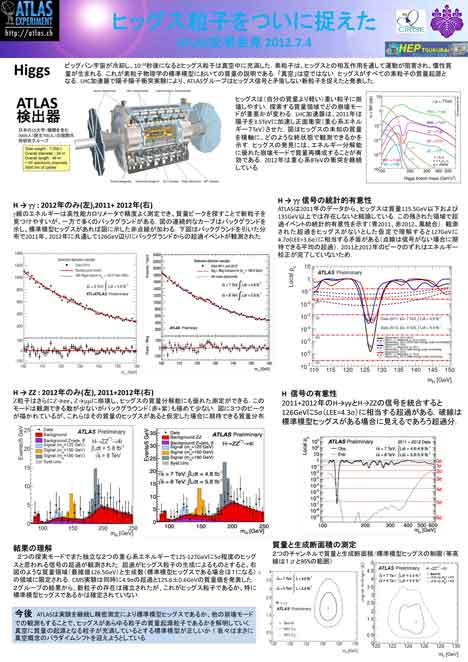
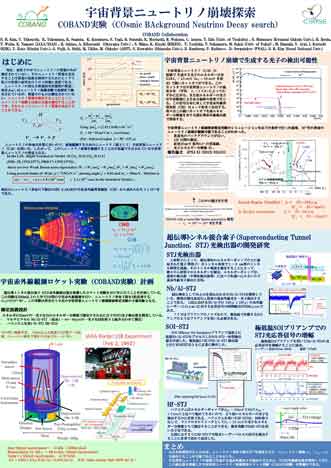

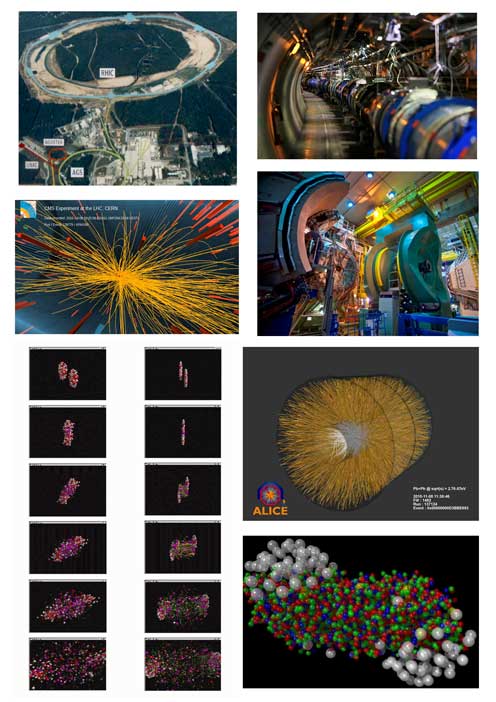
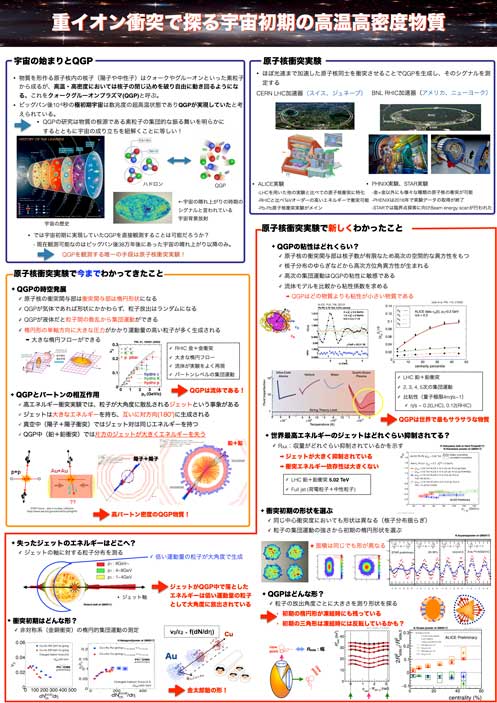
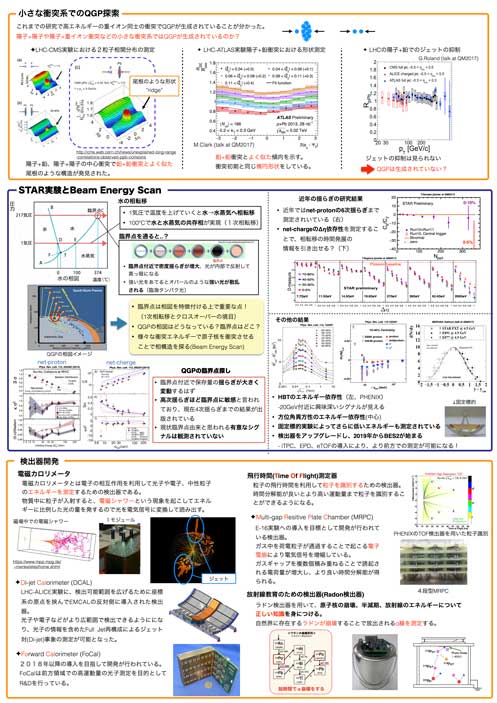
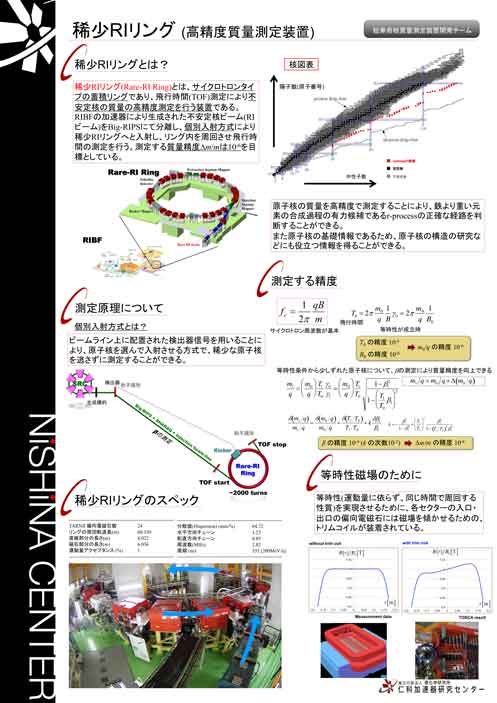
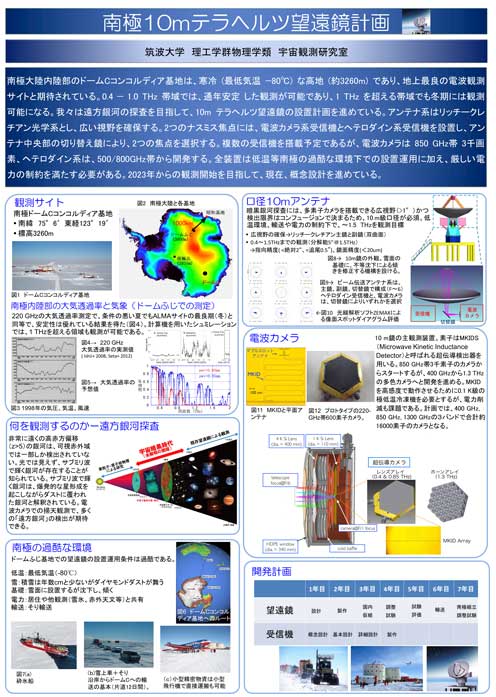
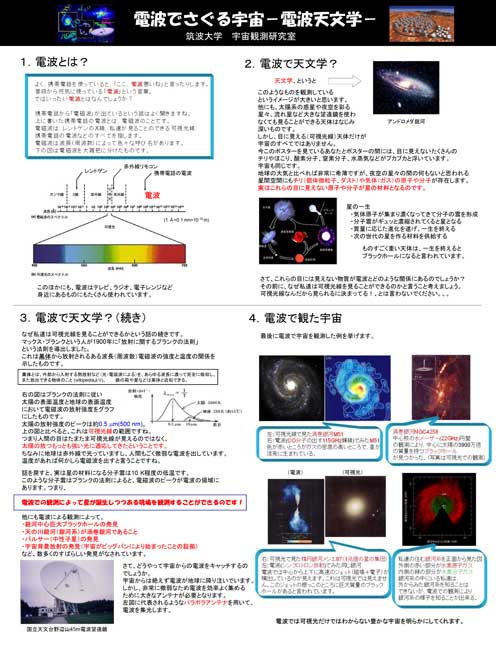
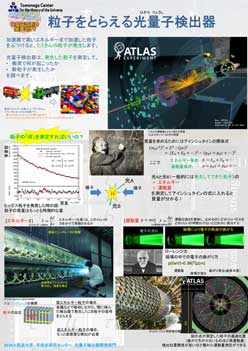
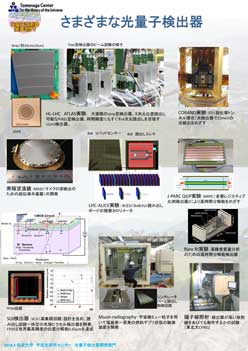
Contact: Prof. F. Ukegawa
- 2018/04
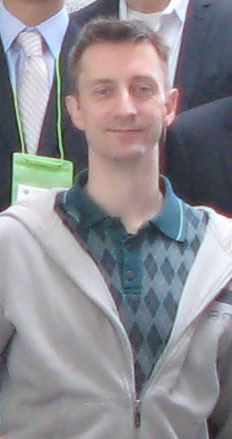
To our deep sorrow, our Assi. Prof. Oliver Busch, who has been a member of the Division of Quark Nuclear Matters since 2014, has passed away on 31 March 2018 at Manheim, Germany, due to influensa and pneumonia.
As an international tenure track assistant professor of the University of Tsukuba, he mainly stayed at Heidelberg University, Germany, and pushed forward the international project to clarify the quark gluon plasma by high-energy heavy-ion experiment (ALICE) with Large Hadron Collider (LHC) at European organization of nuclear study (CERN) in Geneva. He also contributed education of our students visiting CERN. Oliver was just moving to Tsukuba in FY 2018 as a tenured staff of us. We miss Oliver very much, and would like to express our deepest condolences.
- 2018/04
Prof. Naomasa Nakai, who has been the chair of the Division of Antarctic Astronomy, has moved to Kwansei Gakuin University at Nishinomiya, Hyogo. As the new chair of the Division, Prof. Nario Kuno was appointed. We continue close collaborations with the group at the Kwansei Gakuin University to push forward the project of the Antarctic Observatory of Astronomy.
- 2018/03/26-27 Inaugural Symposium of the Tomonaga Center for the History of the Universe
- Date: 26(Mon)-27(Tue) Mar 2018
- Venue: 26 Mar at the International Conference Room of the University Hall, Univ. Tsukuba; 27 Mar at rooms 0107, 0108, 0110, and 0112-1 at Laboratory of Advanced Research B, Univ. Tsukuba
- Web: hep-www.px.tsukuba.ac.jp/TCHoU/symposium2018
- Program:
- Day 1: Plenary session
International Conference Room, University Hall
Talks by invited speakers, division heads.
Confirmed invited speakers:- George W.S. Hou (National Taiwan University, Taiwan)
- Soo-Bong Kim (Seoul National University, Korea)
- Boonrucksar Soonthornthum (National Astronomical Research Institute of Thailand, and Ministry of Science and Technology, Thailand)
- Nu Xu (LBNL, USA / Central China Normal University, China)
- Shunji Nishimura (RIKEN, Japan)
- Yasuo Arai (KEK, Japan)
- Day 2: Parallel sessions
Rooms 0107, 0108, 0110, 0112-1, Laboratory of Advanced Research B- Division of Antarctic Astronomy (Room 0112)
- Division of Elementary Particles (Room 0110)
- Division of Quark Nuclear Matter (Room 0107)
- Division for Development of Photon and Particle Detectors (Room 0110)
- Registration: Visit on-line registration page.
- Number of participants: 56 (day 1), 46 (day 2)

















For more details visitthe symposium web page.
Contact: Prof. F. Ukegawa
- 2018/03/07-08 Kick-off symposium of Quark Gluon Plasma Research Unit
The University of Tsukuba and the Utrecht University agreed to implement the Research Unit Invitation Program of the Campus-in-Campus (CiS) Initiative on the research of the Quark-Gluon-Plasma.
A kick-off symposium has been held as follows.
- Date: March 7 - 8 (Wed - Thu), 2018
- Venue: International Workshop Room at the Center for Computational Science, Univ. of Tsukuba
- Web: https://indico.cern.ch/event/707979/
- Program: time table
- Number of participants: 22 (ceremony: 24)
The morning session 9:00 - 10:00 on 08 Mar Thursday was devoted to the Ceremony for the Agreement for Implementation of the Research Unit Invitation Program of the Campus-in-Campus (CiS) Initiative between Utrecht Univ. and Univ. of Tsukuba.



Contact: Prof. Y. Miake, Assi. Prof. T. Chujo
- 2018/02/20 HoU Seminar
- Date: 20 Feb 2018 (Tue) 13:00-15:00
- Venue: Natural Science Build. 1F, Room 1F201 (to be fixed)
- Speaker: Dr. Takafumi Niida (Wayne State University)
- Title: Vortical fluid via polarization, and directed flow in heavy-ion collisions
- Number of participants: 18




Contact: Asso.Prof. S. Esumi
- 2018/02/14 HoU Seminar
- Date: 14 Feb 2018 (Wed) 15:15-16:30
- Venue: Natural Science Build. D, Room D413, Univ. Tsukuba
- Speaker: Prof. N. Saito (KEK)
- Title: History of the Universe from cosmic muons -- new physics explored by the high-intensity beams at J-PARC
- Number of participants: 15
Contact: Prof. Y. Miake, Asso.Prof. S. Esumi
- 2018/02/07 3rd TIA-Accelerate Symposium
The 3rd TIA-Accelerate Symposium on photon and particle detectors was held at Tsukuba International Conference Center (EPOCAL Tsukuba).
- Date: 7 Feb 2018 (Wed) 9:30-17:00
- Venue: Tsukuba International Conference Center (EPOCAL Tsukuba) 201, 202
- URL: www2.kek.jp/URA/tiaacc3rd.html
- Poster and program (in Japanese)
- Number of participants: 88



Visit the symposium web page (in Japanese) for details.
- 2018/02/06 1st Steering Committee Meeting
The 1st part is open to the members of the center.
- Date: 6 Feb 2018 (tue) 14:00-16:00 (1st part: open), 16:20-17:45 (2nd part: closed)
- Venue: Sogo-B B0110 (1st part), B0204 (2nd part)
- Program 1st part (B0110) open
- 14:00-14:40 : Summary report (K. Kanaya)
- 14:40-15:00 : Division of Antarctic Astronomy (N. Kuno)
- 15:00-15:20 : Division of Elementary Particles (Y. Takeuchi)
- 15:20-15:40 : Division of Quark Nuclear Matters (S. Esumi)
- 15:40-16:40 : Division of Photon and Particle Detectors (K. Hara) 2nd part (B0204) closed
- 16:20-17:45
- Number of participants (1st part): 17






- 2018/01/26 HoU Seminar
Prof. S. Matsuura, Associate of the Div. of Elementary Particles, made a HoU Seminar in Japanese on the CIBER (Cosmic Infrared Background Experiment) experiment to clarify the cosmic microwave radiation in the near IR region.
- Date: 26 Jan 2018 (Fri) 15:15-16:30
- Venue: Seminar Room B108 at TCHoU
- Speaker: Prof. Shuji Matsuura (Kuwansei Gakuin Univ./Visiting Professor of the University of Tsukuba)
- Title: Evidence of an unaccountable component of the cosmic near-infrared background from Cosmic Infrared Background Experiment (CIBER)
- Abstract:
- The speaker will present a review of the new findings from the observation of the cosmic near-infrared background in CIBER (Cosmic Infrared Background Experiment), including prospects in the following rocket experiment CIBER-2 as well as the future project called IPST (InterPlanetary Space Telescope).
- Number of participants: 19




Contact: Asso.Prof. Y. Takeuchi
- 2018/01/19 HoU Seminar
- Date: 19 Jan 2018 (Fri) 15:15-16:30
- Venue: Seminar Room B108 at TCHoU
- Speaker: Prof. Kim Soo-Bong (SNU/TCHoU)
- Title: Sterile Neutrino Search in the JSNS2 Experiment
- Abstract:
- The JSNS2 (J-PARC Sterile Neutrino Search) at J-PARC Spallation Neutron Source experiment is under construction to begin data taking in 2019 using muon neutrinos produced from muon decays at rest. The experiment will make an ultimate direct-check of the LSND result with significantly lower backgrounds because of a pulsed beam and a detector of Gd-loaded liquid scintillator. In this talk, we will present an overview of the experiment as well as the construction status and its sensitivities.
- Number of participants: 17




Contact: Prof. Shinhong Kim
- 2018/01/11 HoU Seminar
- Date: 11 Jan 2018 (Thu) 15:15-16:30
- Venue: Seminar Room B108 at TCHoU
- Speaker: Prof. Yoo Jonghee (KAIST/IBS)
- Title: The First Observation of Coherent Elastic Neutrino-Nucleus Scattering
- Abstract:
- The coherent elastic scattering of neutrinos off nuclei (CEvNS) has eluded detection since its first prediction in 1974. Its predicted cross-section is the largest by far of all low-energy neutrino couplings. The CEvNS provides new opportunities to study neutrino properties, while leading to a miniaturization of detector size, with potential technological applications. The COHERENT observed this process at a 6.7-sigma confidence level, using a low-background, 14.6-kg CsI[Na] scintillator exposed to the neutrino emissions from the Spallation Neutron Source (SNS) at Oak Ridge National Laboratory. Characteristic signatures in energy and time. In this seminar, I will present the the first results of CEvNS observation and future prospect.
- Number of participants: 20 (including 2 from abroad)




Contact: Prof. Shinhong Kim
- 2017/12/11-12 HoU Mini-Workshop on "QGP/CEP research with Fluctuation"
- Date: 11 (Mon) Dec 2017 10:00-17:00, 12 (Tue) 9:30--
- Venue: 11 Dec at Seminar Room B108 at TCHoU, 12 Dec at room 201 of Naturel Science Building 1F
- Program
- 11 Dec (Mon) @ Institutes of Human Sciences Building B, Room B108
- 10:00-10:30 : Nu Xu (LBNL, CCNU, STAR)
"Recent results from RHIC BES-I" - 10:45-11:15 : Marek Gazdzicki (Frankfurt Univ., Jan Kochanowski Univ., NA61/Shine)
"Study of onset of deconfinement and search for critical point by NA61/SHINE at CERN SPS" - 11:30-12:00 : Melanie Szala (GSI, Frankfurt Univ., HADES experiment)
"Fluctuation analysis in HADES experiment at GSI" - 12:15-12:45 : Aleksandra Snoch (Frankfurt Univ., NA61/Shine)
"Charming future of NA61/SHINE" - 14:30-15:00 : Masakiyo Kitazawa (Osaka Univ.)
"On the efficiency correction for non-binomial efficiency loss" - 15:00 - 17:00 : Group discussion on fluctuation analysis at STAR, HADES, NA61
- 12 Dec (Tue) @ Building 1F, Room 1F201
- 09:00-09:15 : Flow correlation in d-Au (Kazuya Nakagawa)
- 09:30-09:45 : 2-part correlation in 200GeV Au+Au (Ryo Aoyama)
- 10:00-12:00 : Group discussion
- Number of participants: 16




Contact: Asso.Prof. S. Esumi
- 2017/12 New video conferncing system
New video conferncing system has been introduced in the seminar room of the Tomonaga Center (B108). The old video conferencing system was moved to a newly prepared meeting room at B106.
- 2017/11/4-5 Exibition at Campus Festival "Soho-Sai" of Univ. of Tsukuba
- Date: 4(Sat)-5(Sun) Nov 2017, 10:00-16:00
- Venue: 3A207, Univ. Tsukuba
- Thema: "Clarification of the History of Universe"
- Number of Visitors: 390 (4 Nov), 451 (5 Nov); 841 (total)






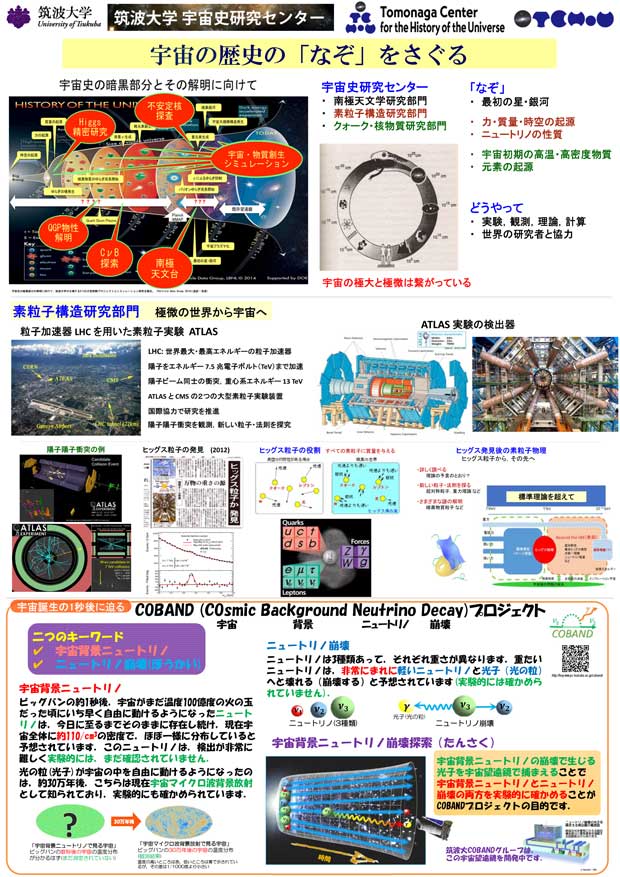
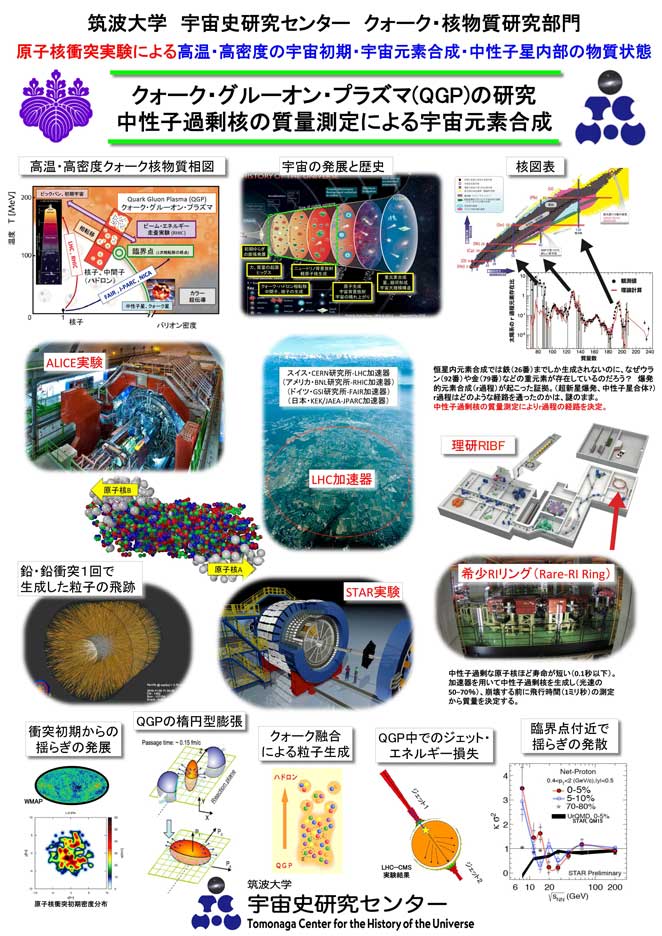
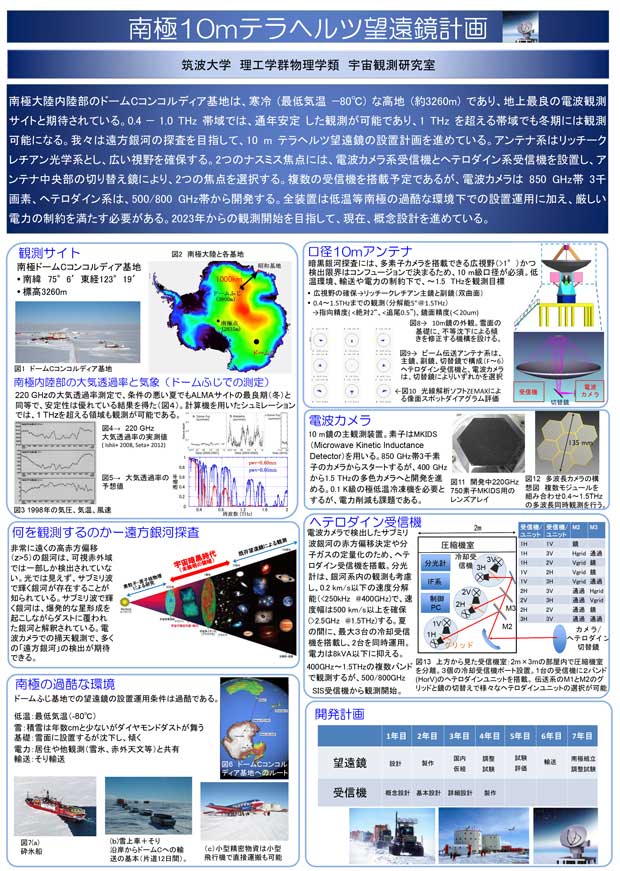
Contact: Prof. F. Ukegawa
- 16 Oct 2017 Steering Committee
As external members of the Steering Committee of the Tomonaga Center for the History of the Universe, Prof. Hideyuki Kobayashi (National Astronomical Observatory of Japan: NAOJ), Prof. Yasuo Arai (High Energy Accelerator Research Organization: KEK), Prof. Tetsuya Sakurai (Director, Center for Artificial Interigence Research, Univ. Tsukuba), Prof. Masayuki Umemura (Director, Centrer for Computational Sciences, Univ. Tsukuba), and Prof. Masahide Ito (Provost, Faculty of Pure and Applied Sciences, Univ. Tsukuba) are appointed.
- 1 Oct 2017 Reorganization of research centers at Faculty of Pure and Applied Sciences
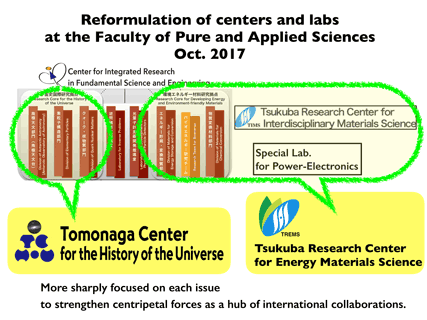
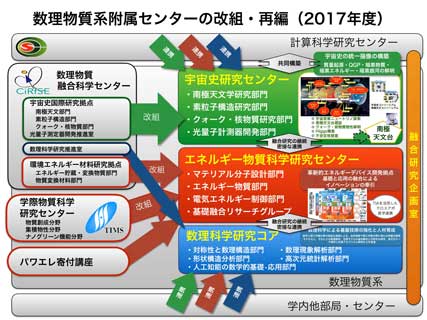
On October 1, 2017, the Center for Integrated Research in Fundamental Science and Engineering (CiRfSE) and the Tsukuba Research Center for Interdsciplinary Materials Science (TIMS), both at the Faculty of Pure and Appled Sciences, University of Tsukuba, are reorganized to establish two new centers -- the Tomonaga Center for the History of the Universe (TCHoU) and the Tsukuba Research Center for Energy Materials Science (TREMS) --, as shown in the plot. This is to accelerate foundation of international research hubs by making clearer their research missions in each field.
Tomonaga Center for the History of the Universe (TCHoU) is based on the Research Core for the History of the Universe and the Laboratory for Development of Photon and Particle Detectors of CiRfSE, and, under close collaboration with the Center for Computational Sciences (CCS) of the Univ. of Tsukuba, constructing an international core for research excange towards clarification of the History of the Universe.

Tsukuba Research Center for Energy Materials Science (TREMS) is based on the Research Core for Developing Energy and Environment-friendly Materials of CiRfSE, the Tsukuba Research Center for Interdsciplinary Materials Science (TIMS), and the Power Electronics special laboratory of the Faculty of Pure and Applied Sciences.

Research Core for Mathematical Scoiences is also established at the Faculty of Pure and Applied Sciences, extending the Laboratory for Mathematical Sciences of CiRfSE.



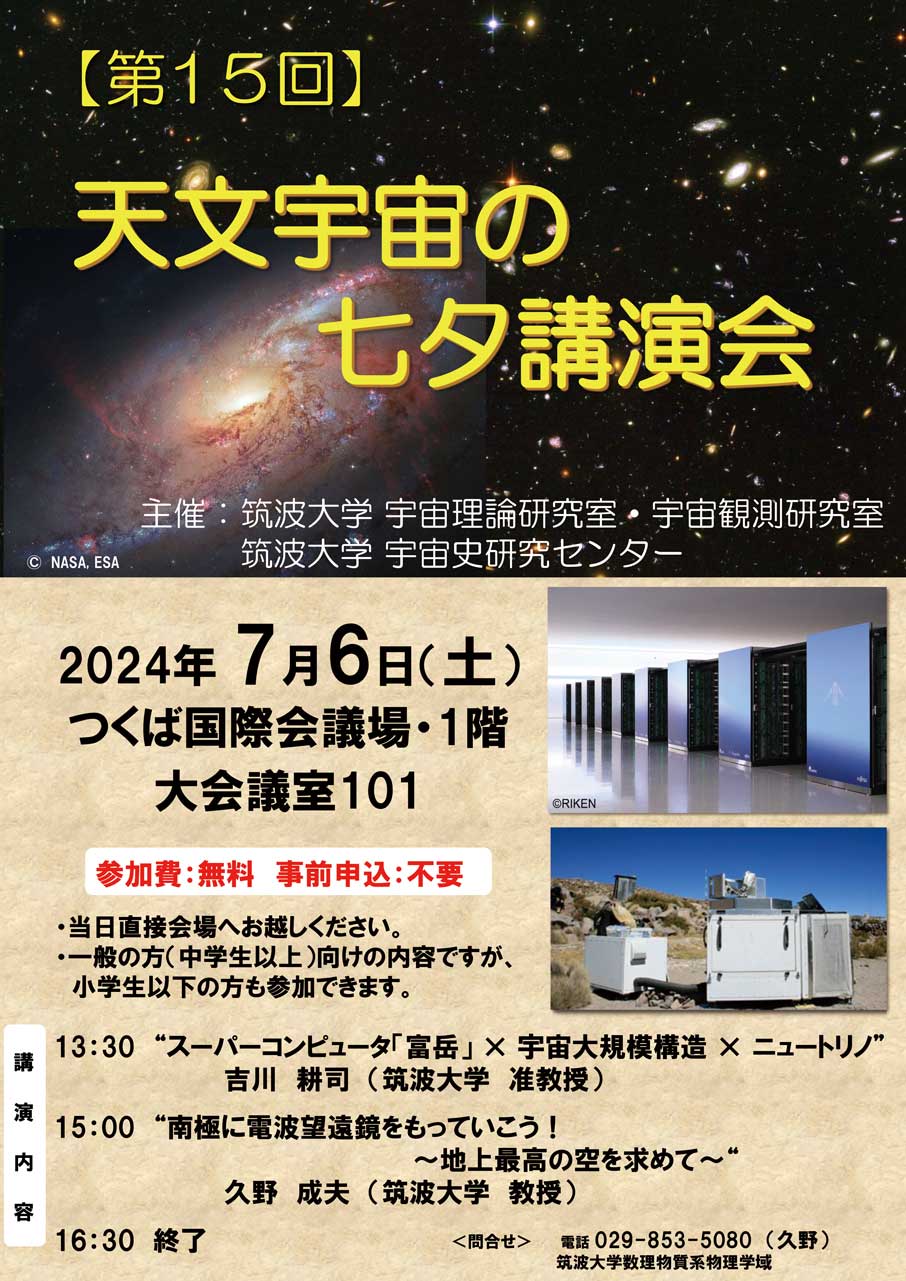
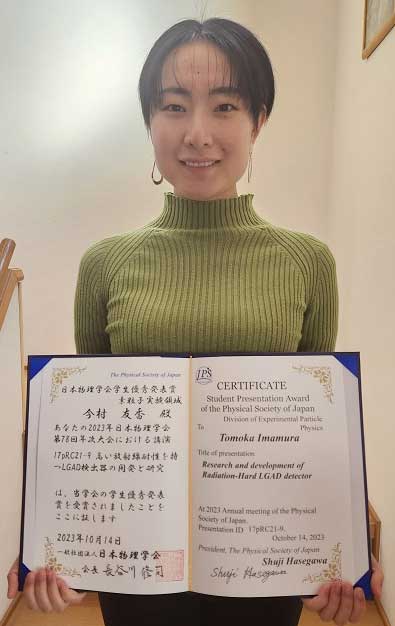
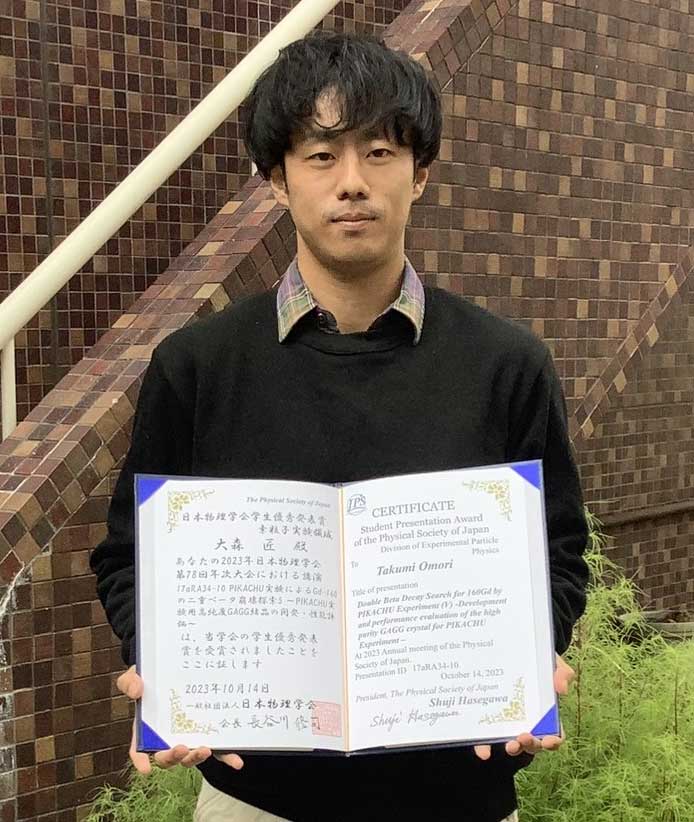
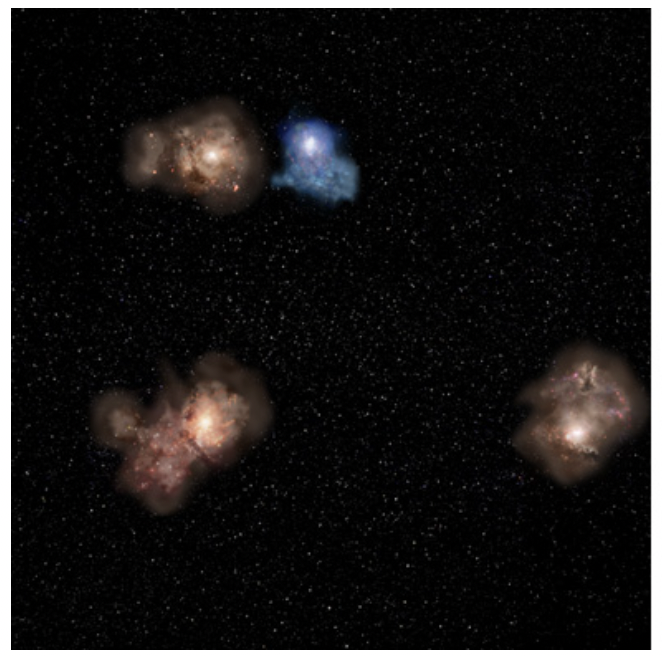
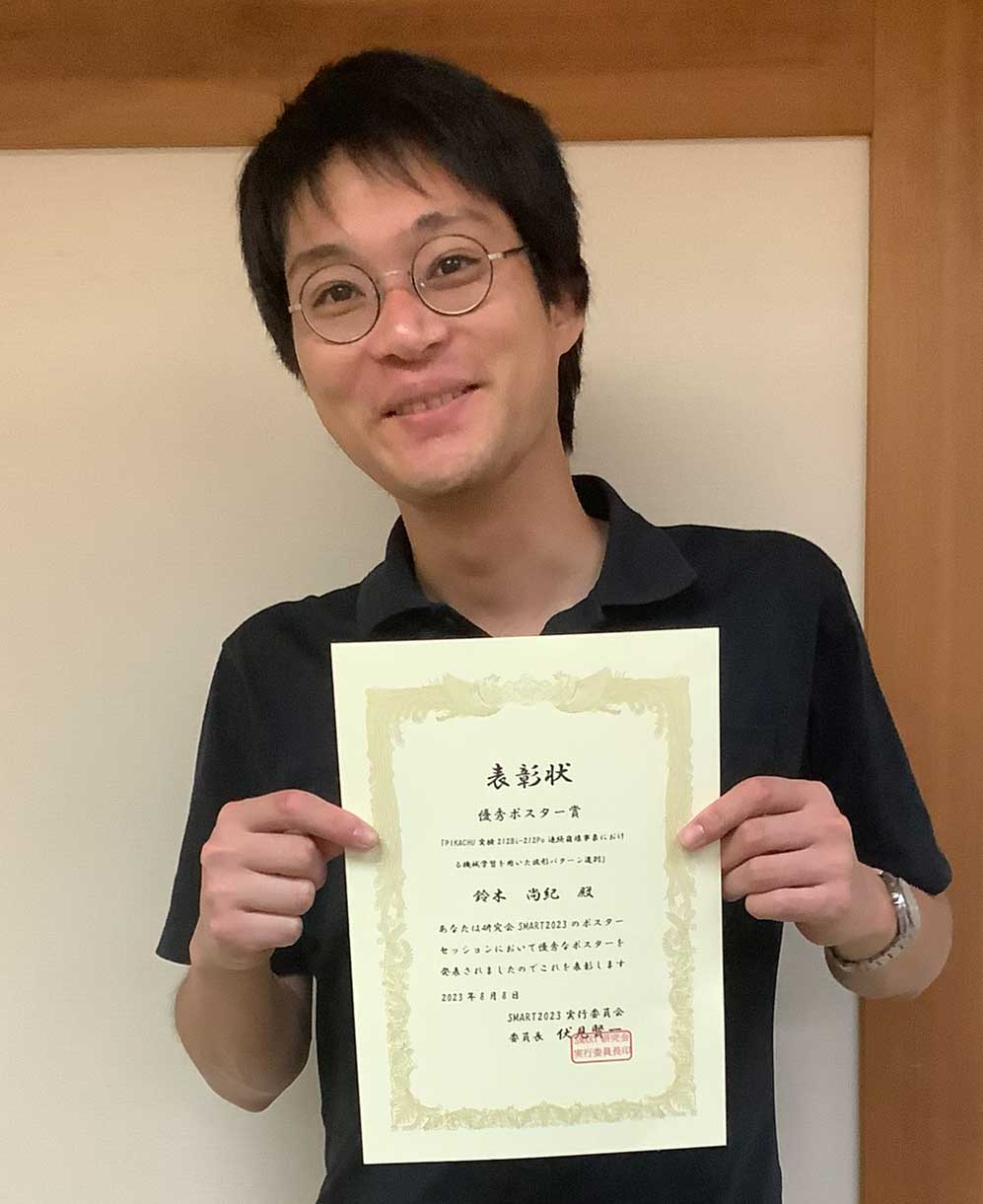
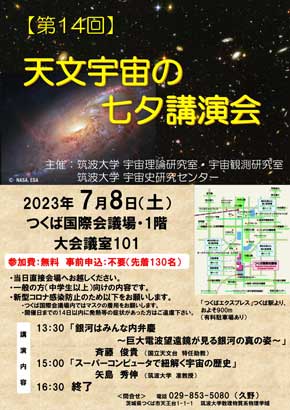

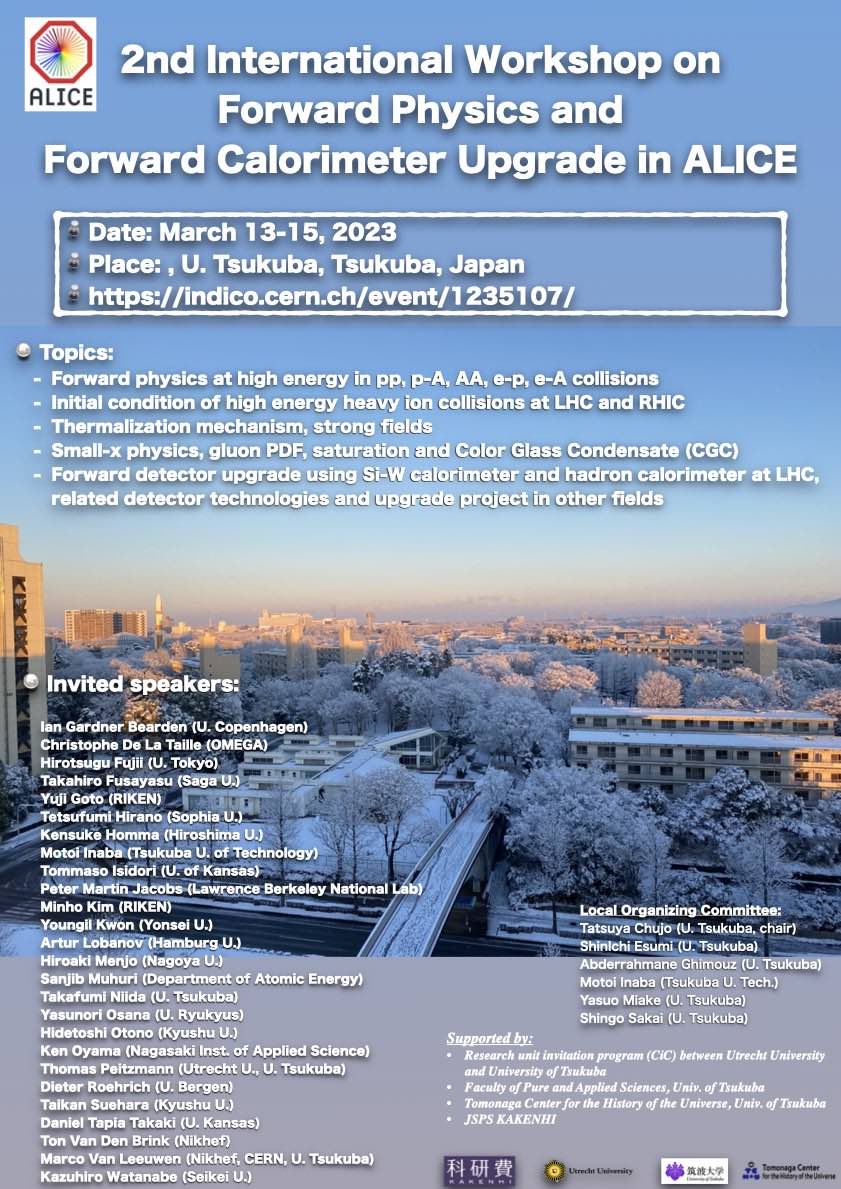
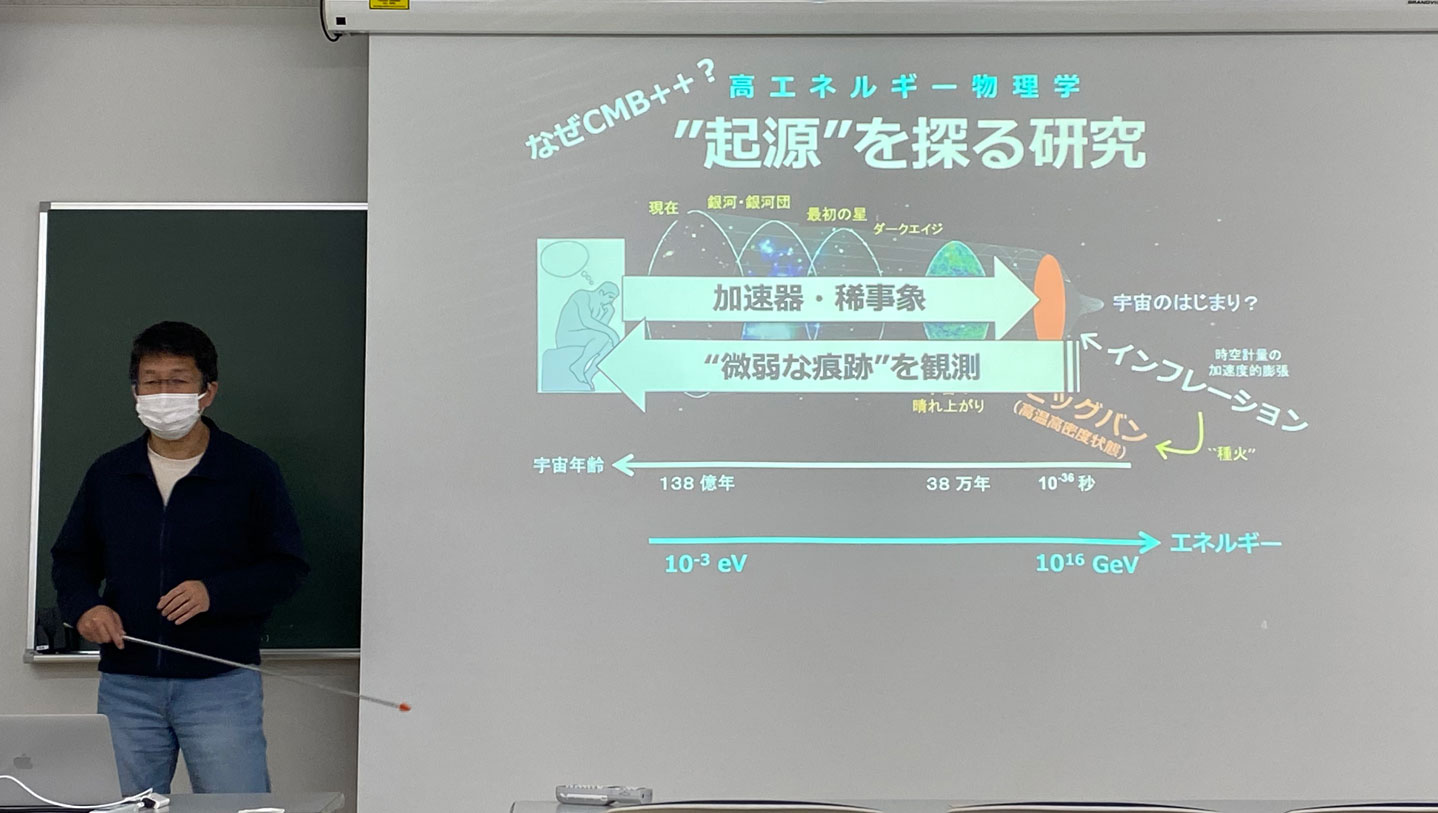
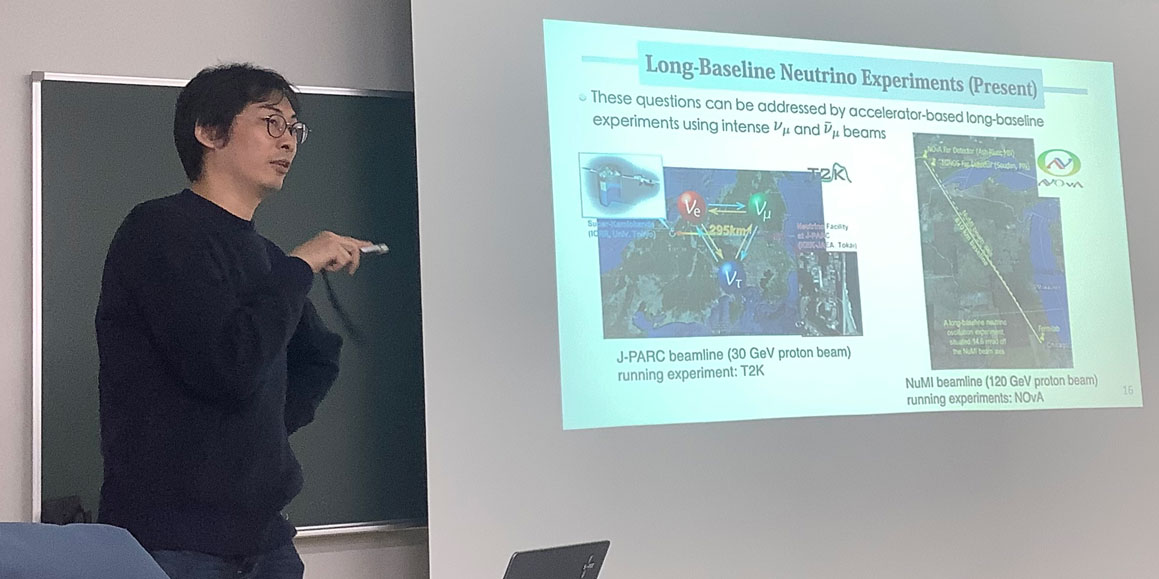
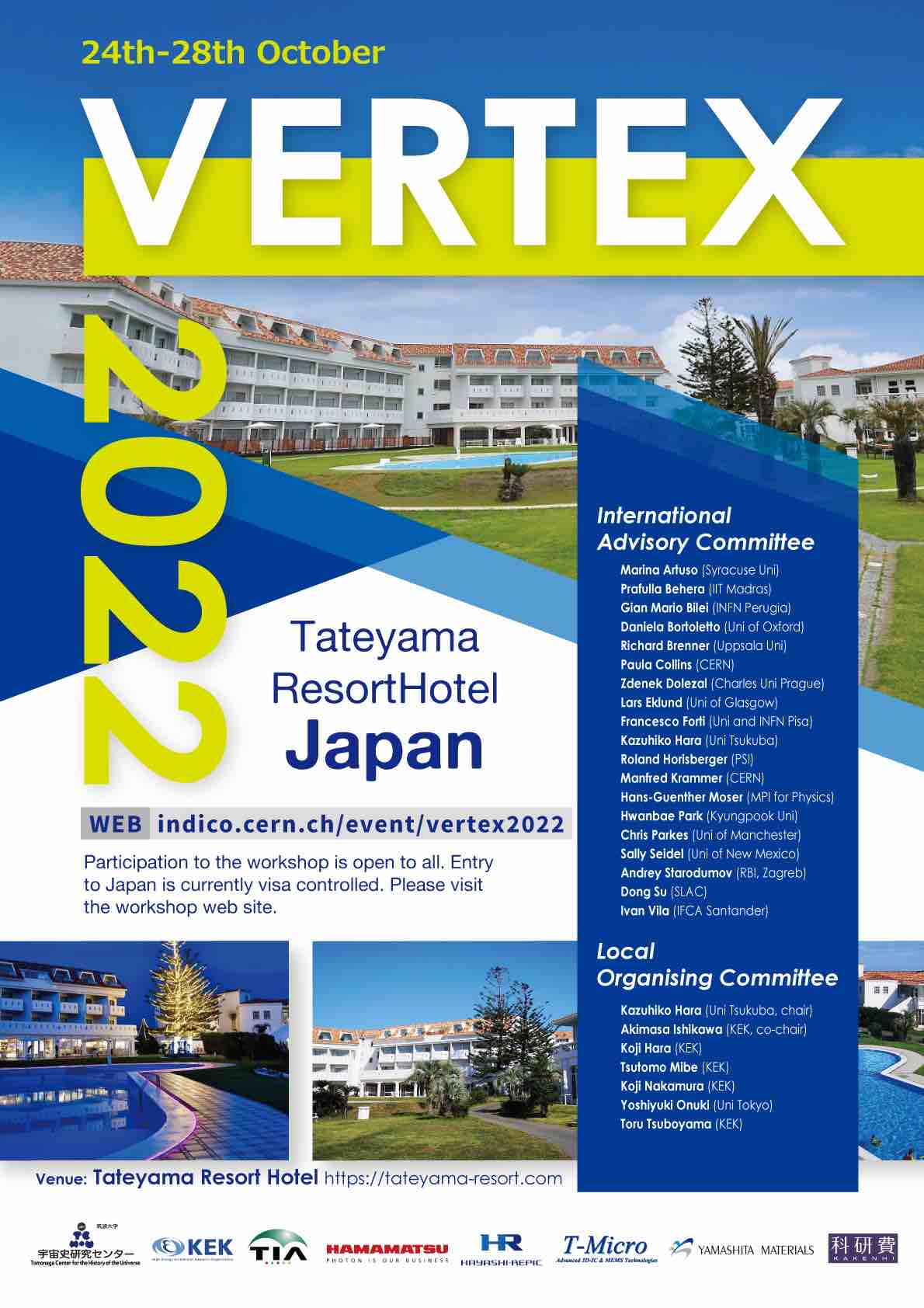
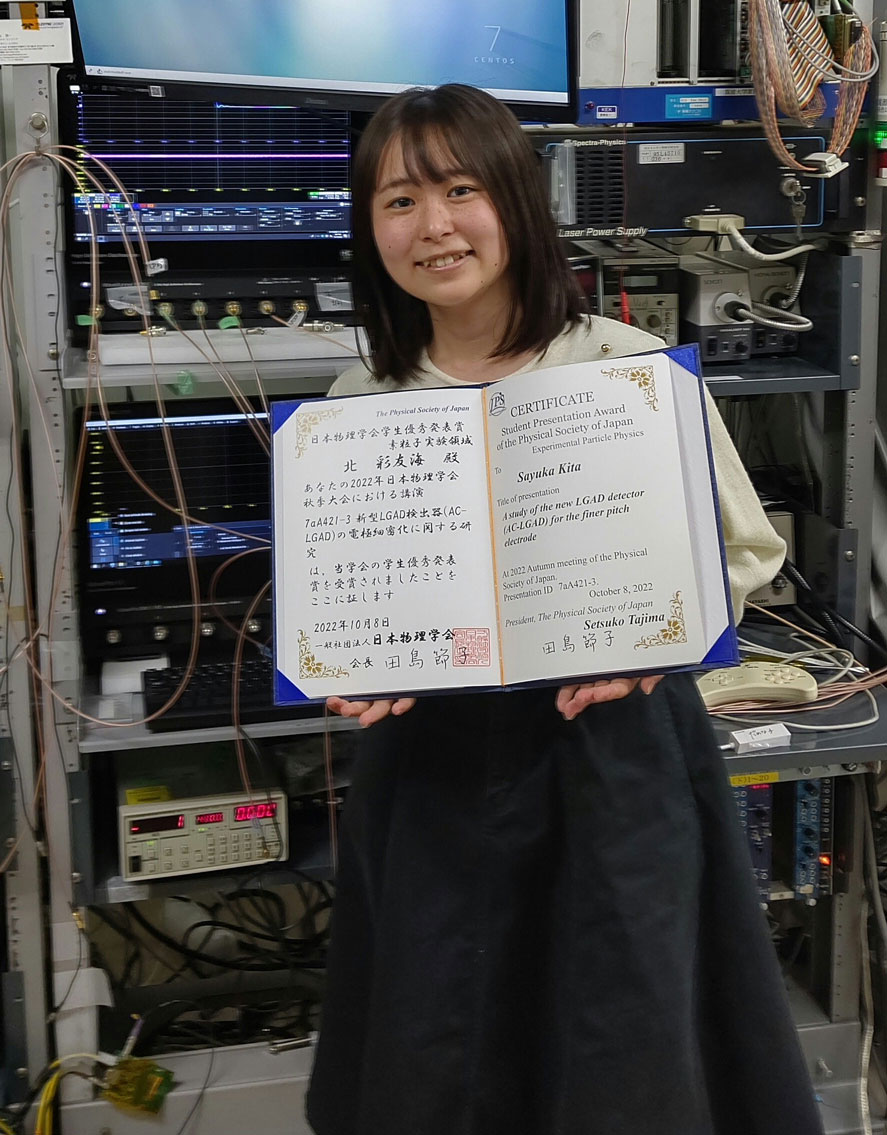
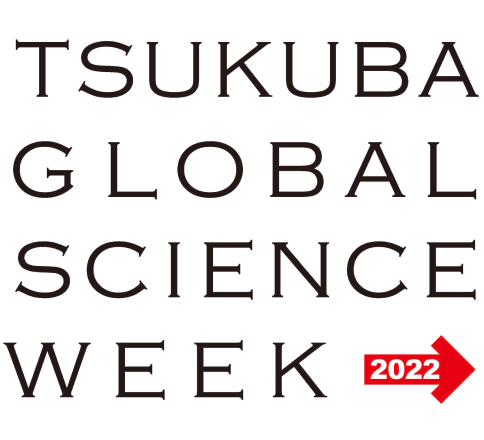
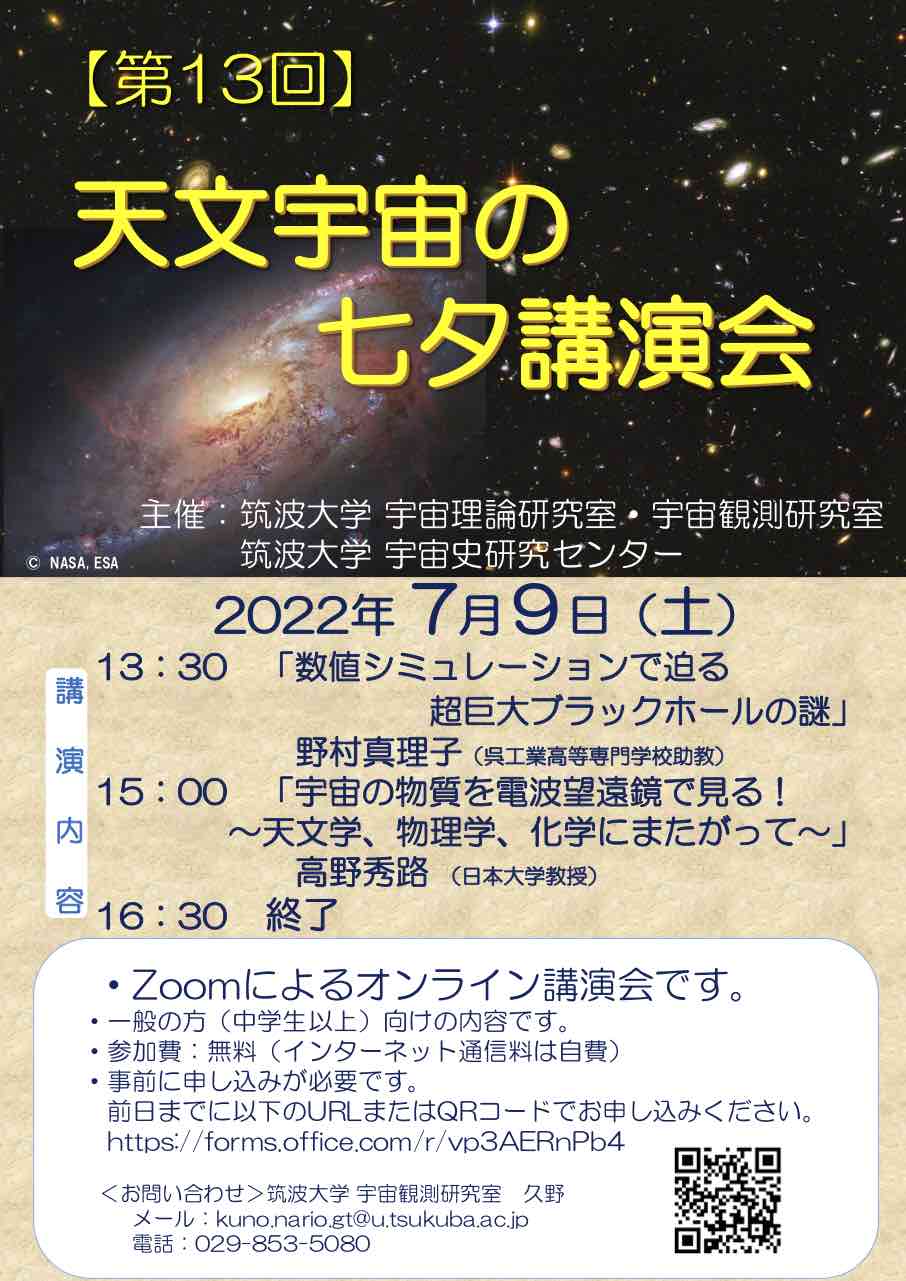
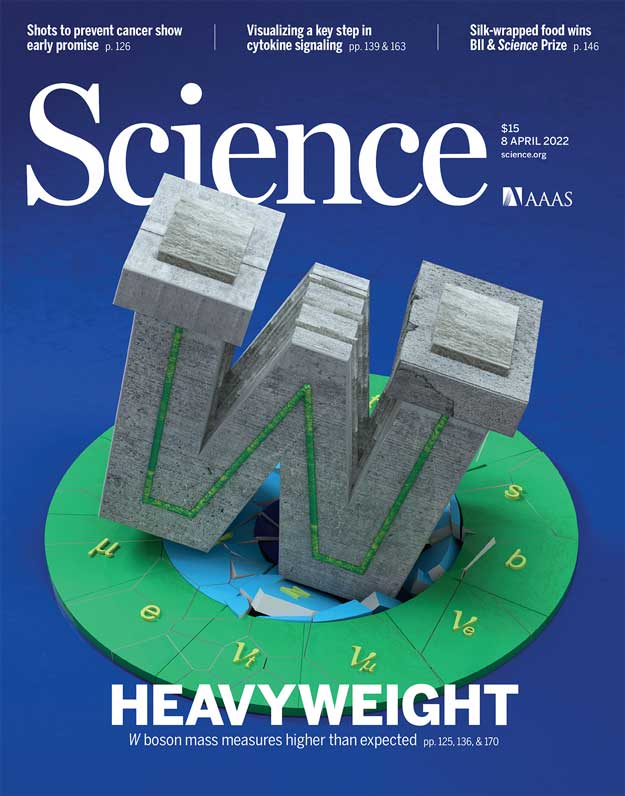

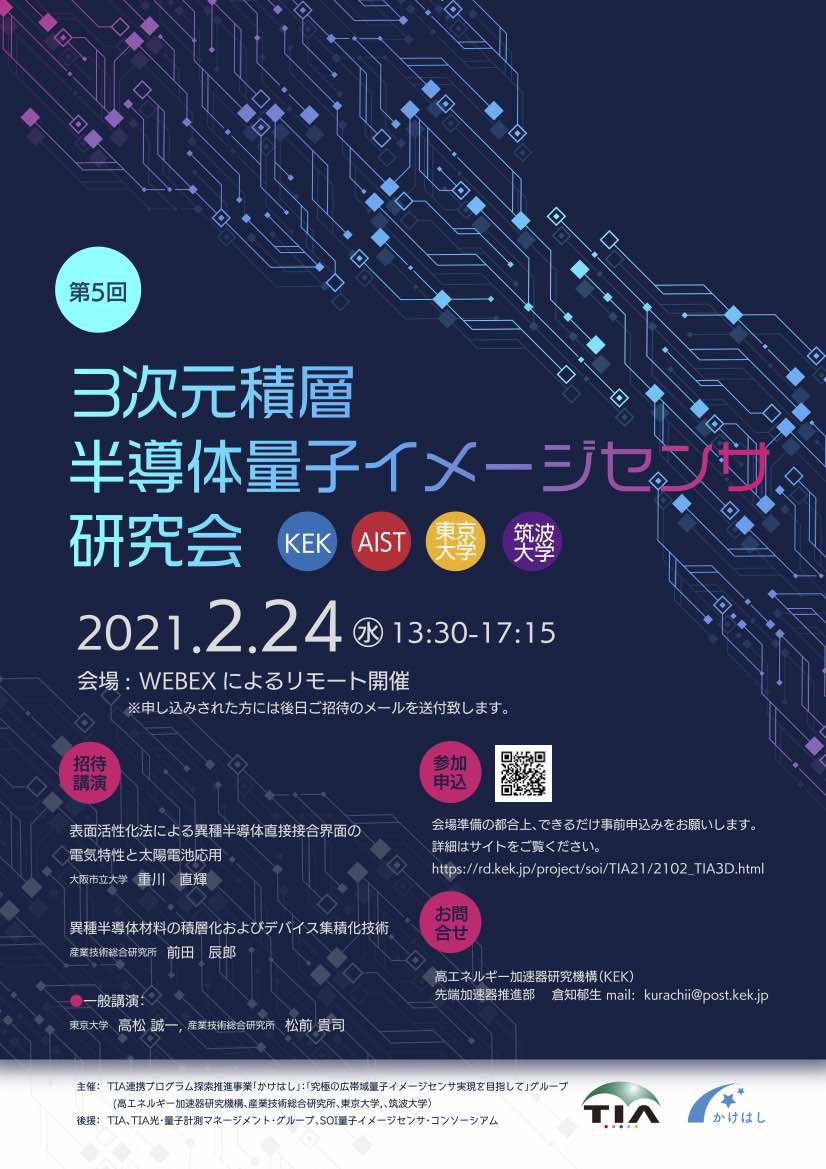
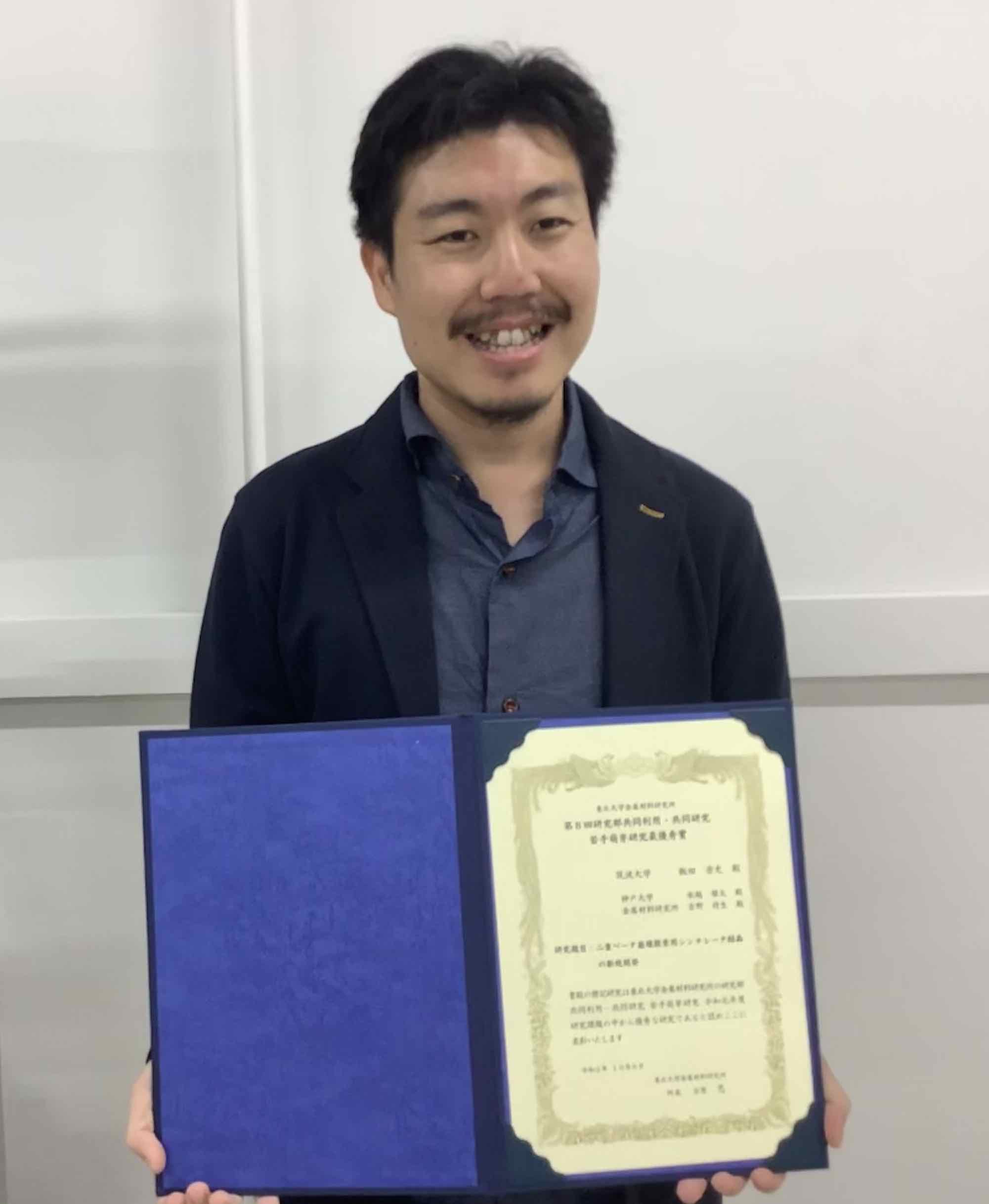
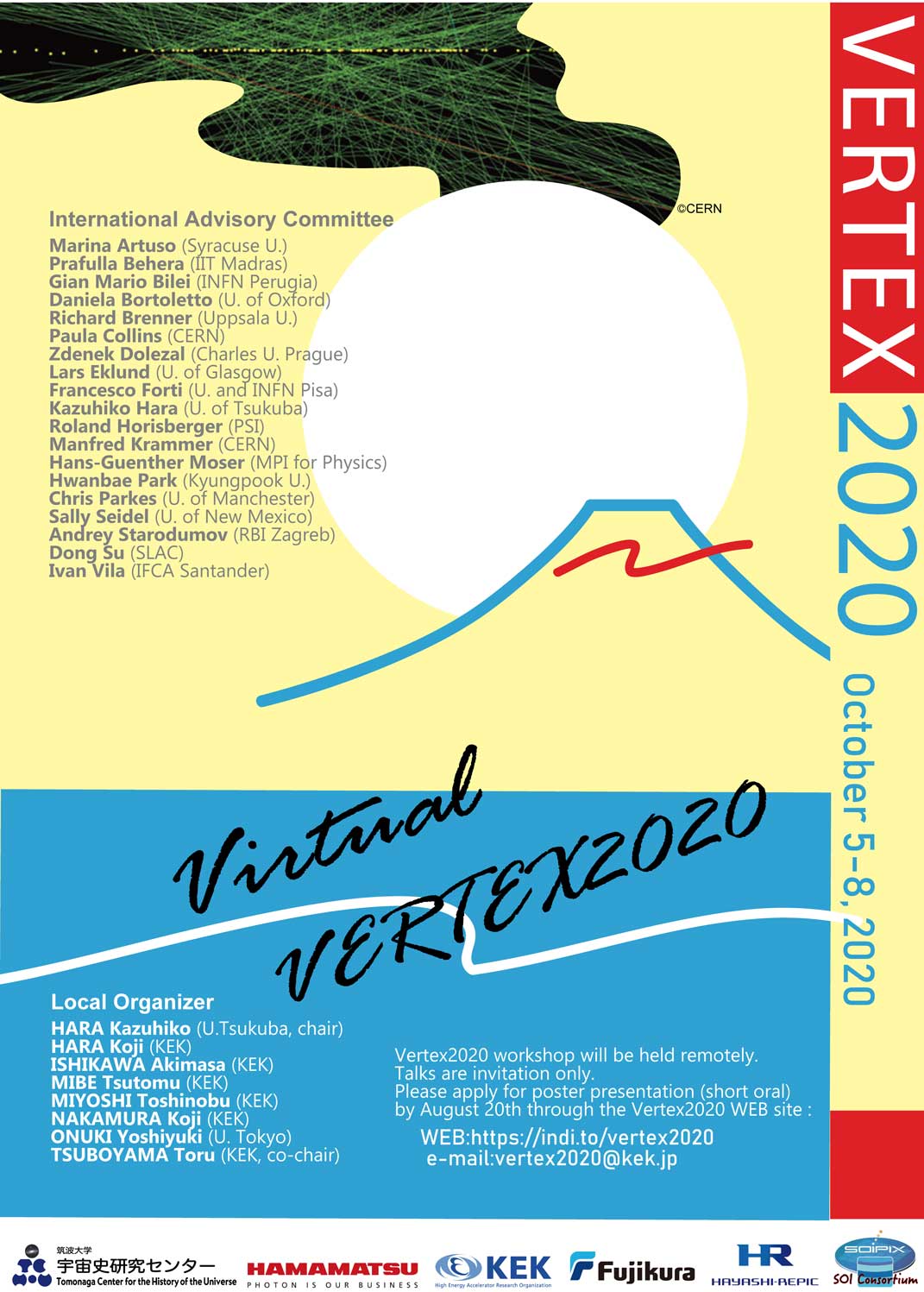


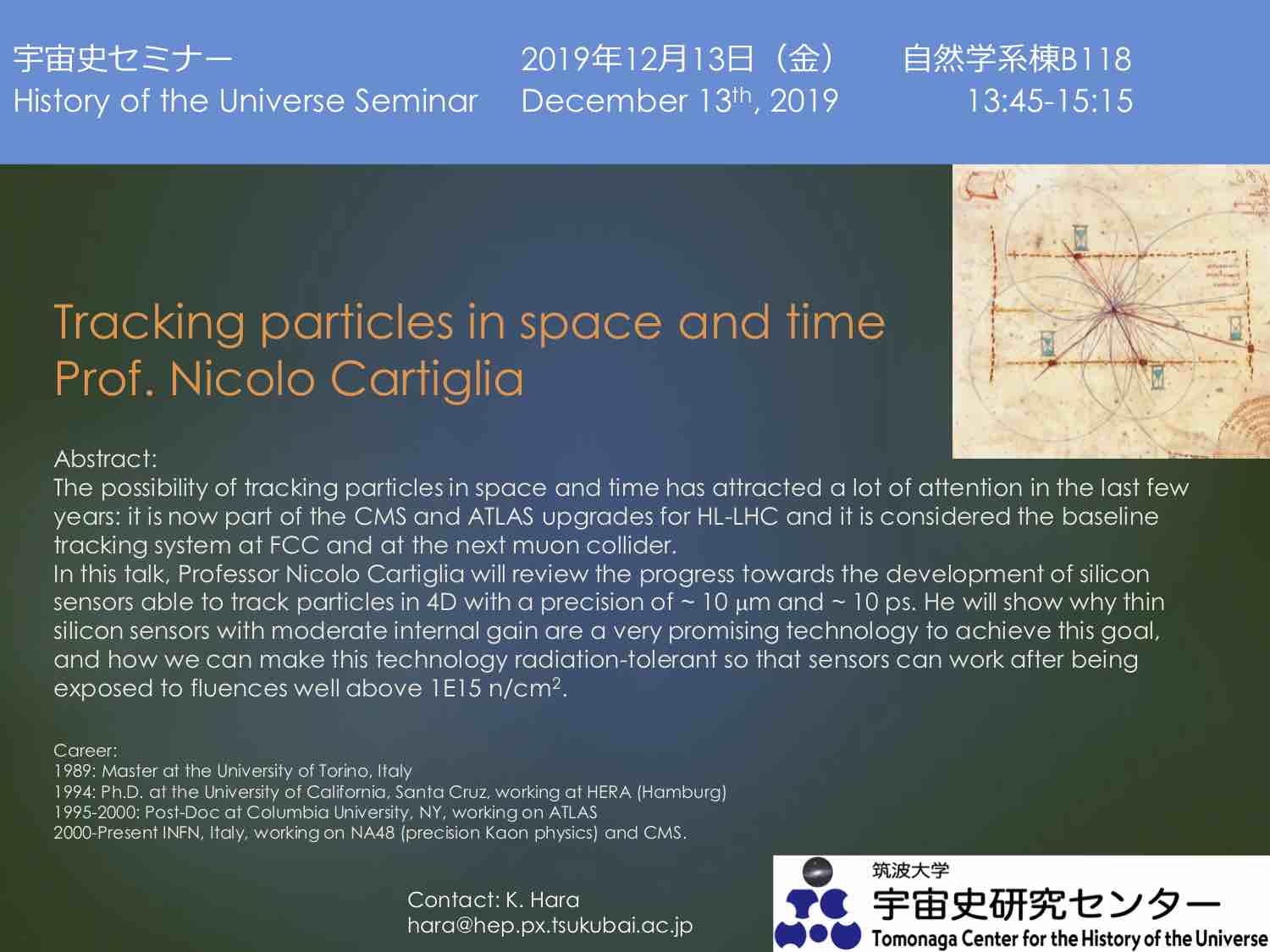
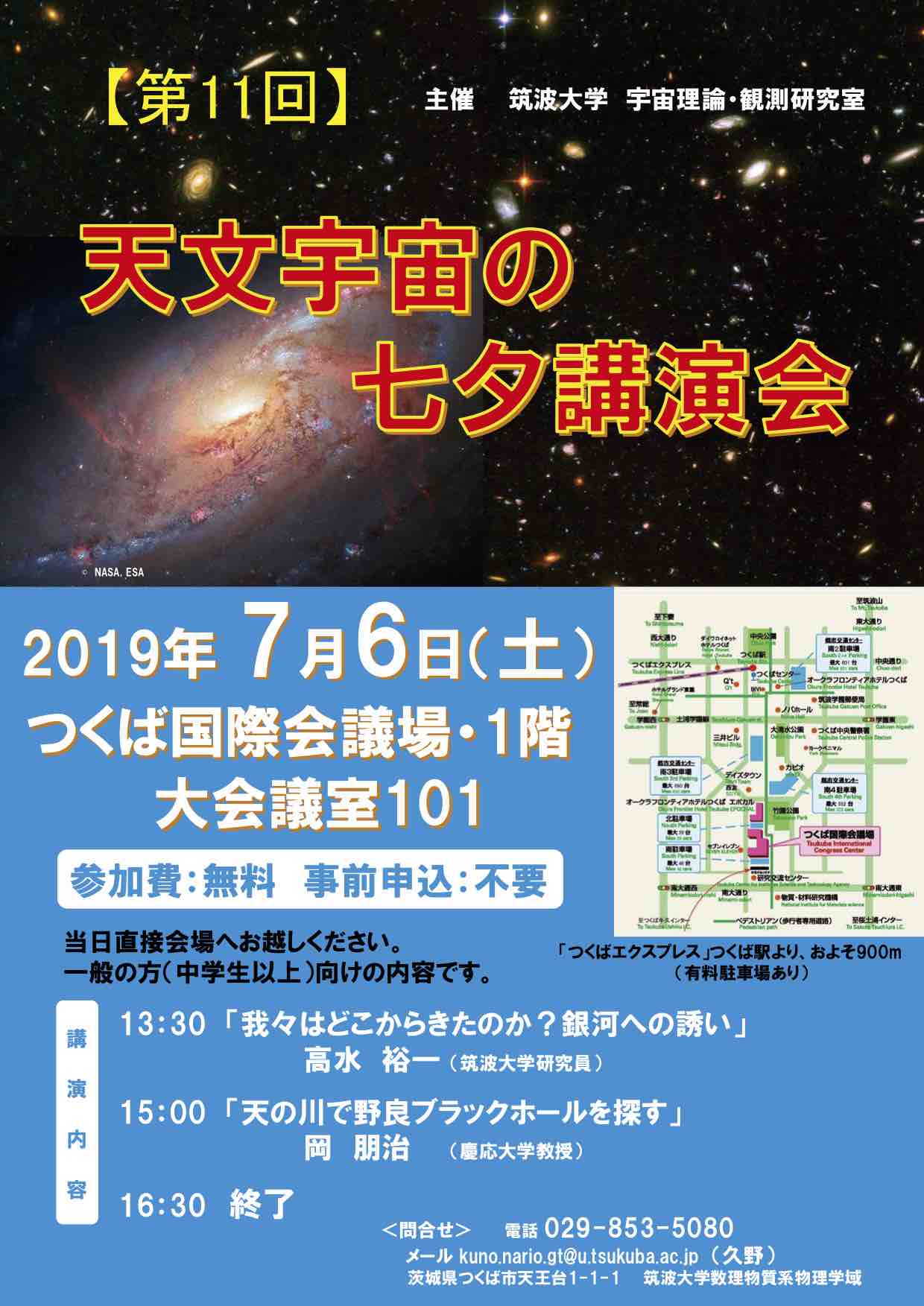
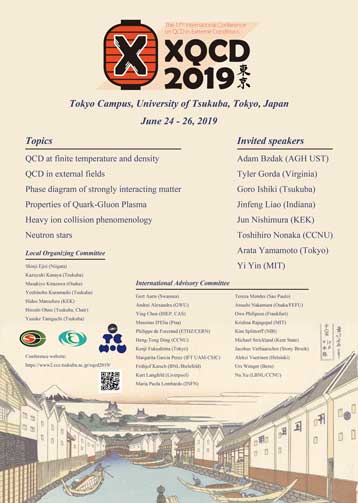


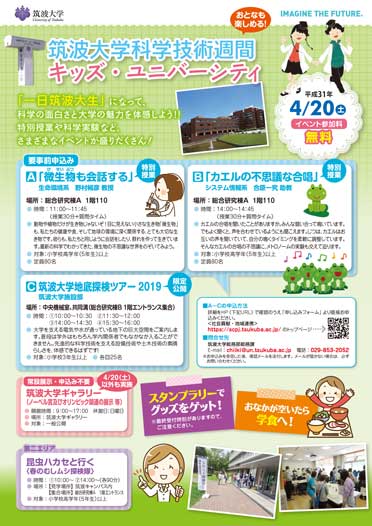
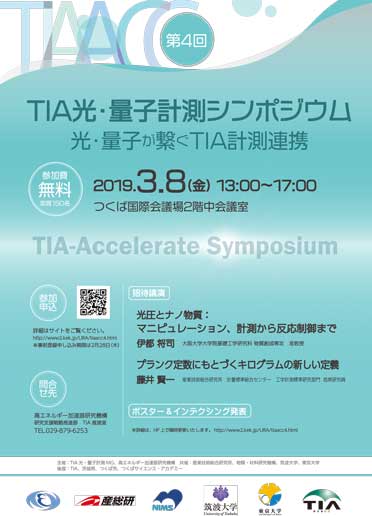
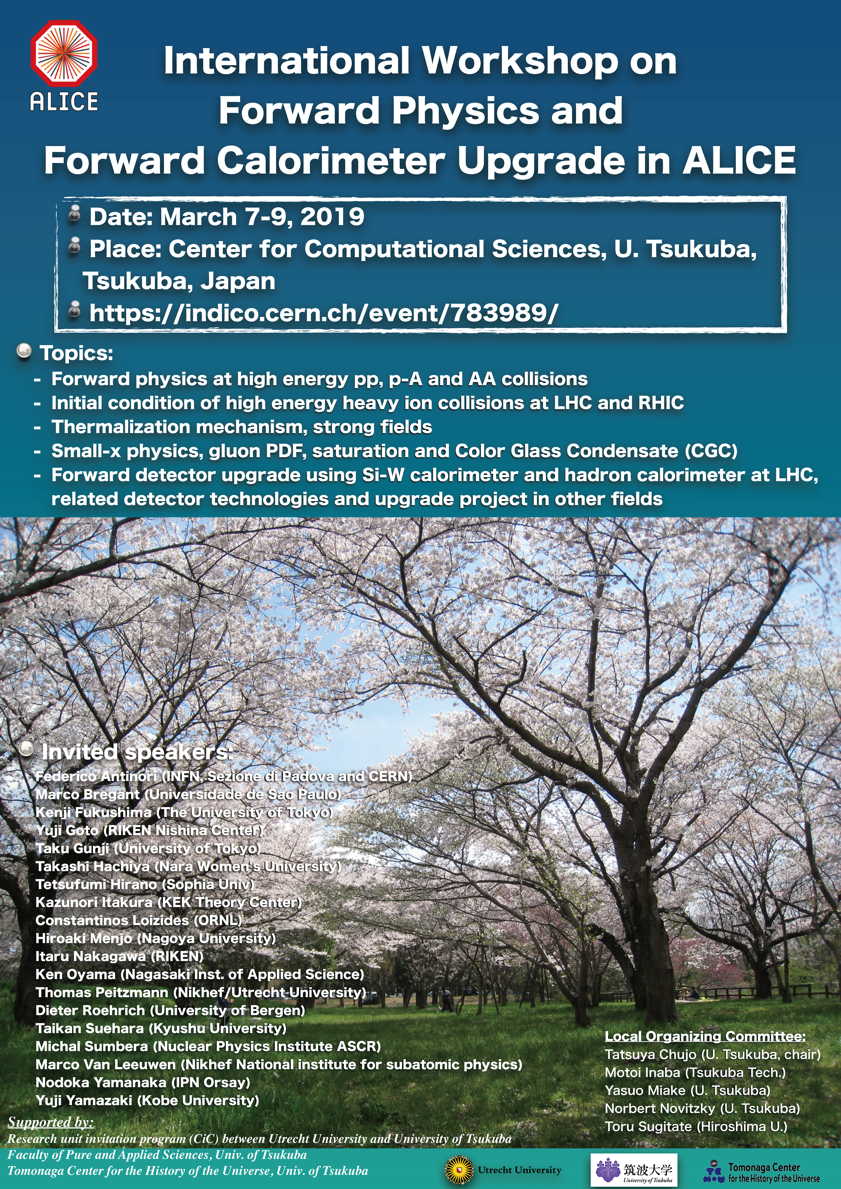
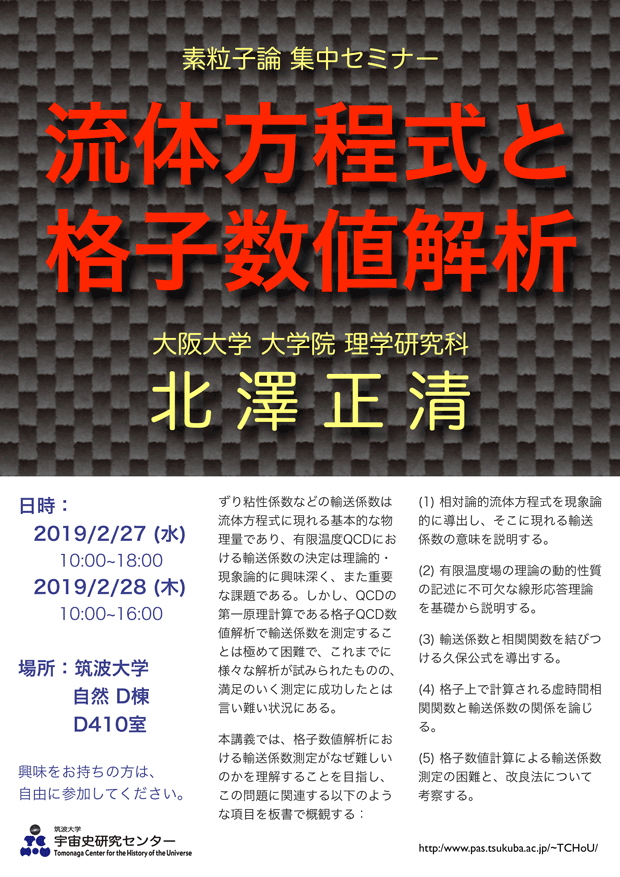
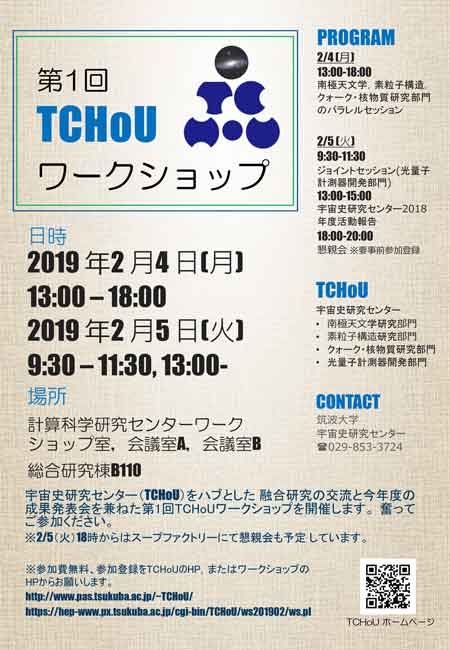
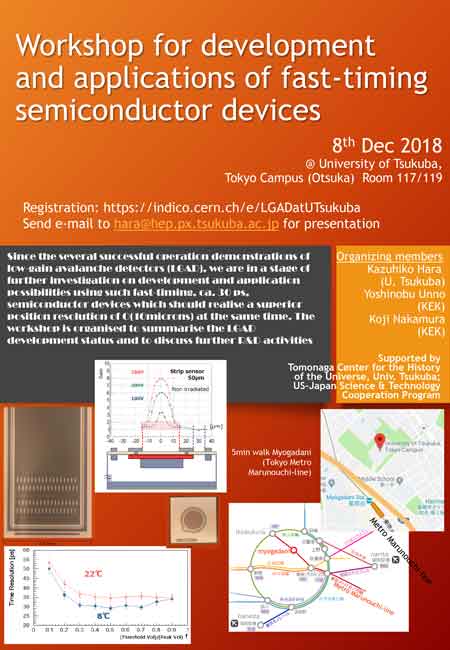
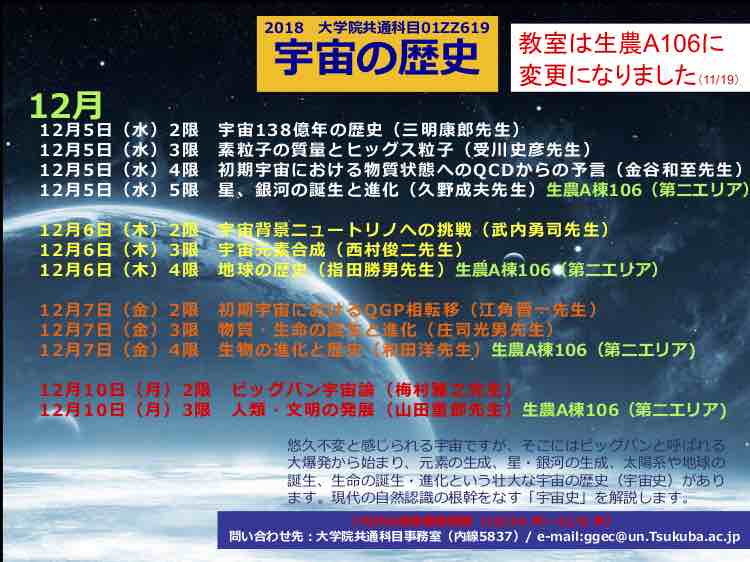
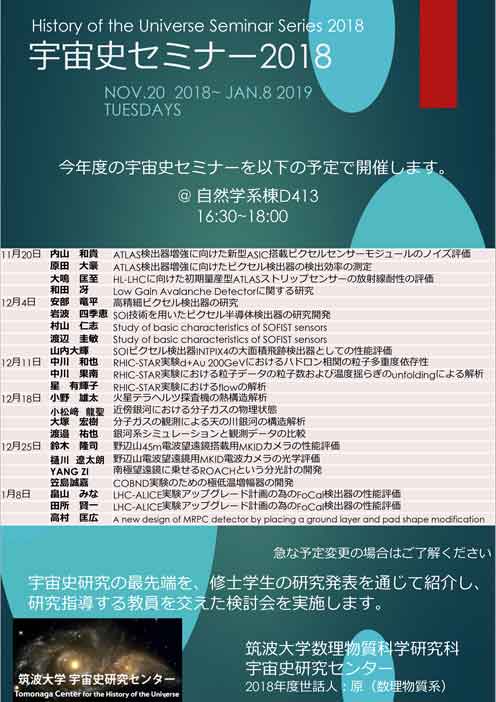

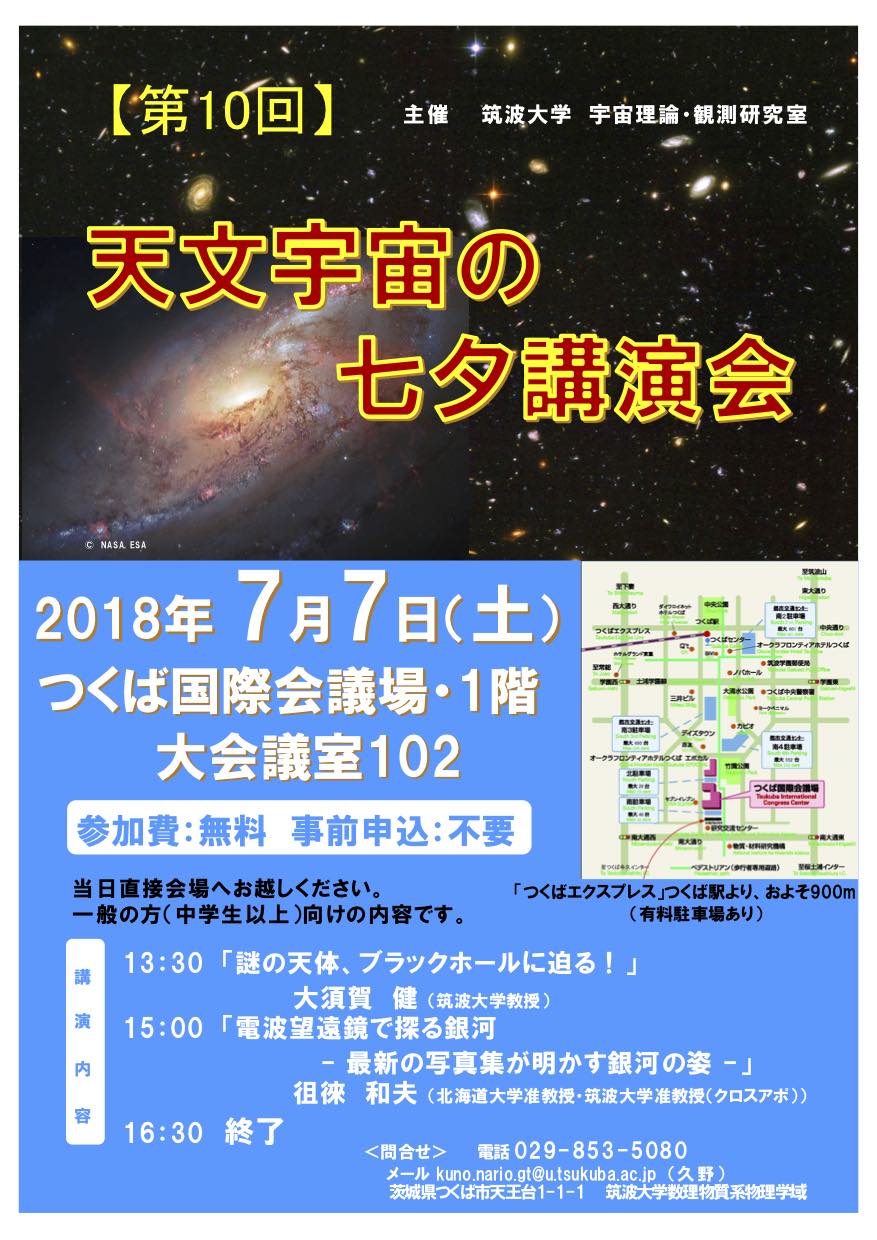

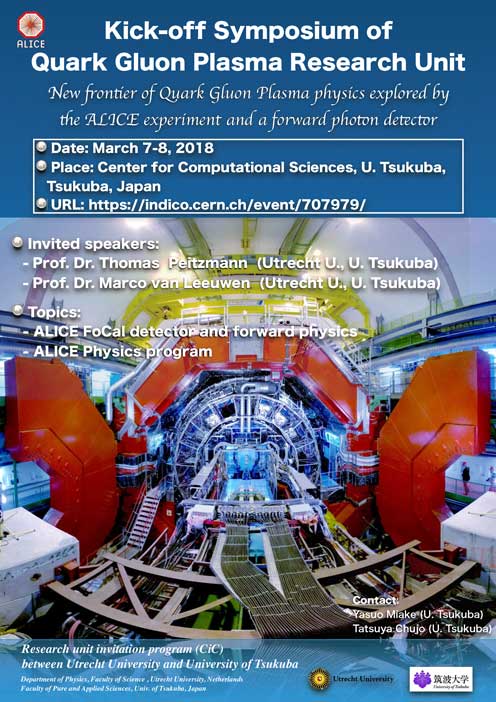
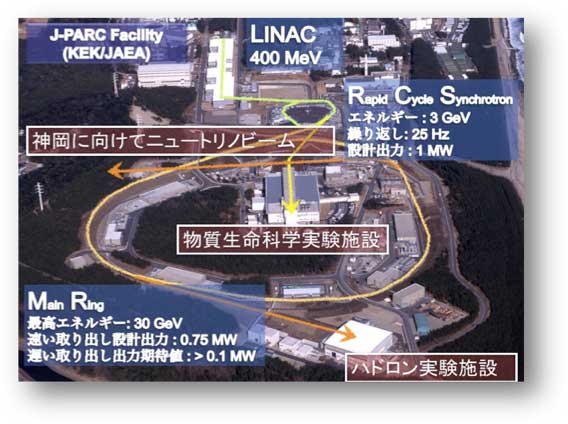
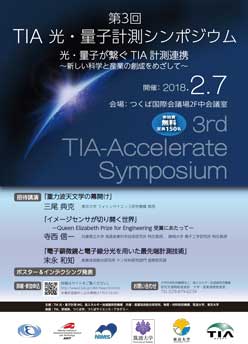

Job opportunities
- 2019/03/11 Tenure-track Associate/Assistant Professor position based on the LEADER program
Tomonaga Center for the History of the Universe (TCHoU) has an opening of a staff member position for Tenure-track Associate Professor or Tenure-track Assistant Professor, based on the Leading Initiative for Excellent Young Researchers (LEADER) program of MEXT.
We are inviting applications of young researchers from a wide range of research fields on the History of the Universe -- covering from the genesis of the Universe to the origin of life -- to proceed integrated studies on the History of the Universe and thus to enhance the function of TCHoU as an international hub of these studies.
The research fields we expect include those towards discovery/clarification of new pronciples behind the particles and space-time structure, origin and evolution of matter and interaction, formation of the global geometry of the Universe and evolution of stars and galaxies, chemical evolution of the Universe and abiogenesis. We provide an environment which helps to carry out independent researches, but the successful applicant is required to belong to one of research divisions of TCHoU (Division of Elementary Particles, Division of Quark Nuclear Matters or Division of Antarctic Astronomy) and sumultaneously to a Department at the Faculty of Pure and Applied Sciences (Department of Physics, Department of Chemistry etc.) so that new interdisciplinary collaborations with researchers there may be promoted.
Visit our job-posting URL (in Japanese) or JREC-IN Portal D119030143 (in English) for details.
Note that the application must be made both to the MEXT LEADER program and to us.
- Application period of the MEXT LEADER program 2019: March 22 to April 24, 2019
- Deadline for "advanced notice" to us: May 20, 2019
The "advanced notice" is closed.
♣ Visit Center for Integrated Research in Fundamental Science and Engineering (CiRfSE) for older news and announcements.
♣ Visit the top page for the latest news and announcements.
